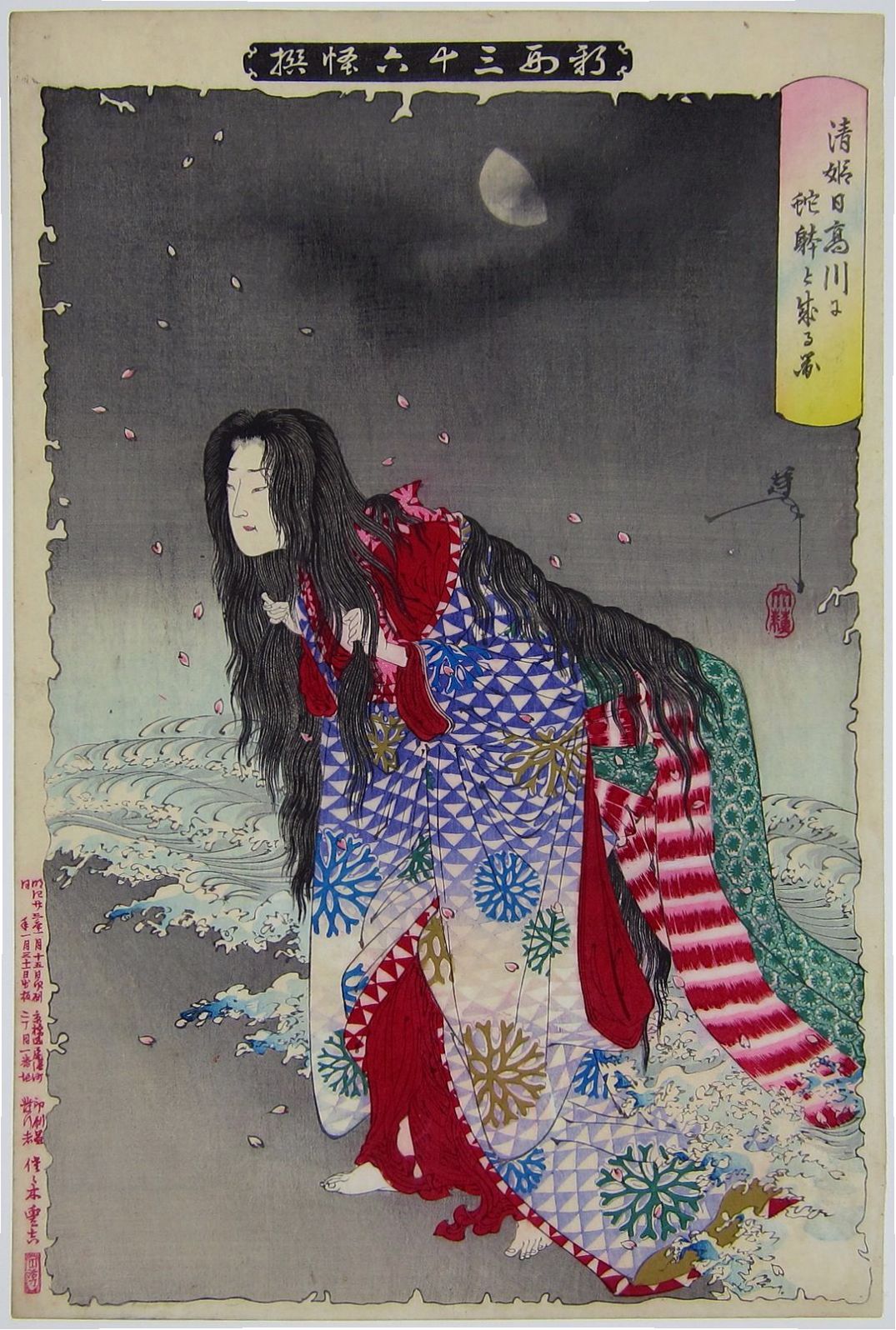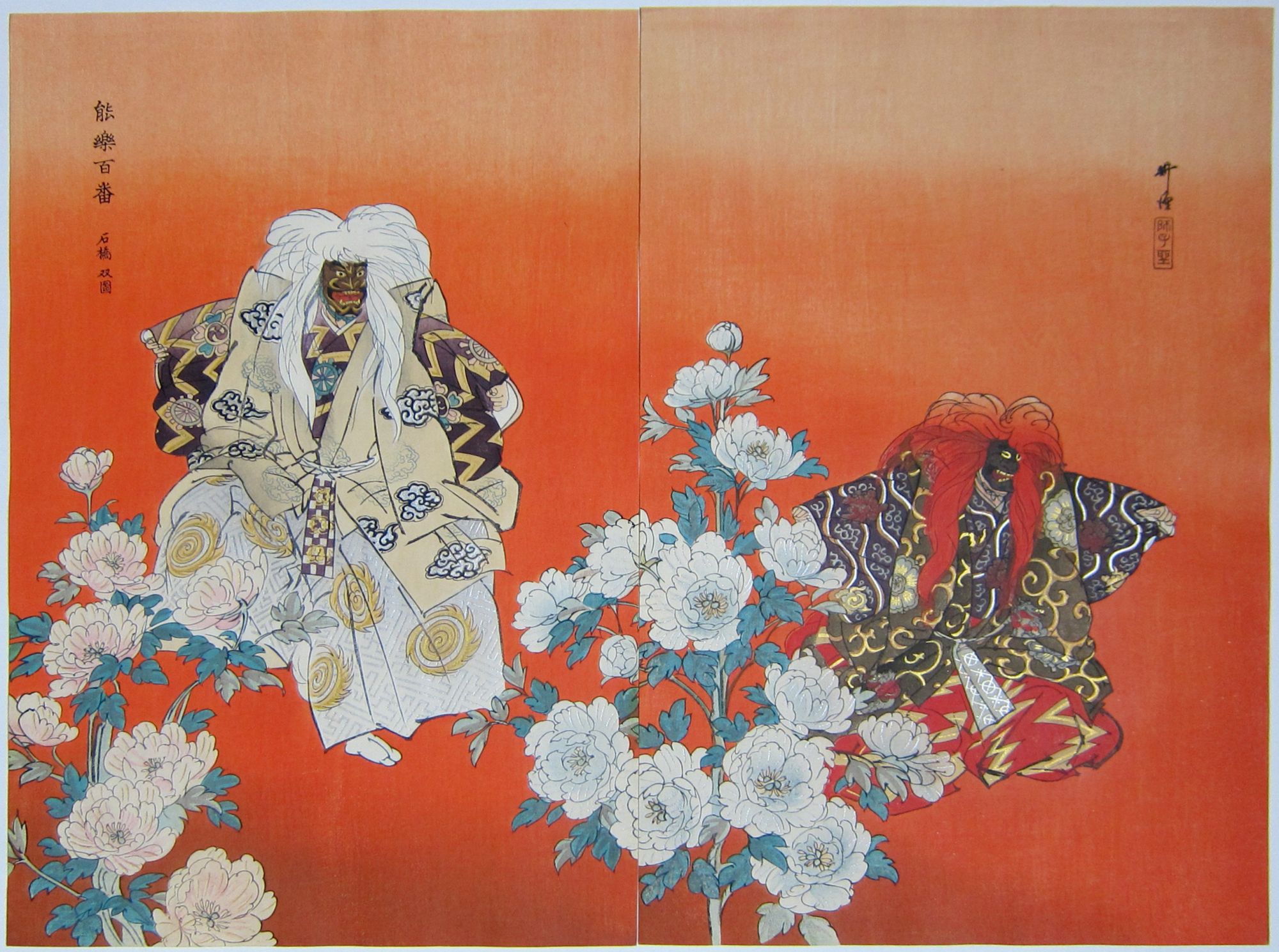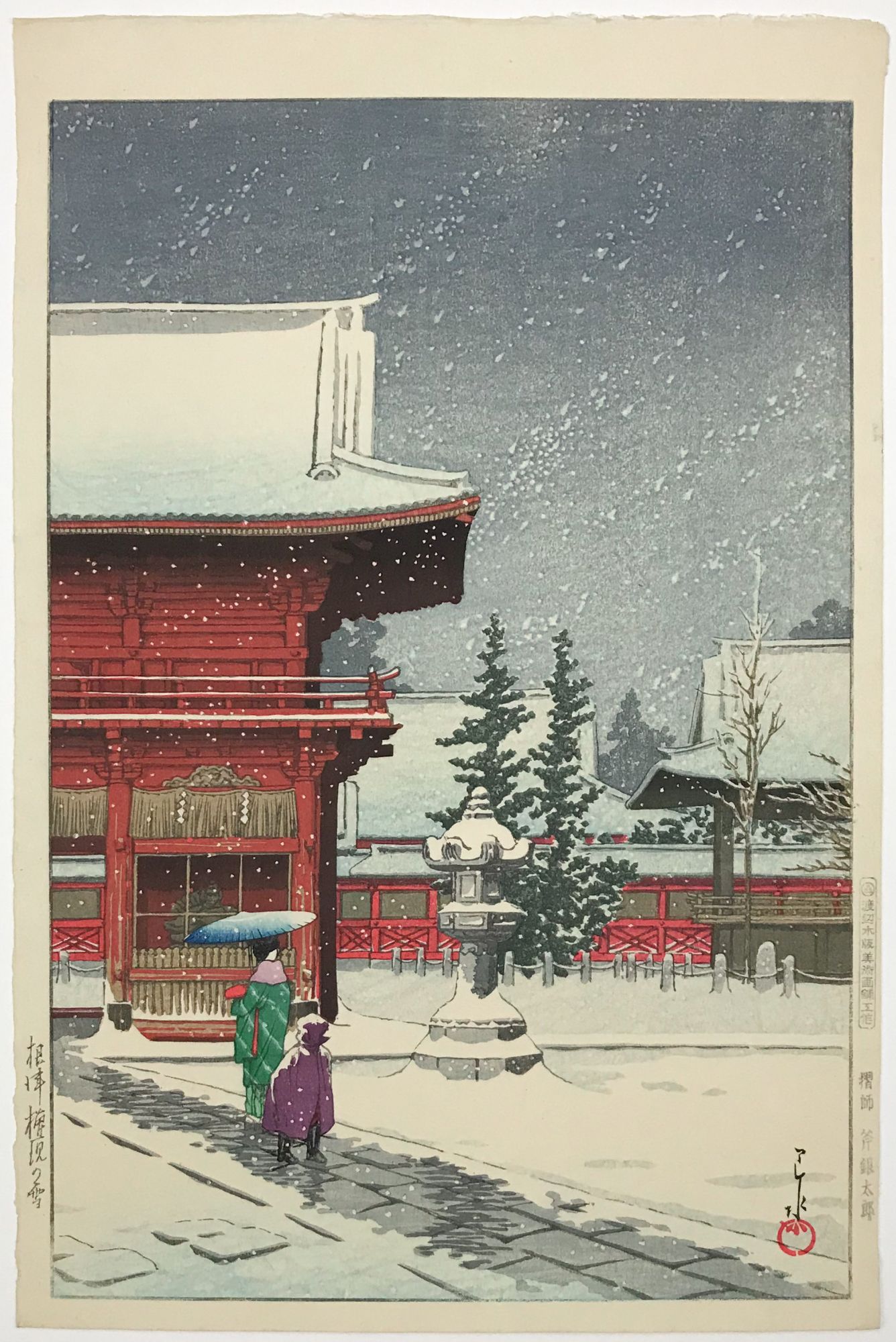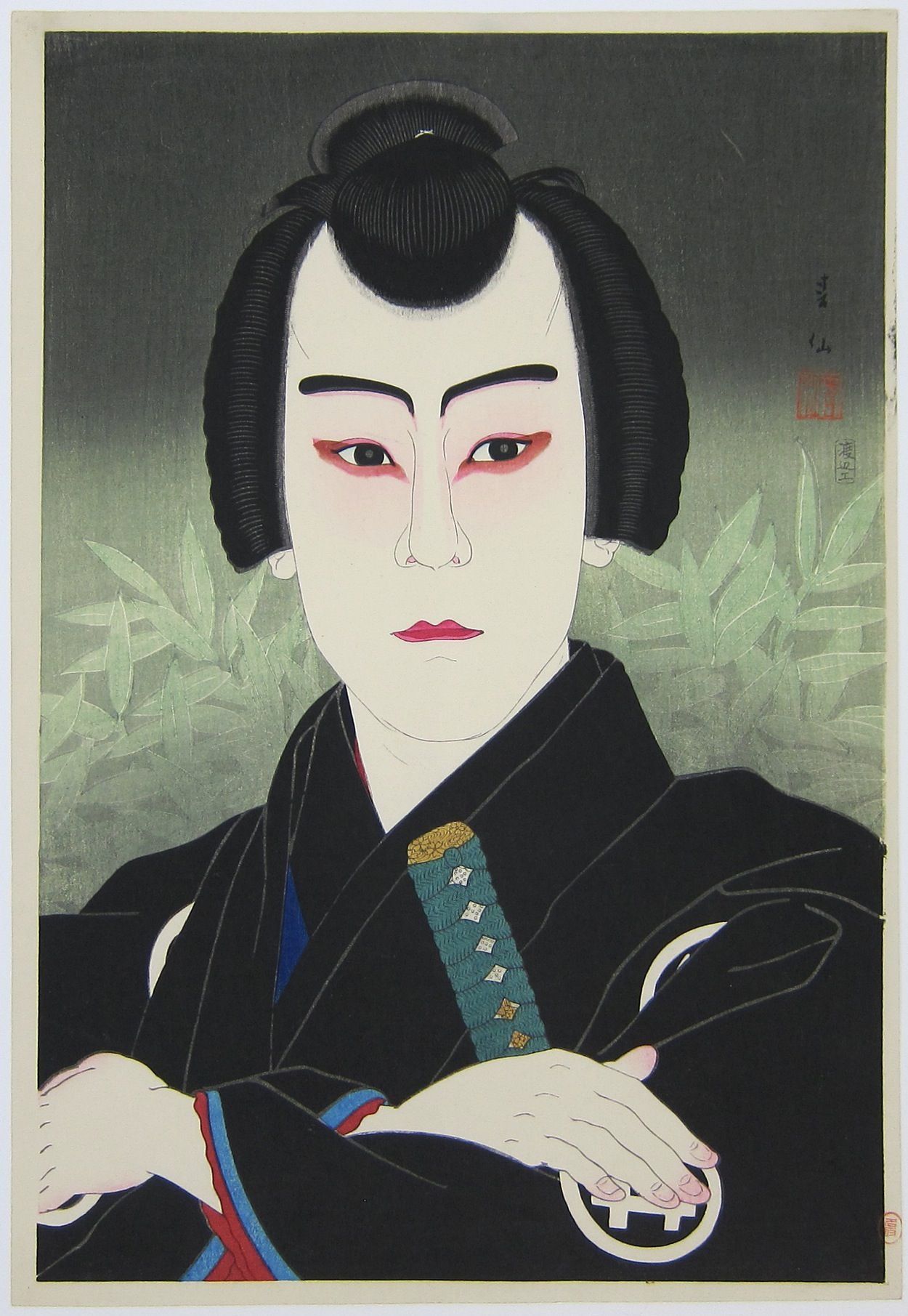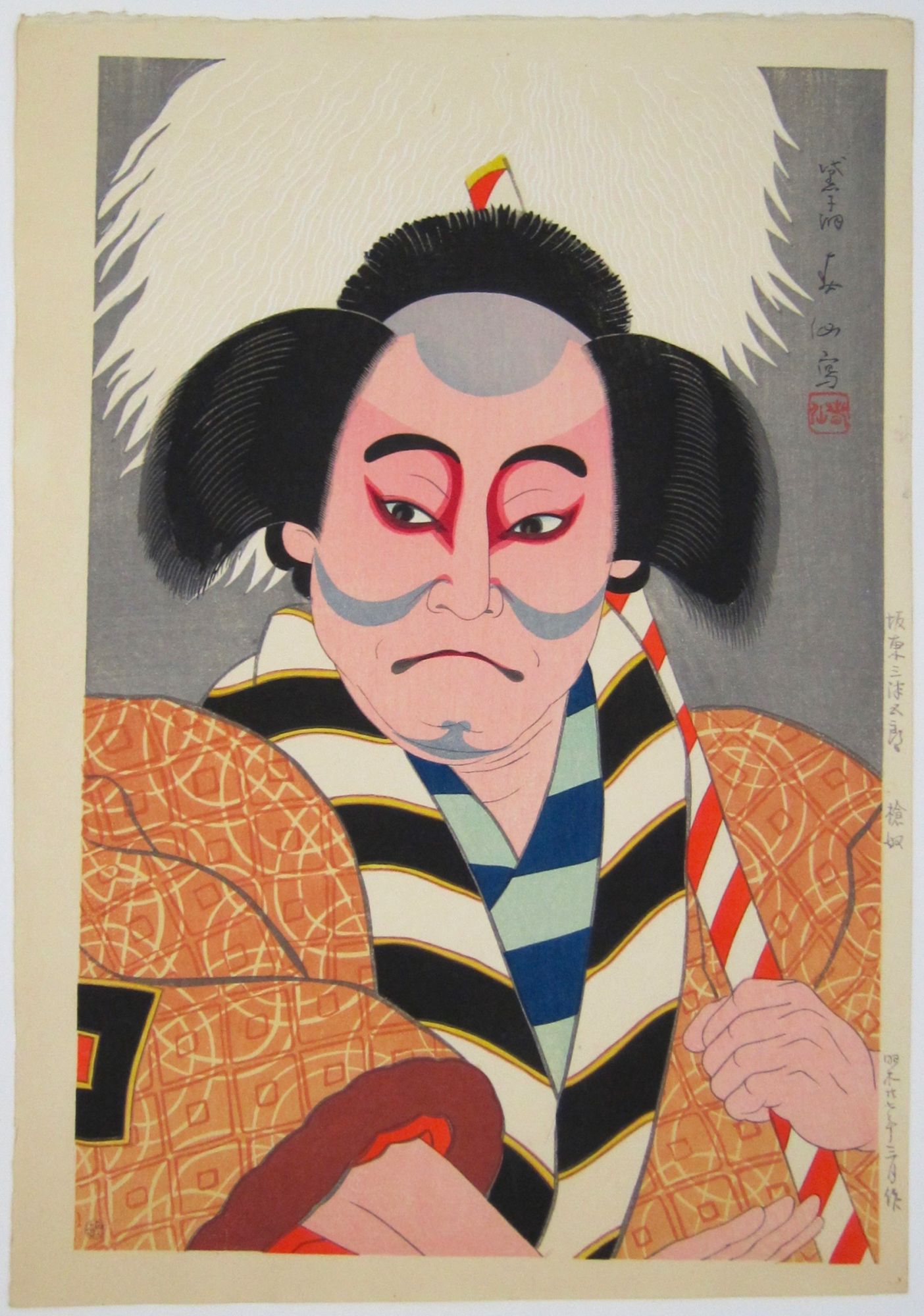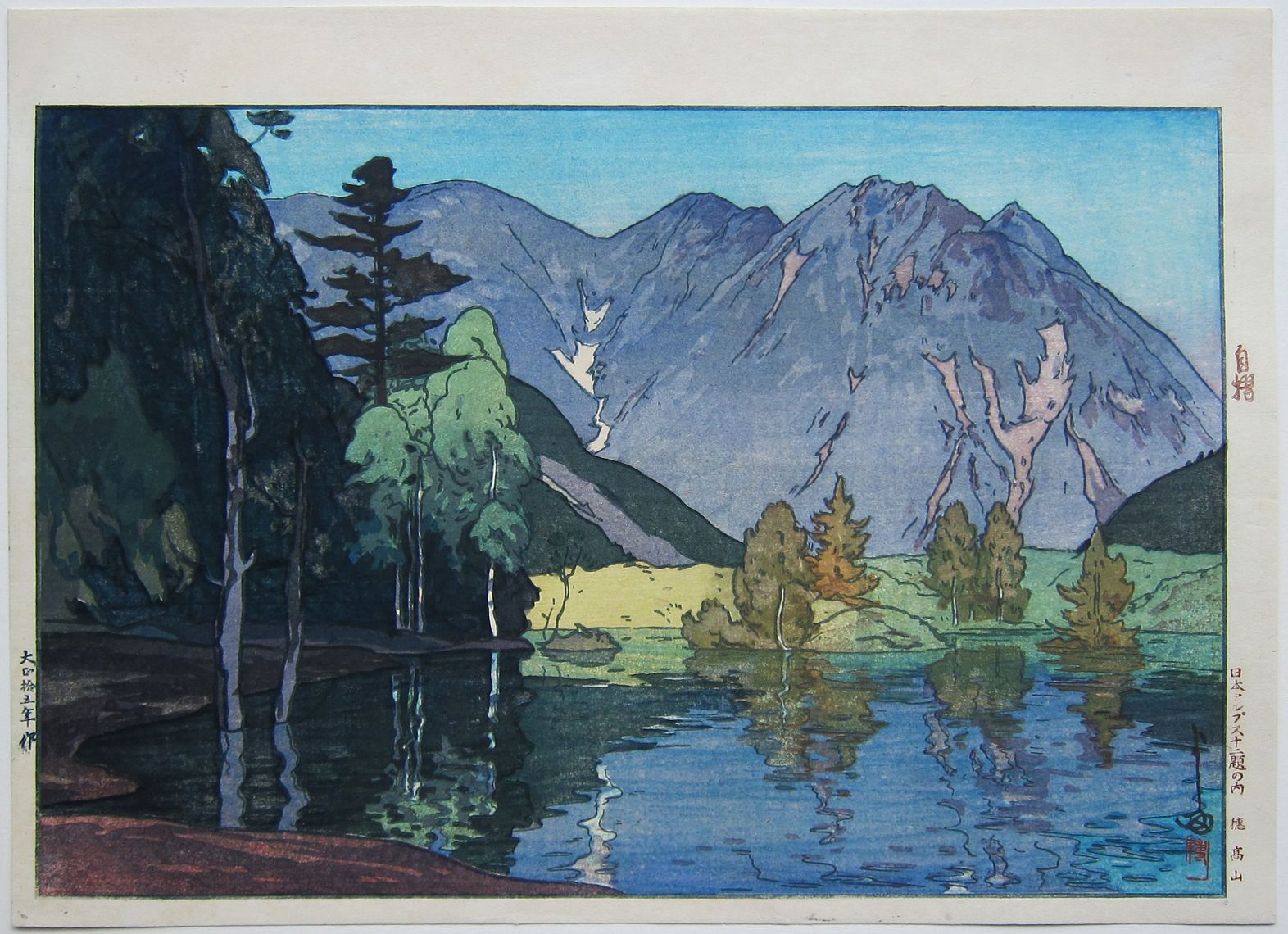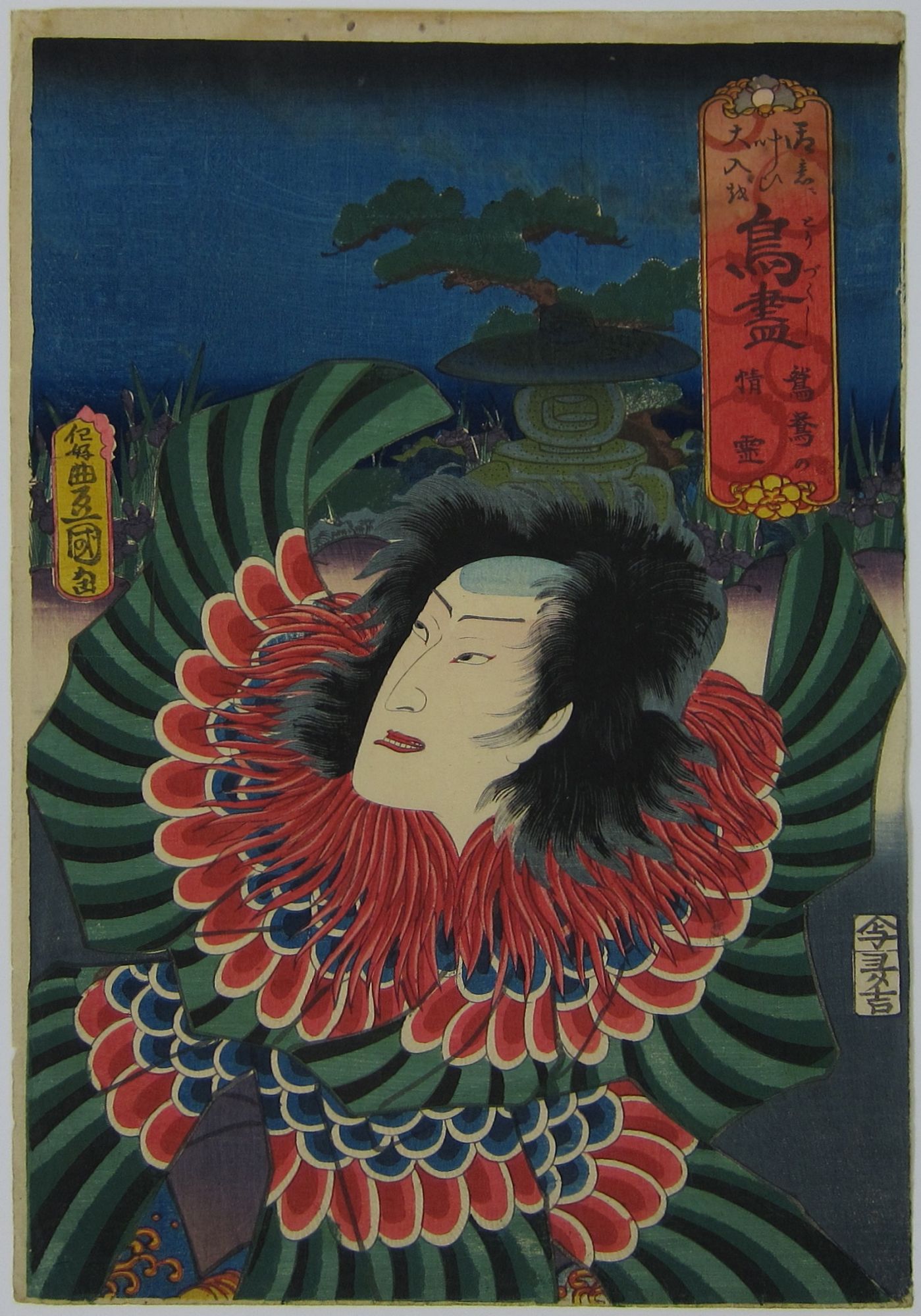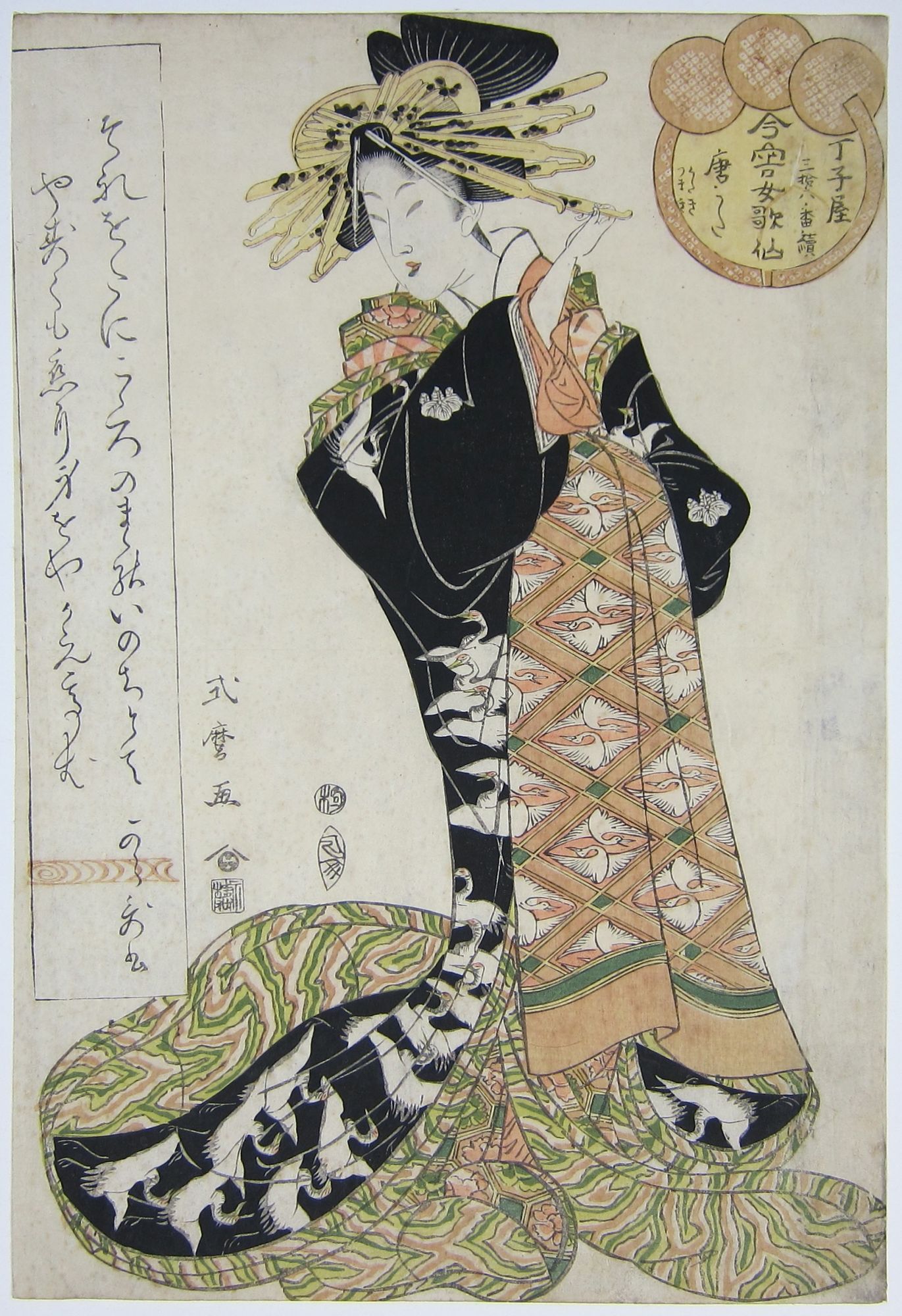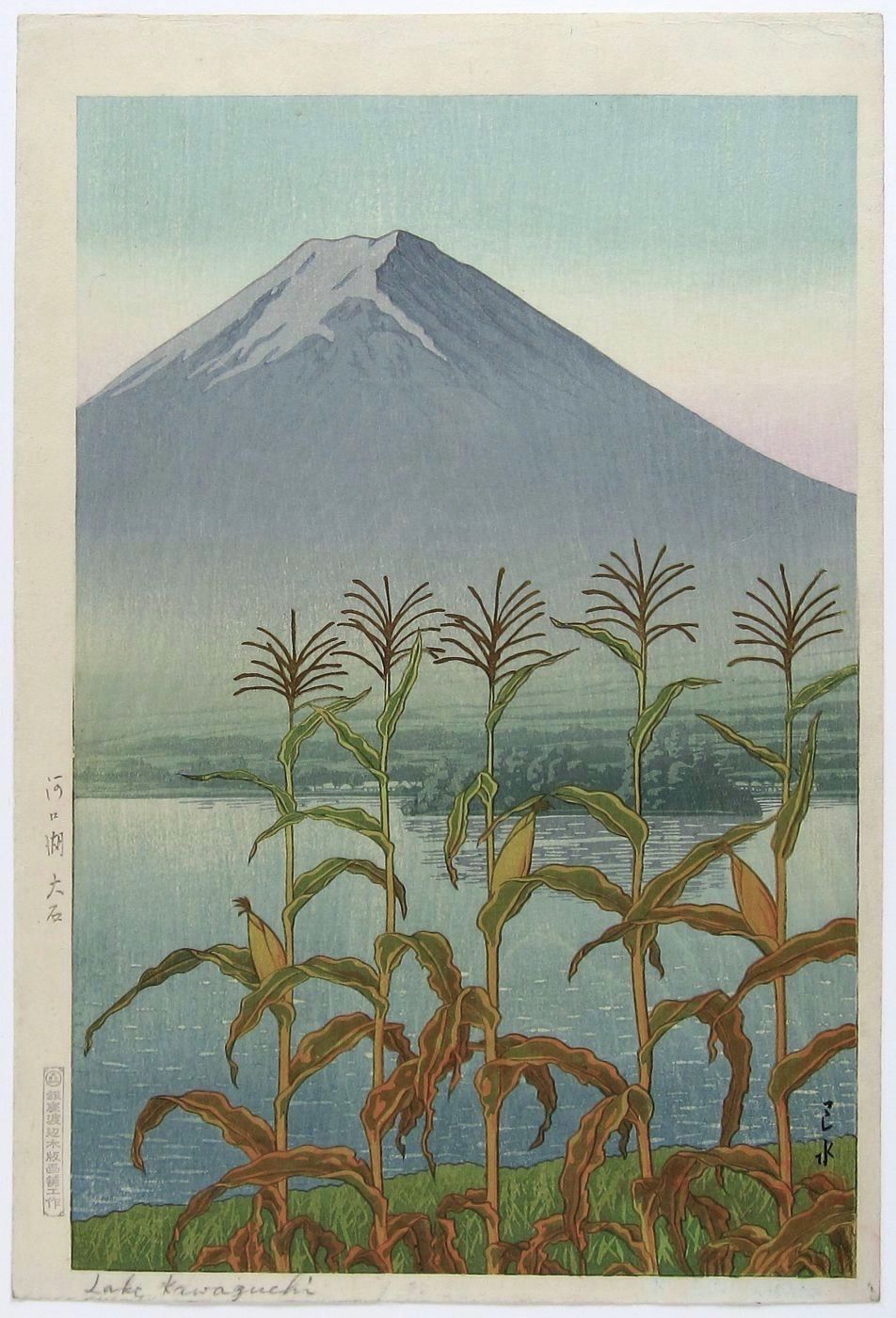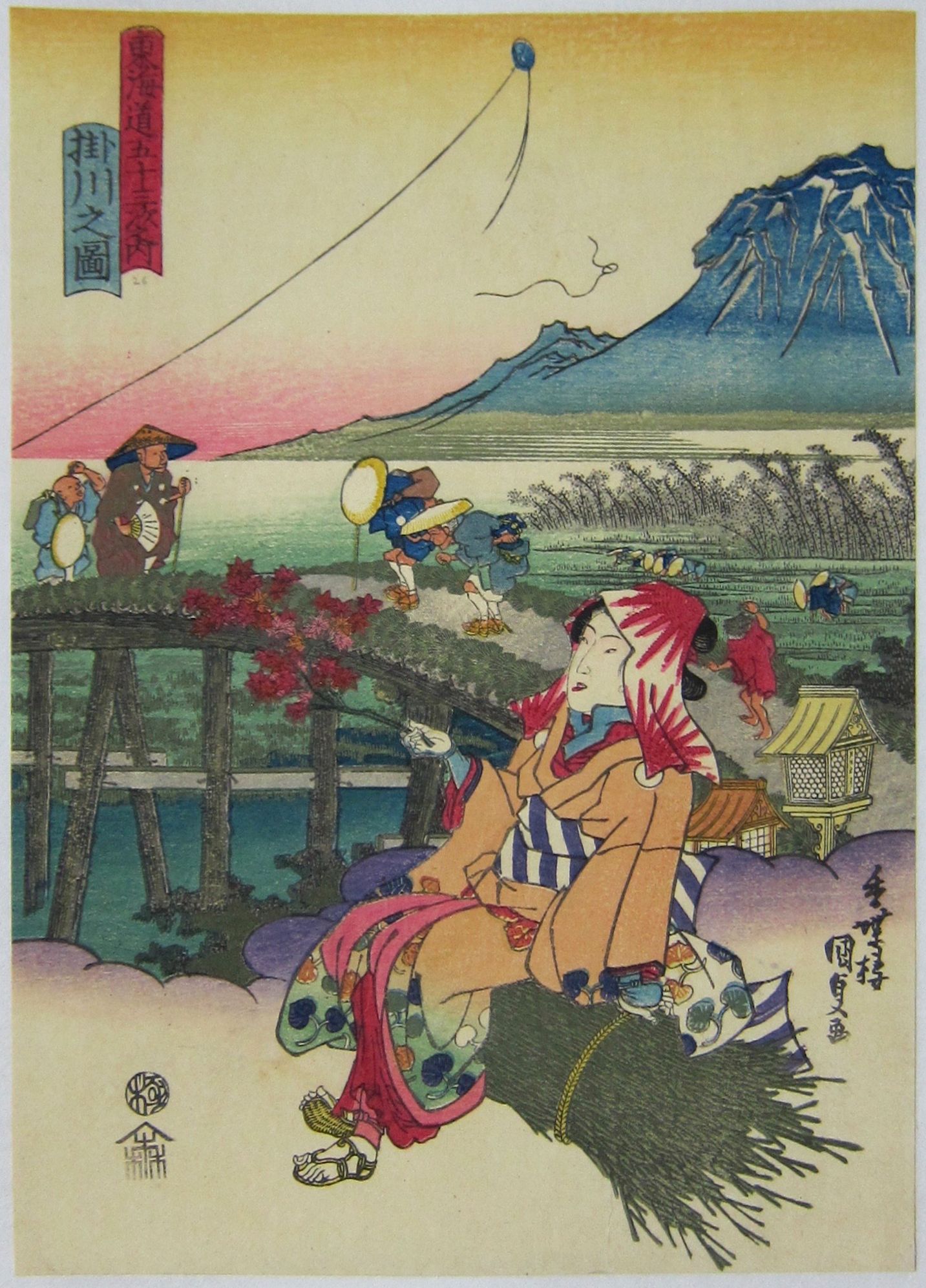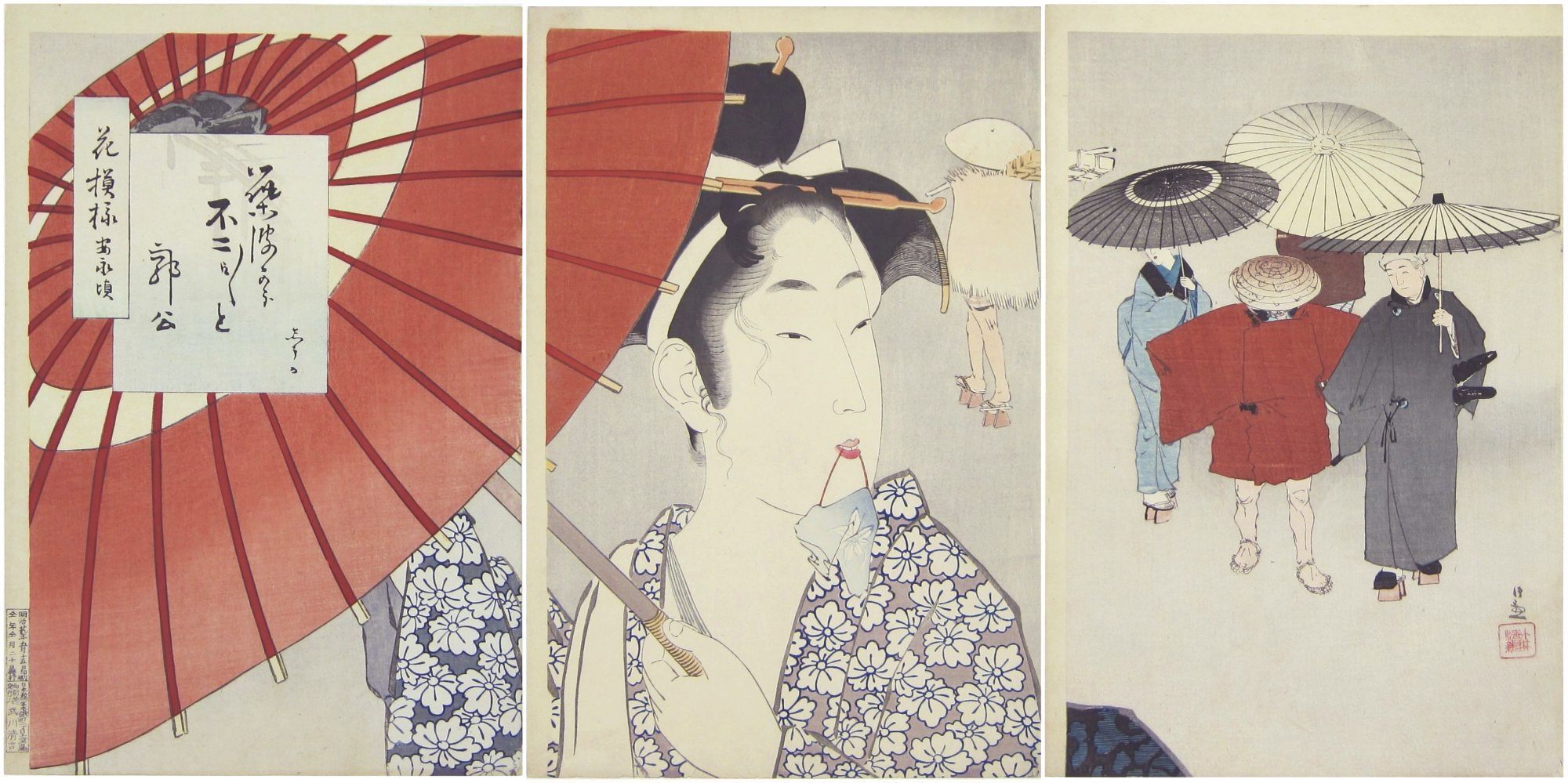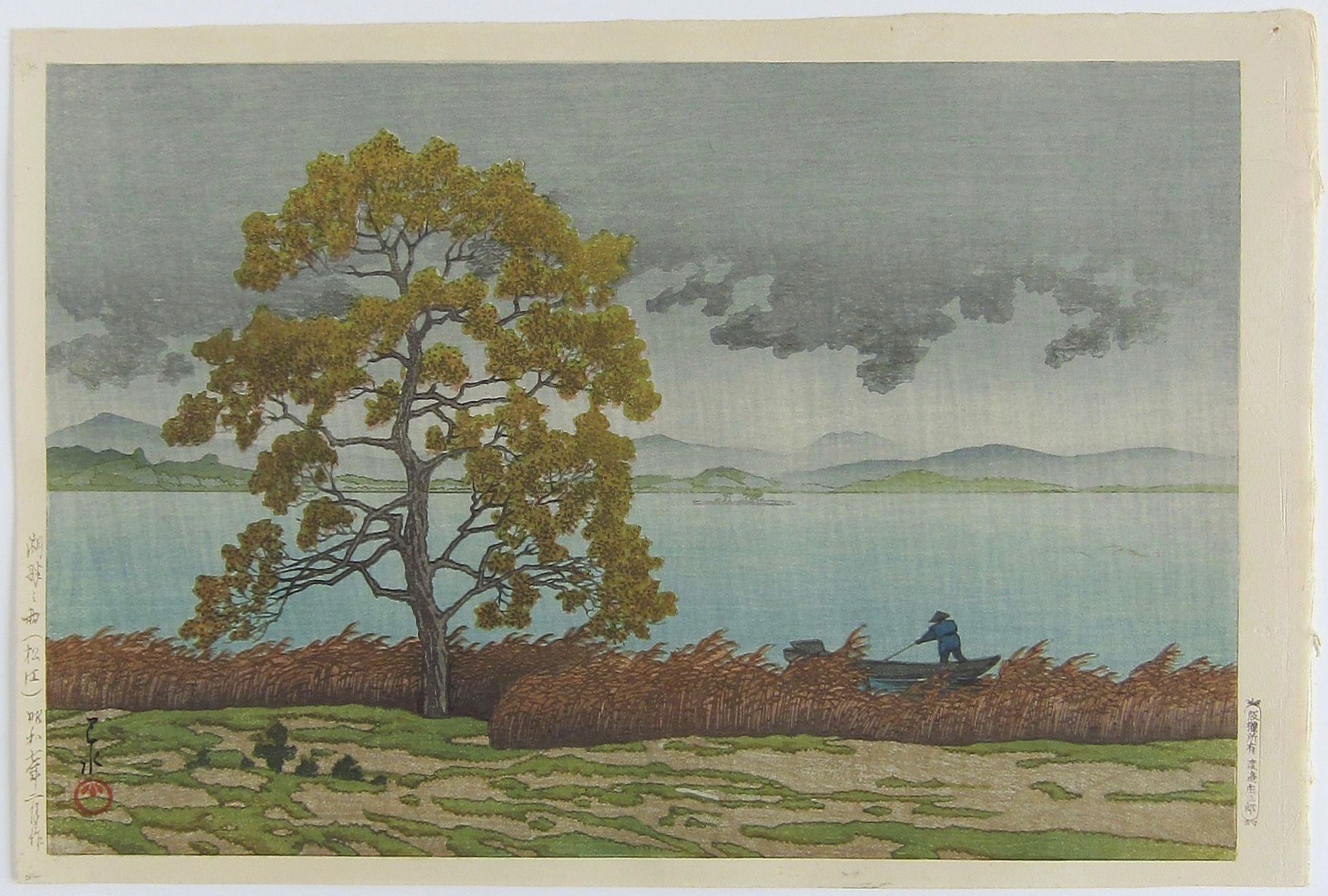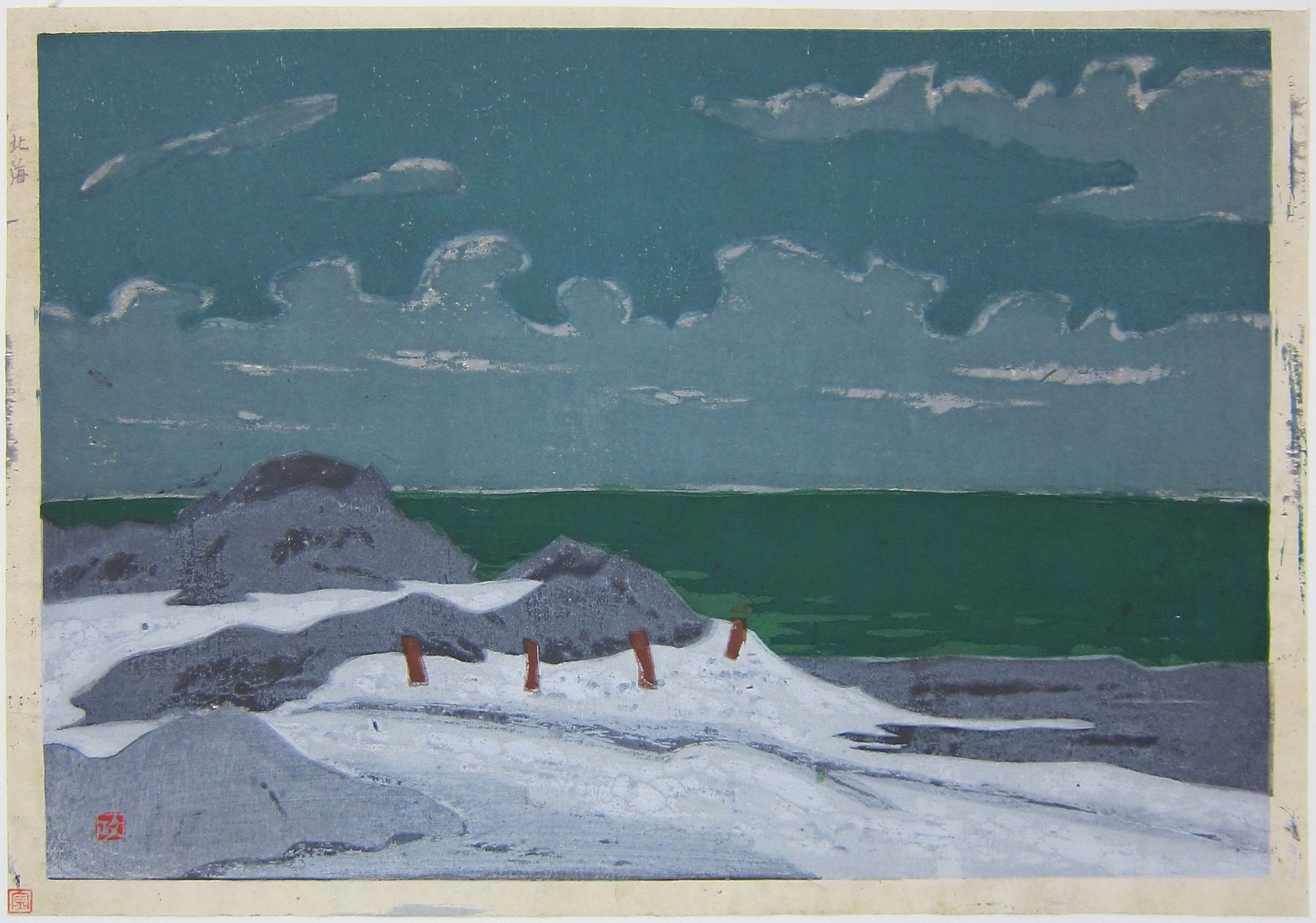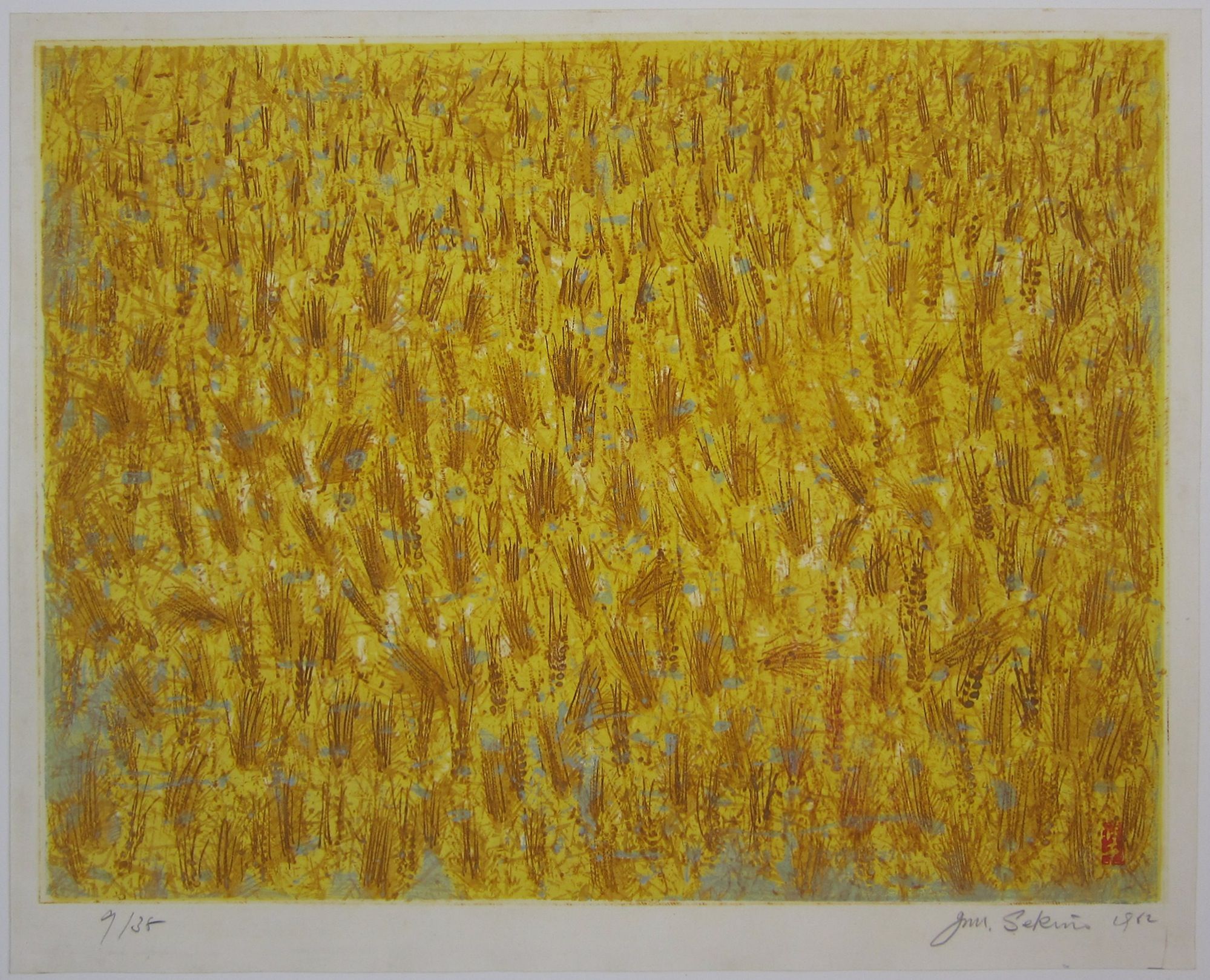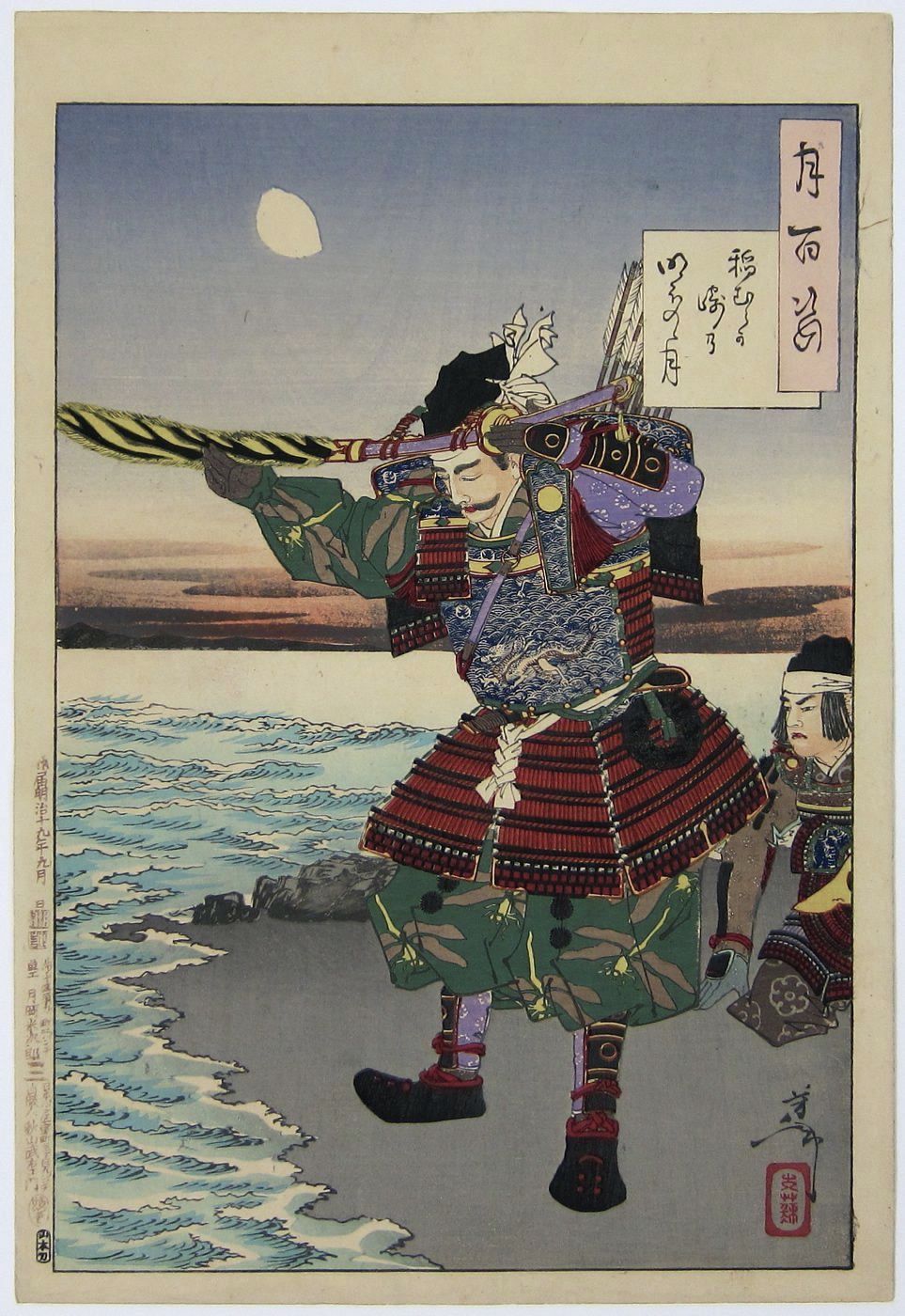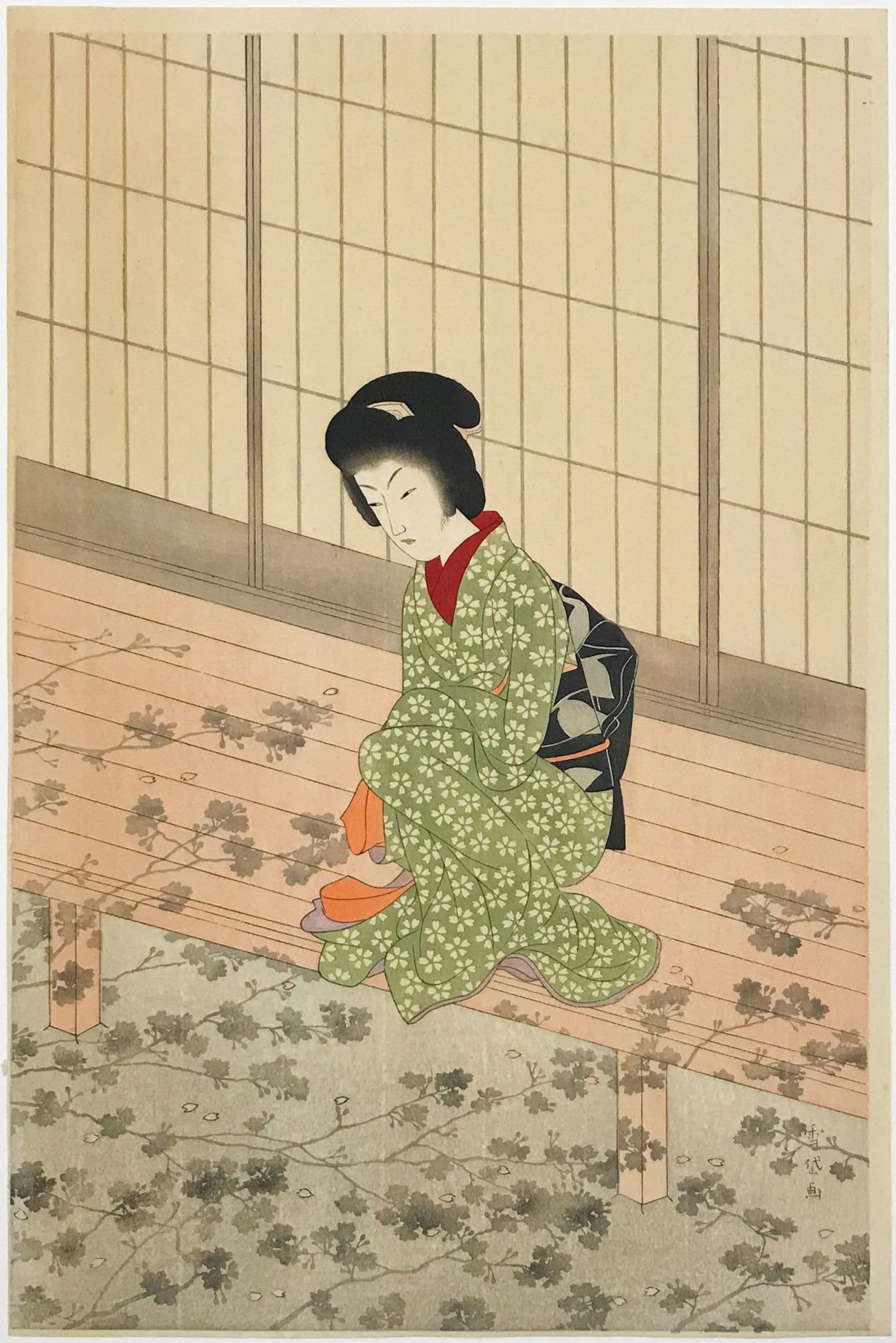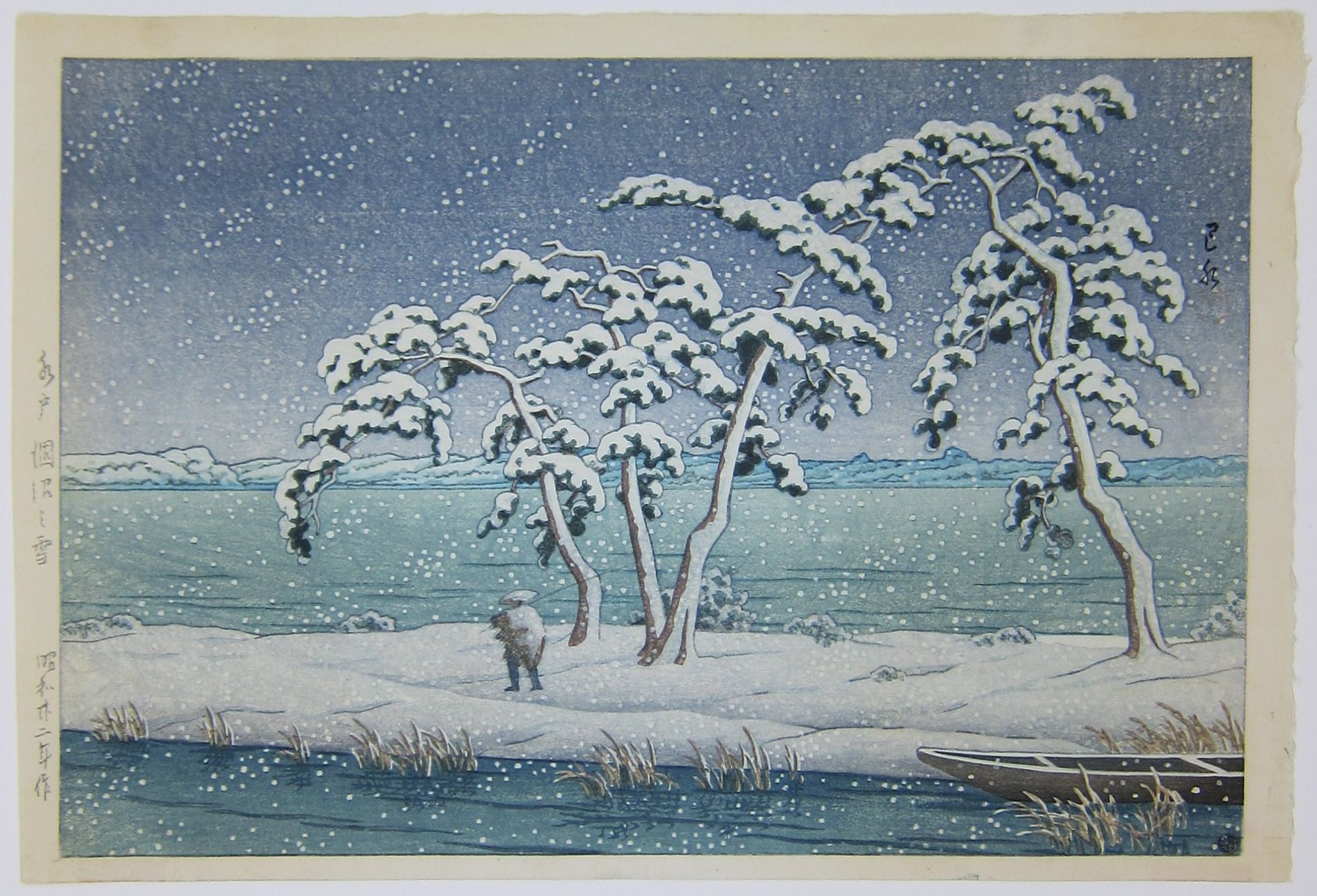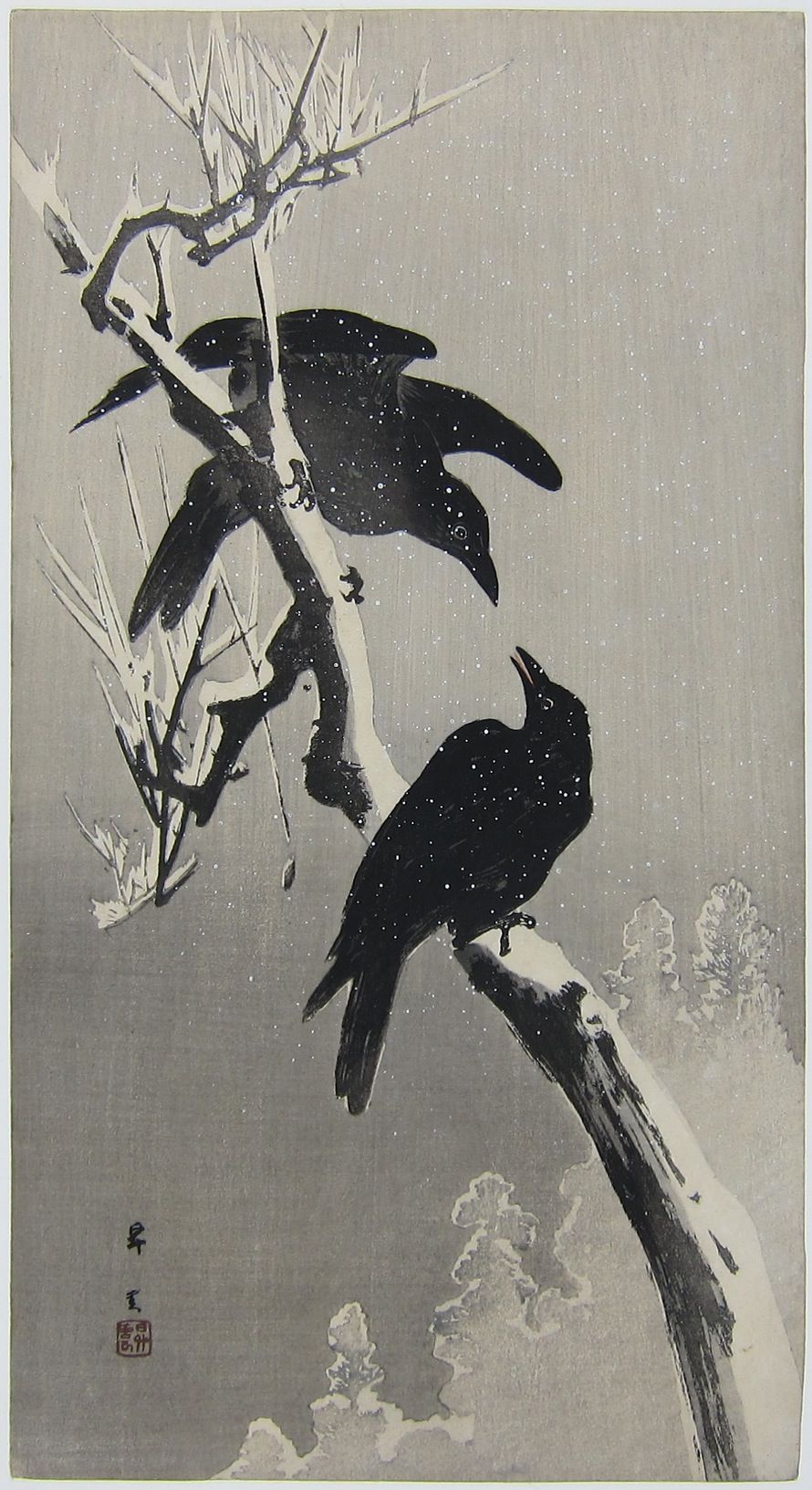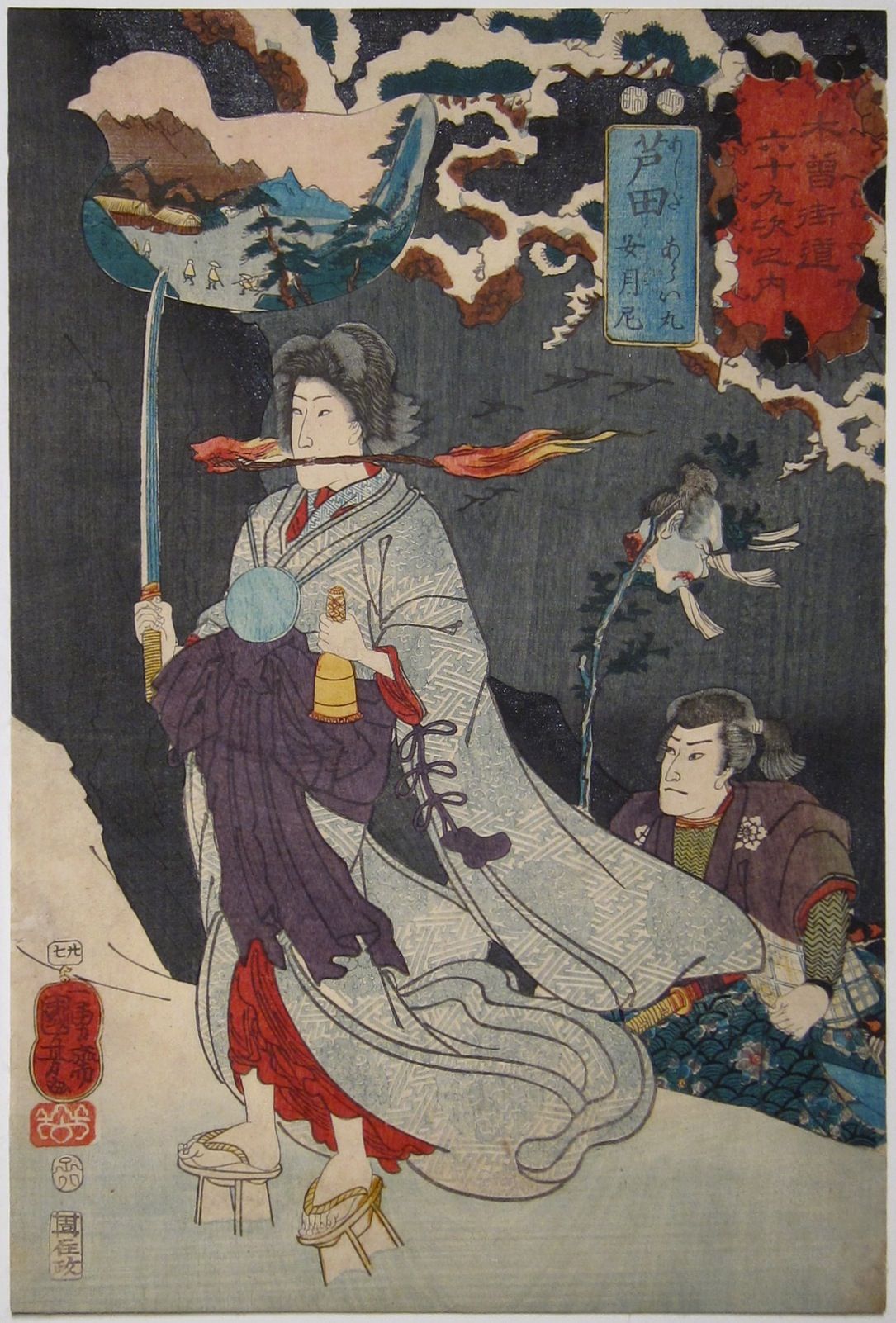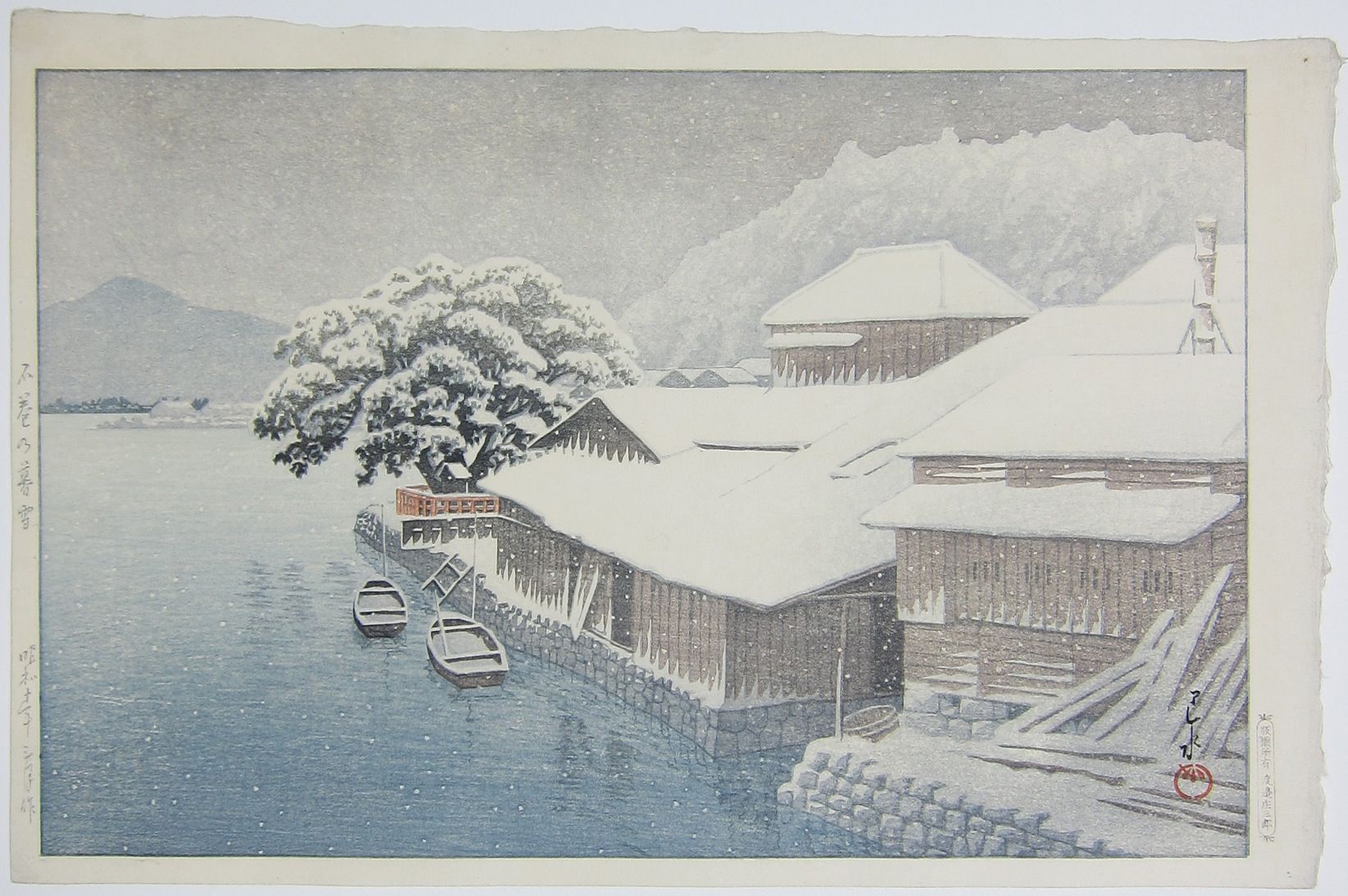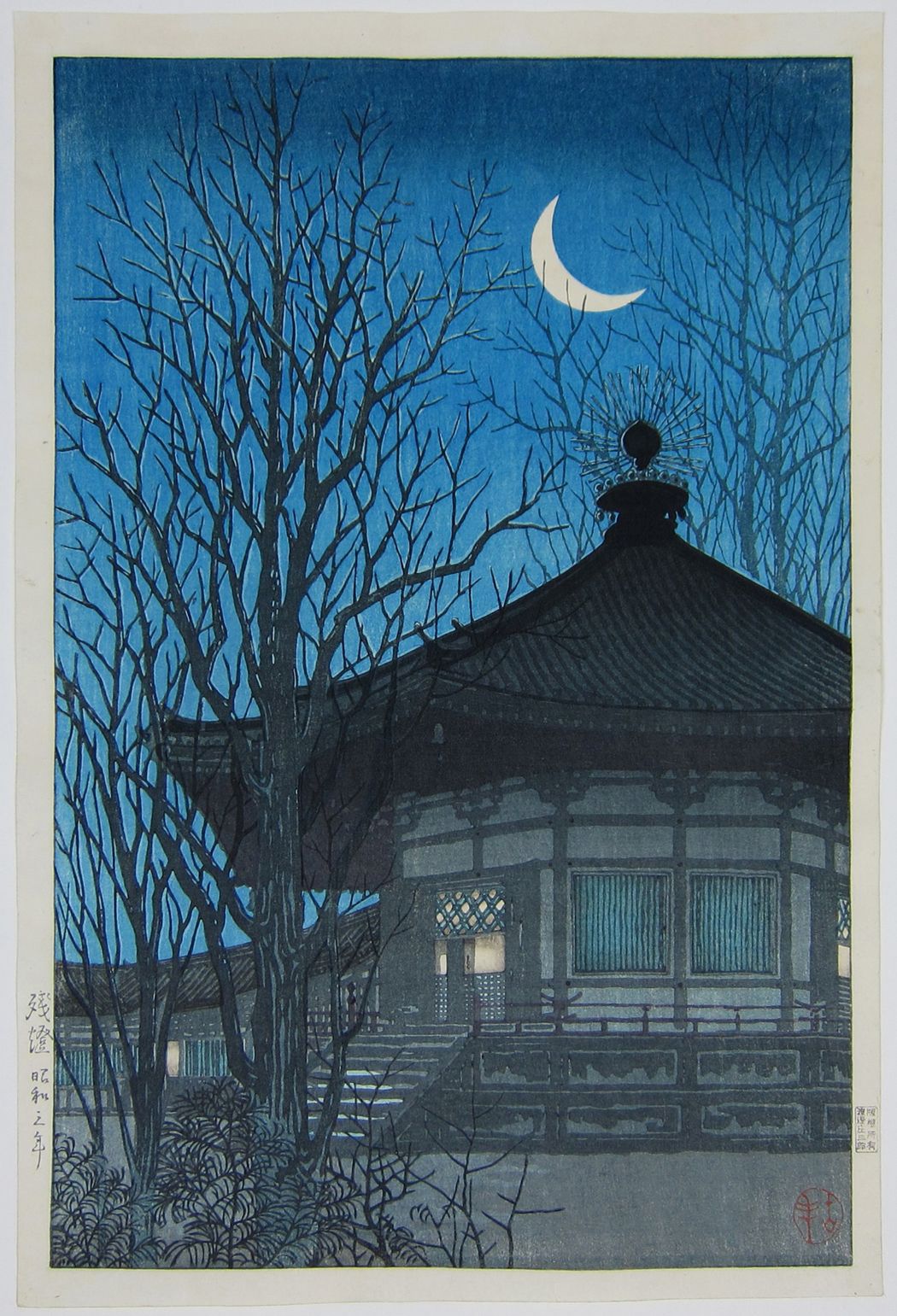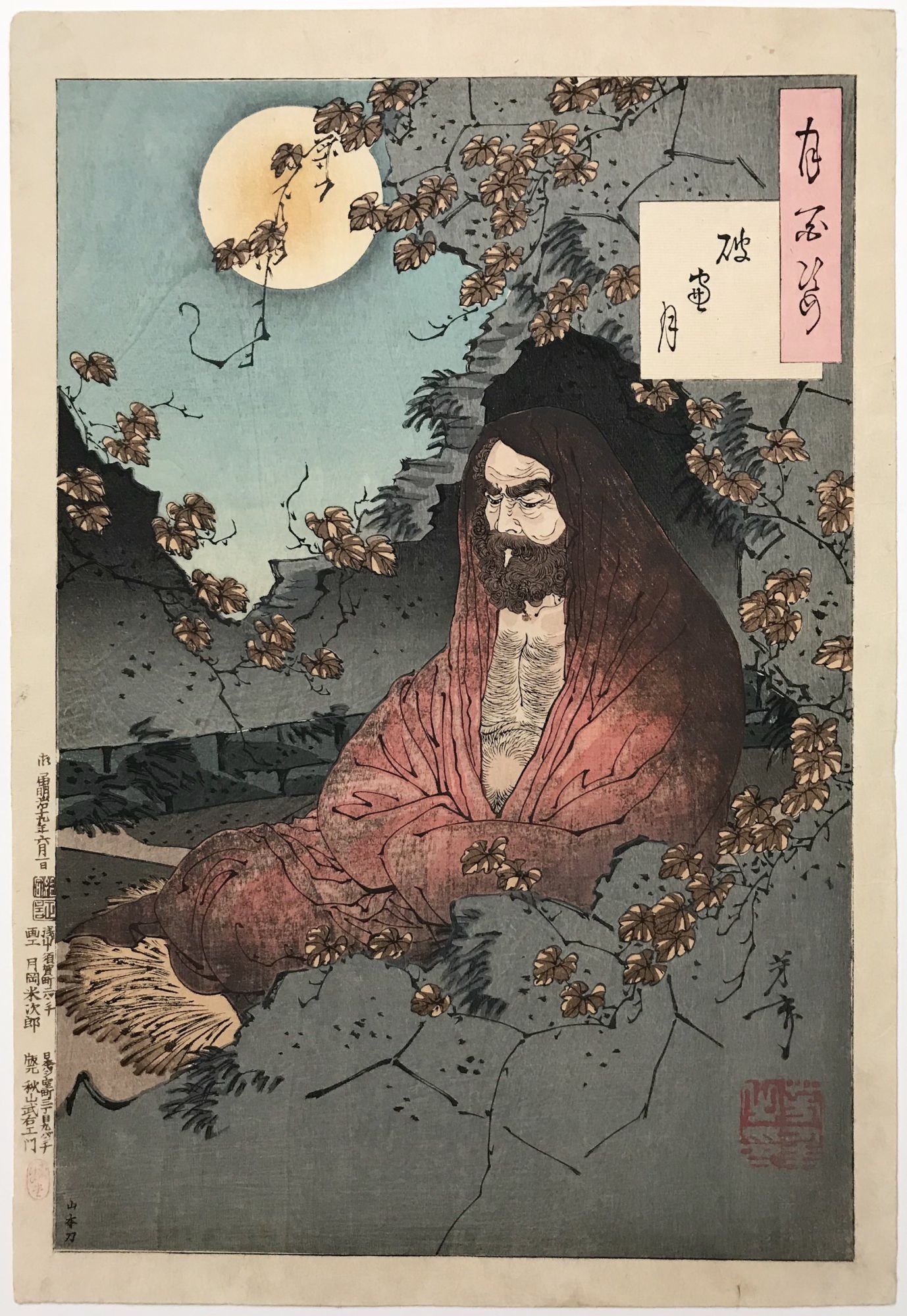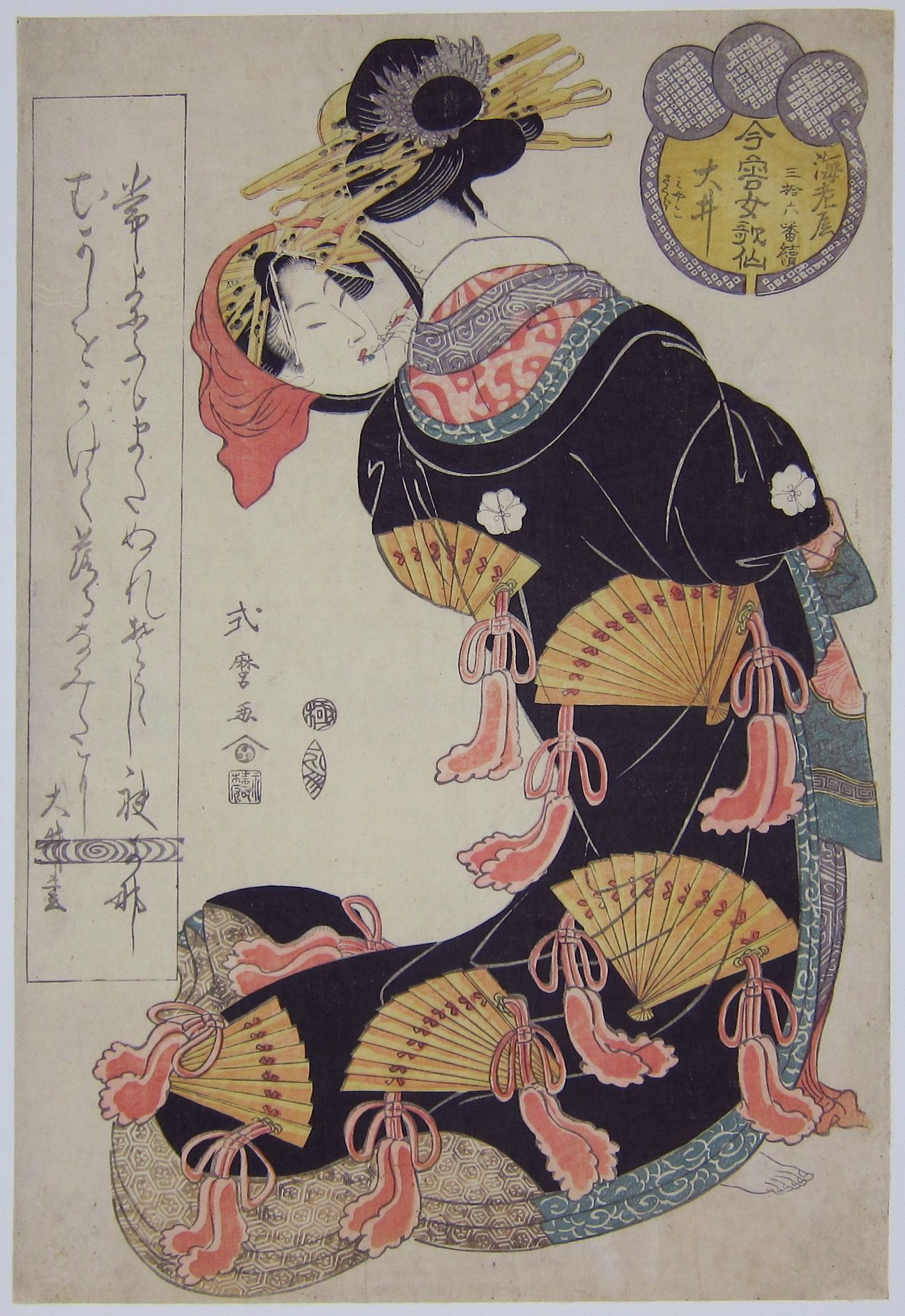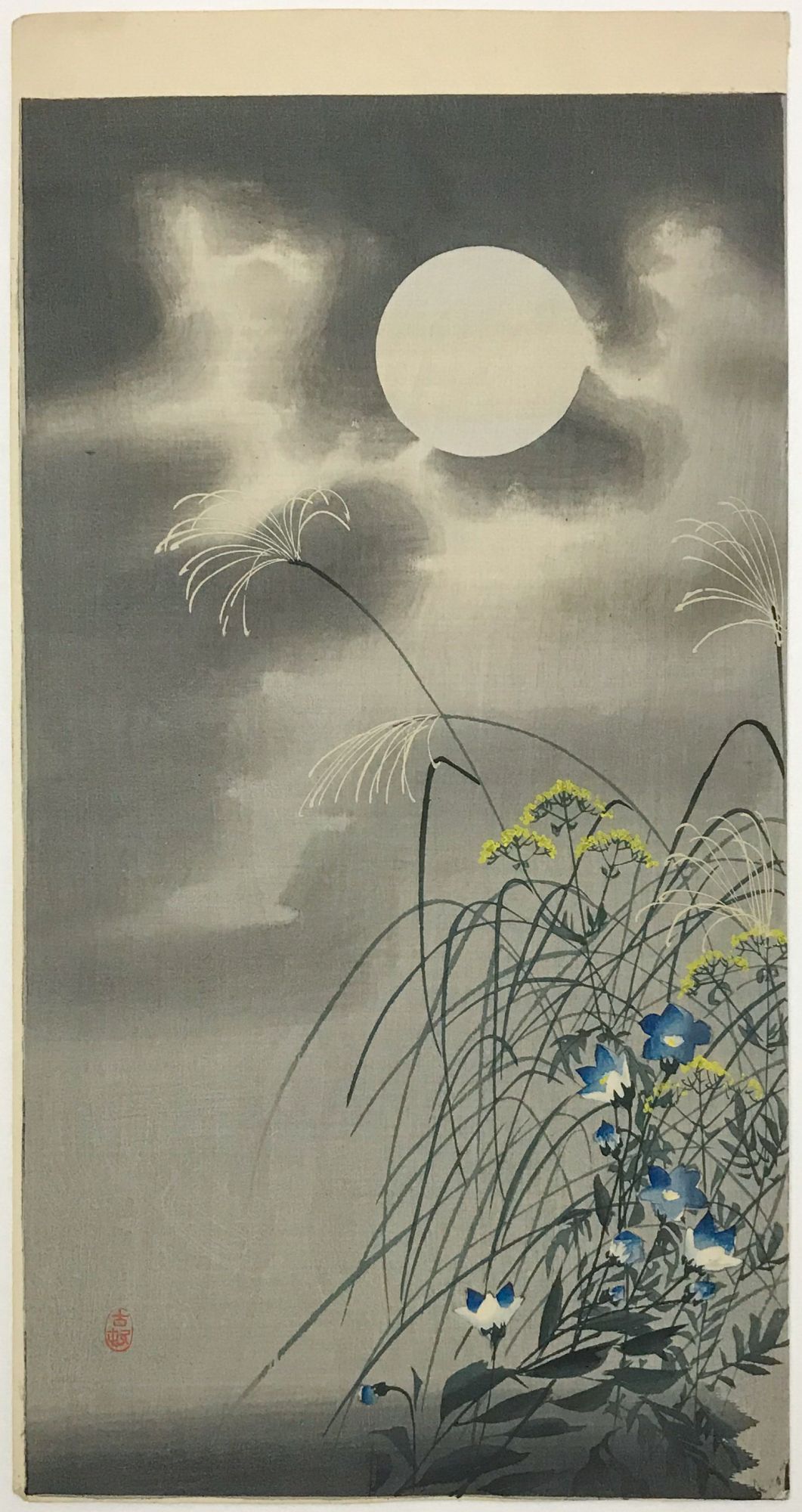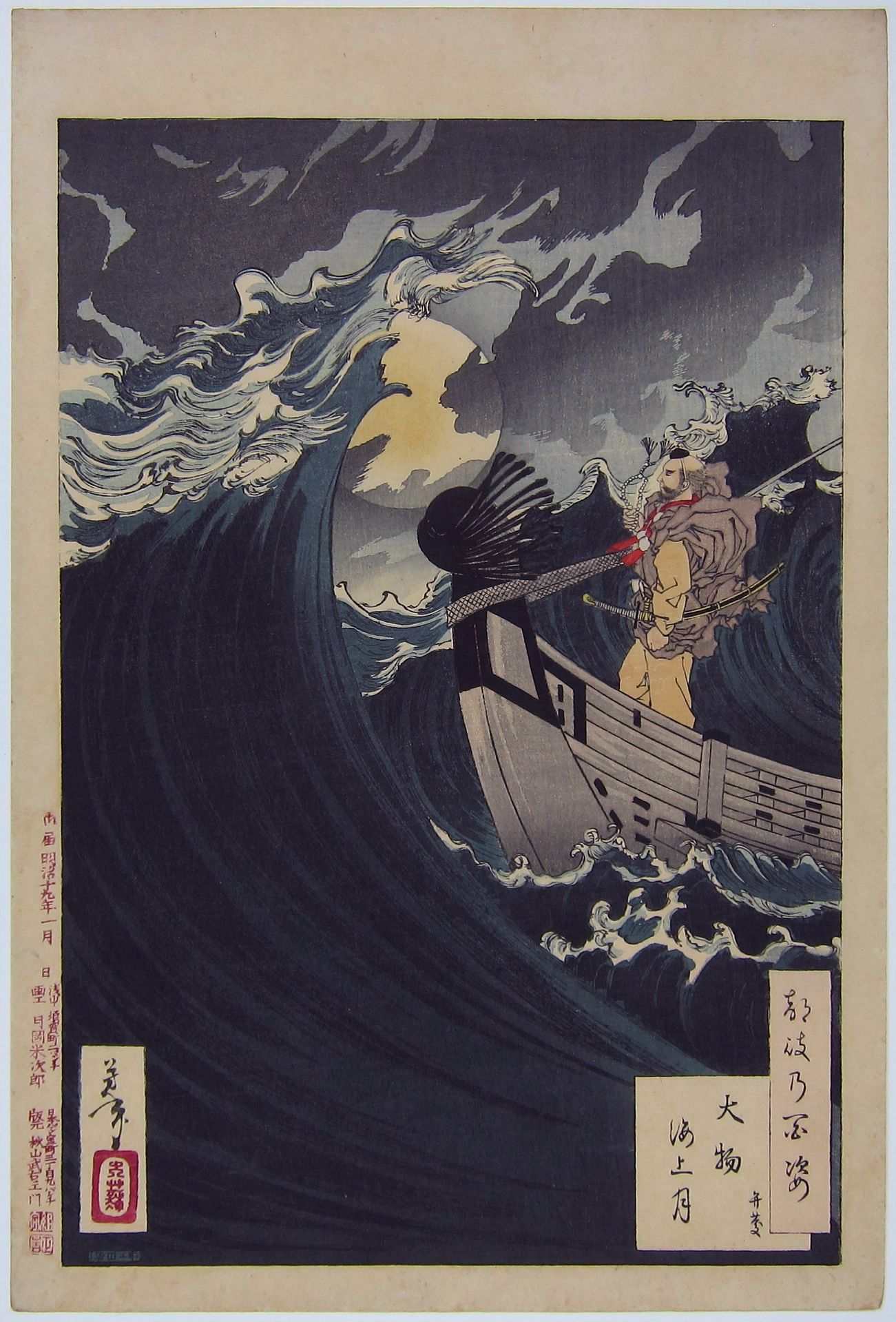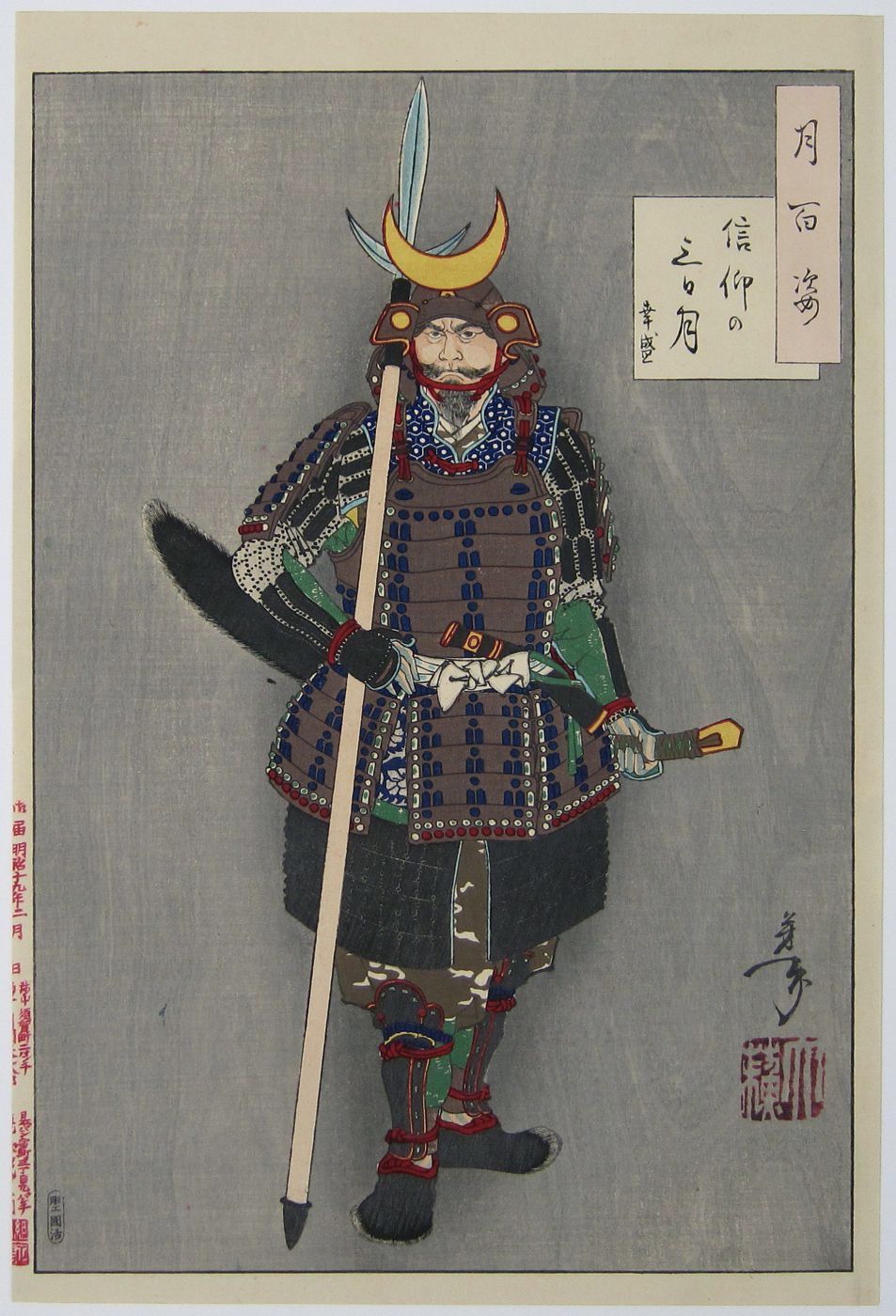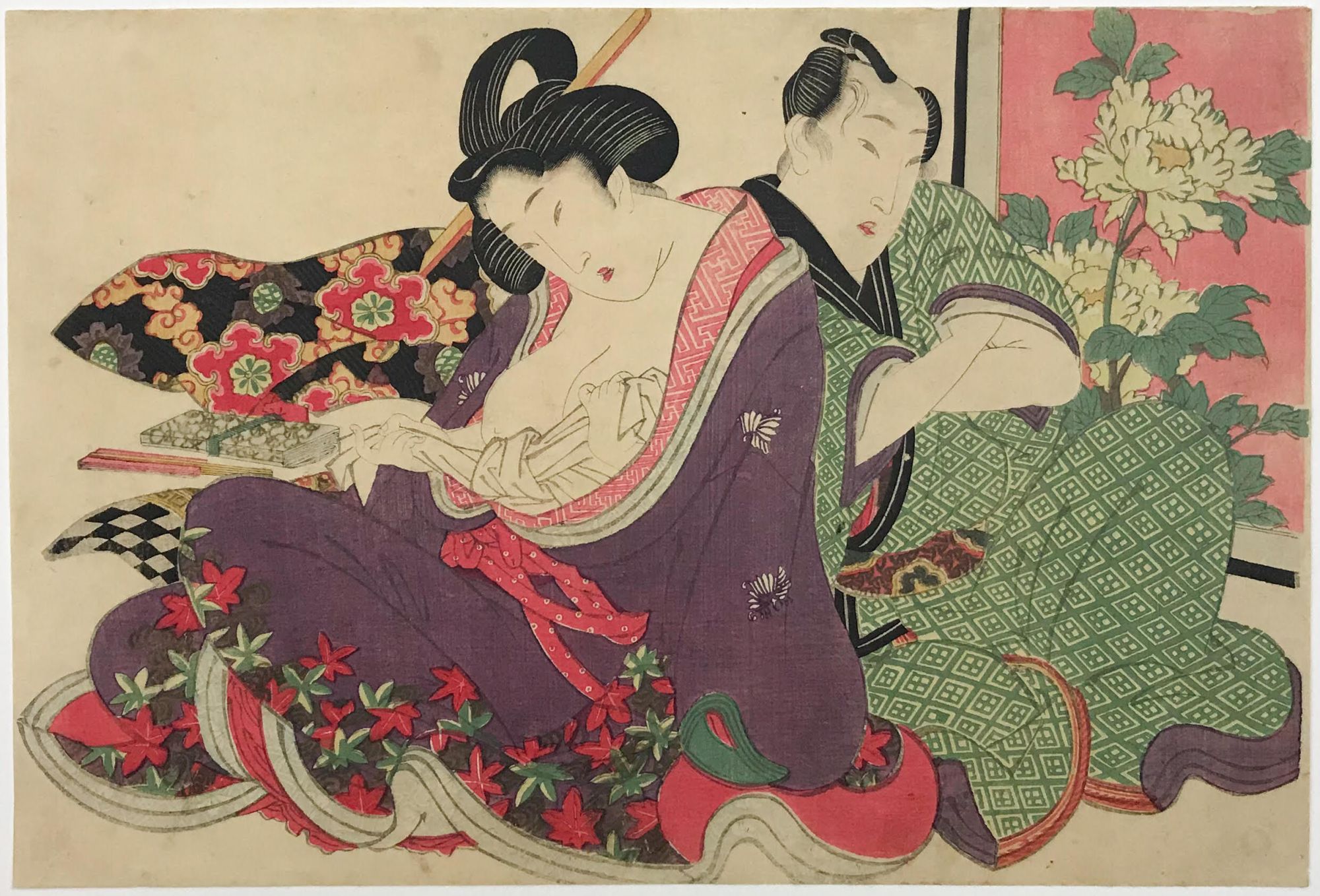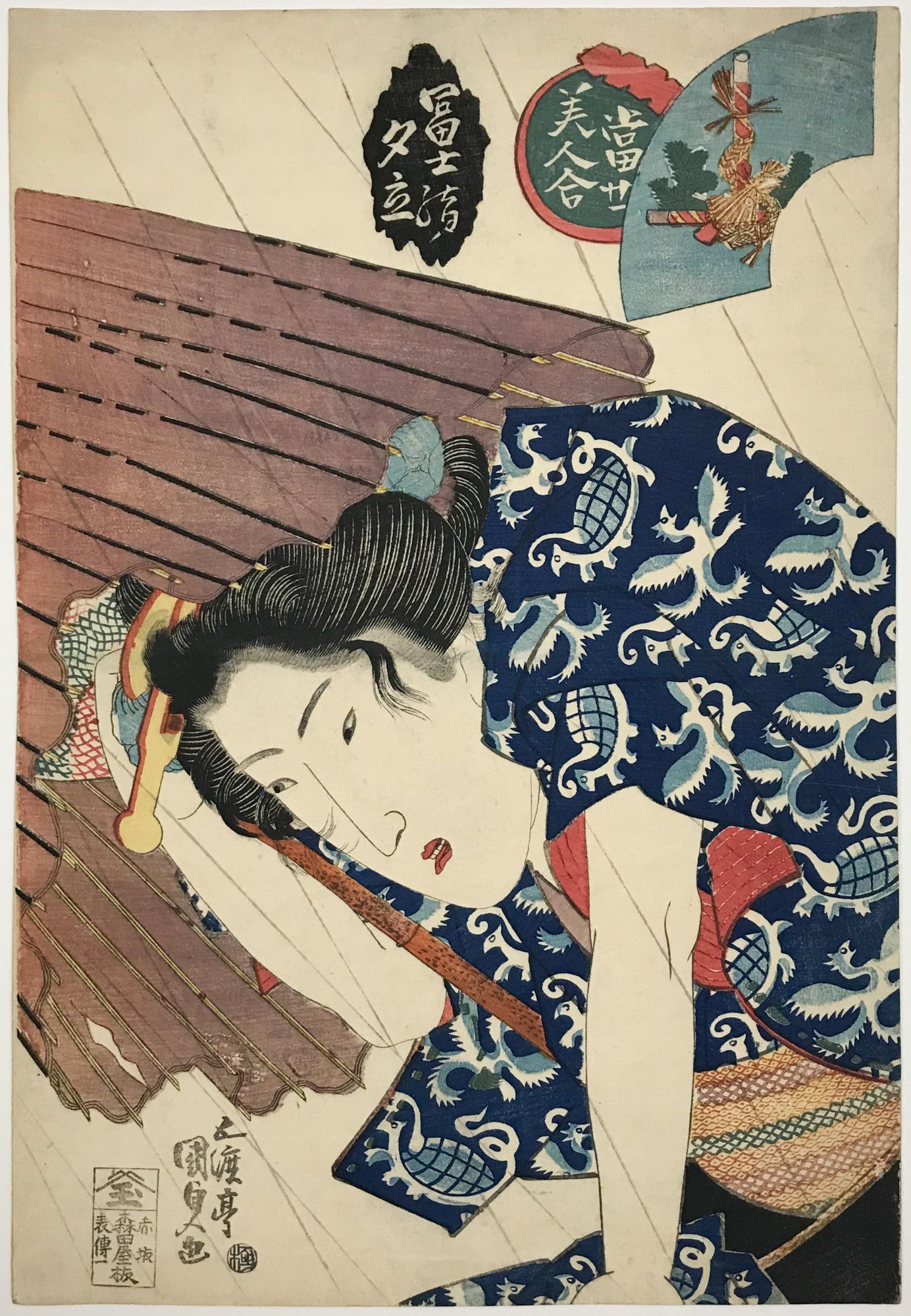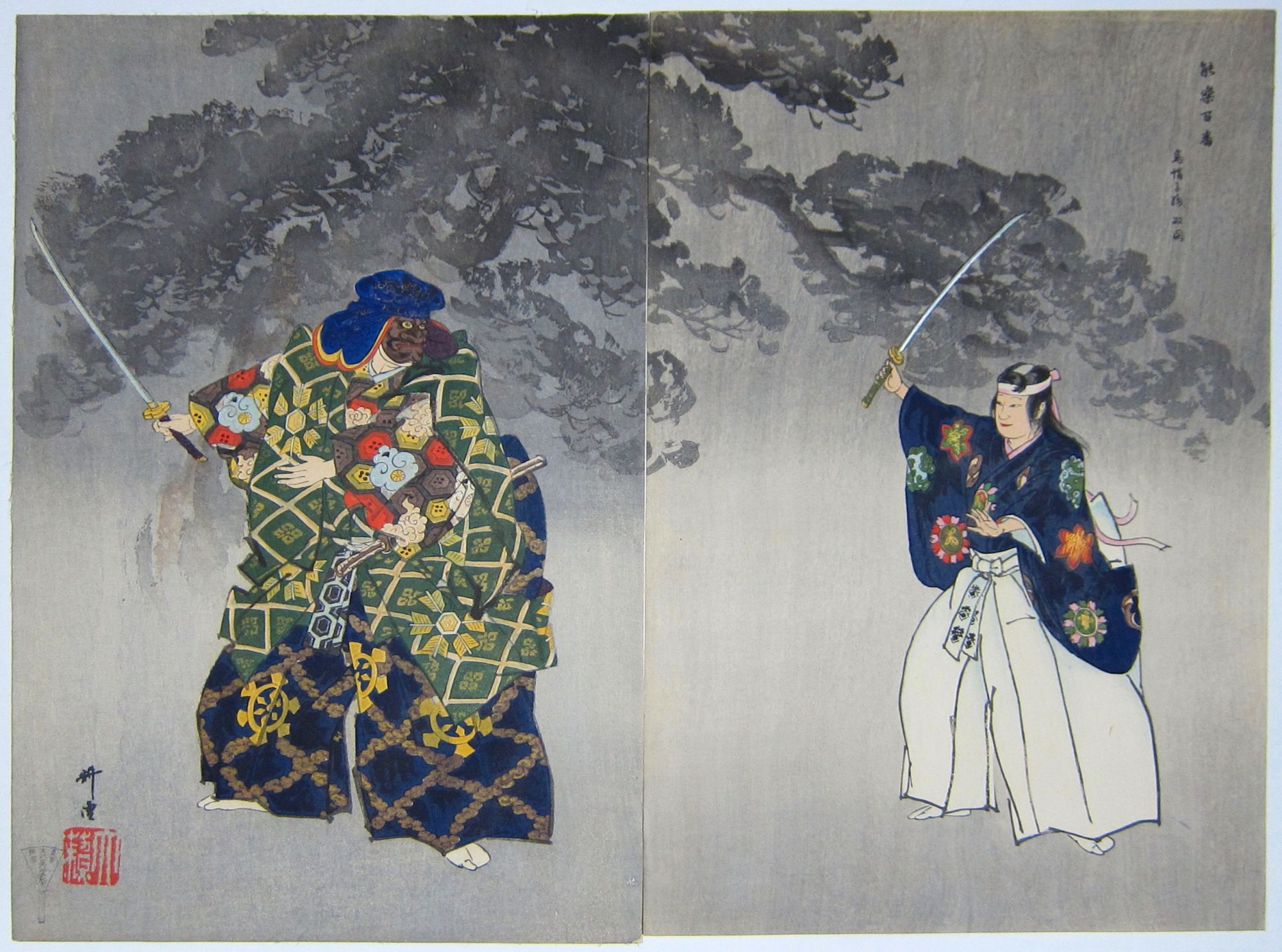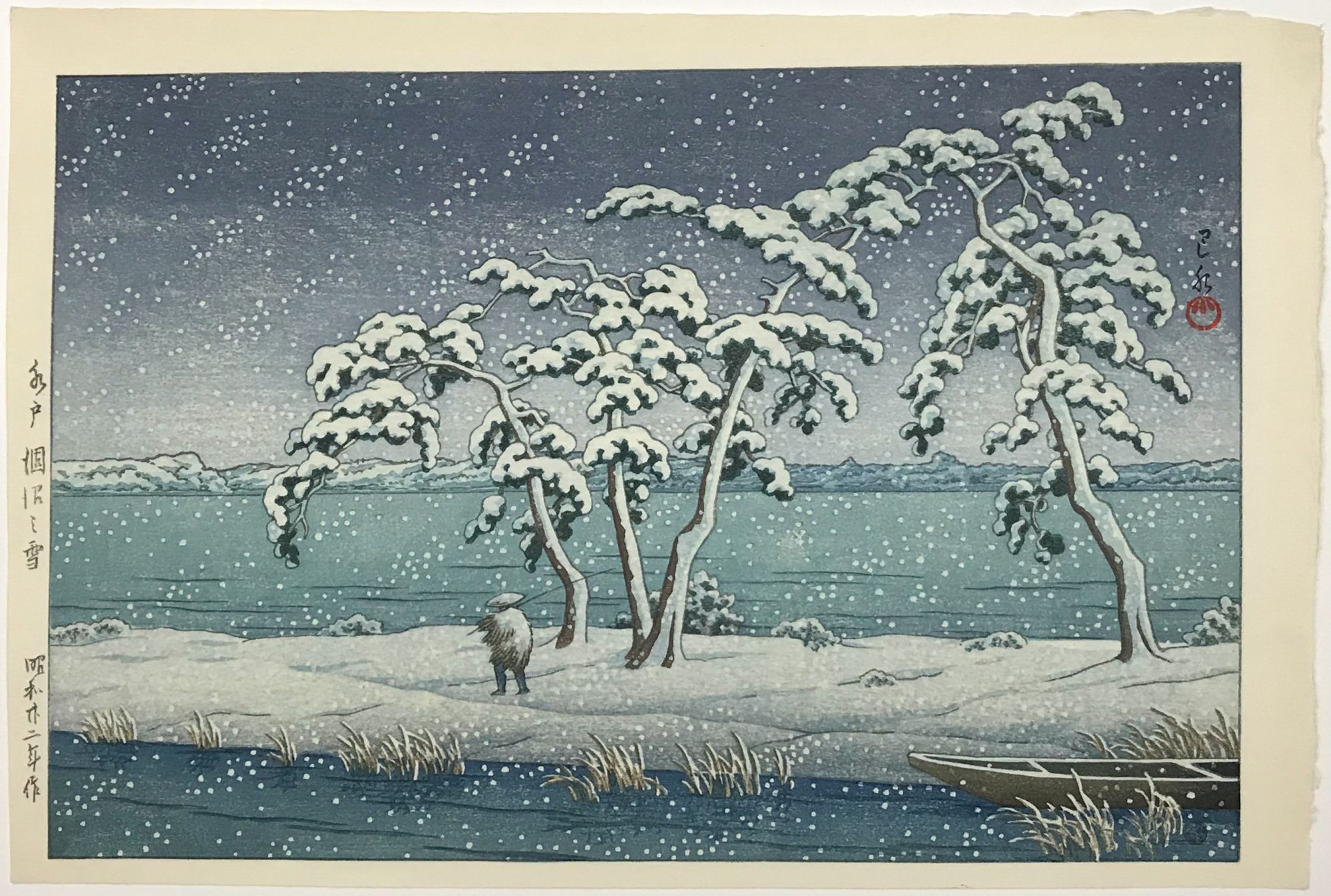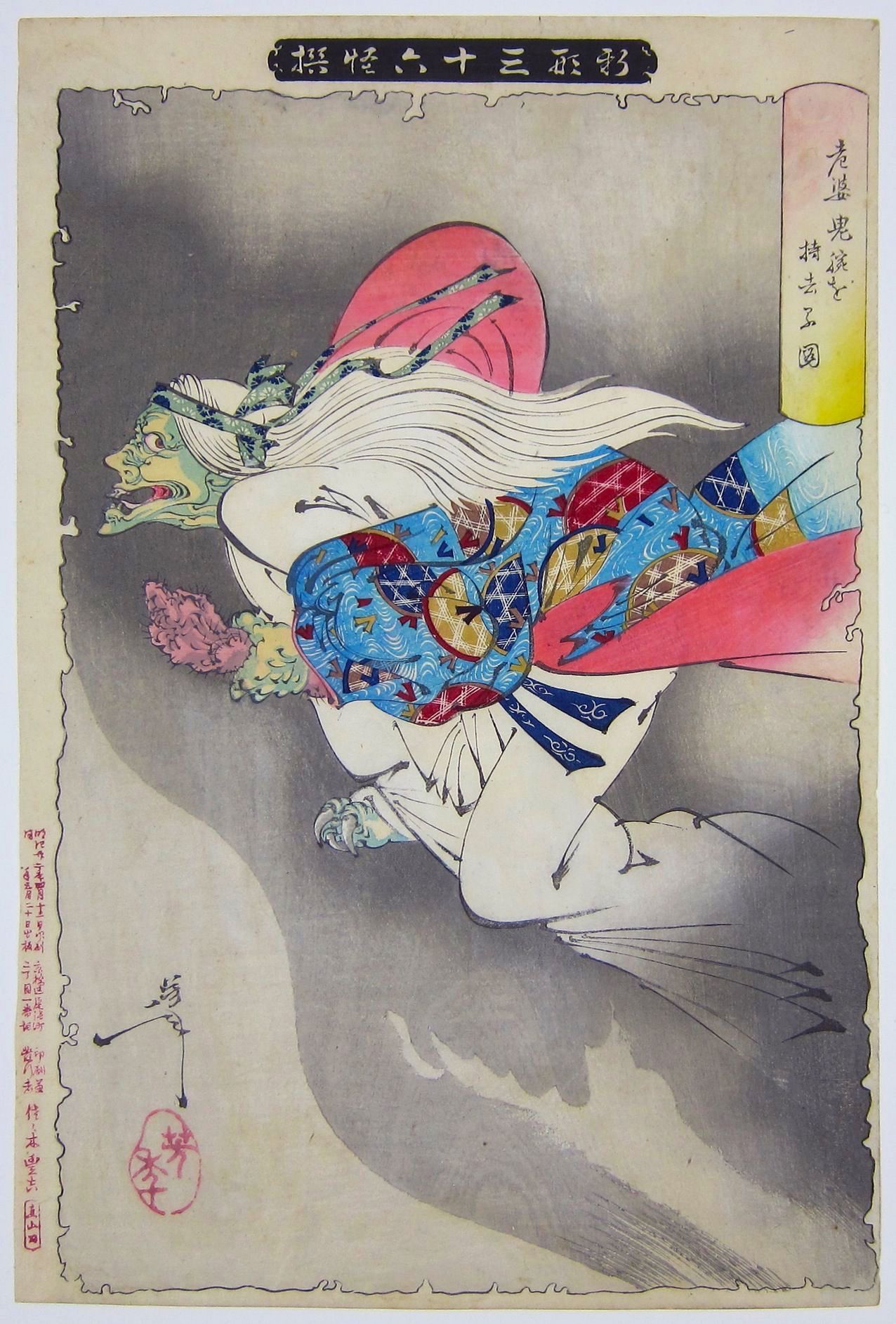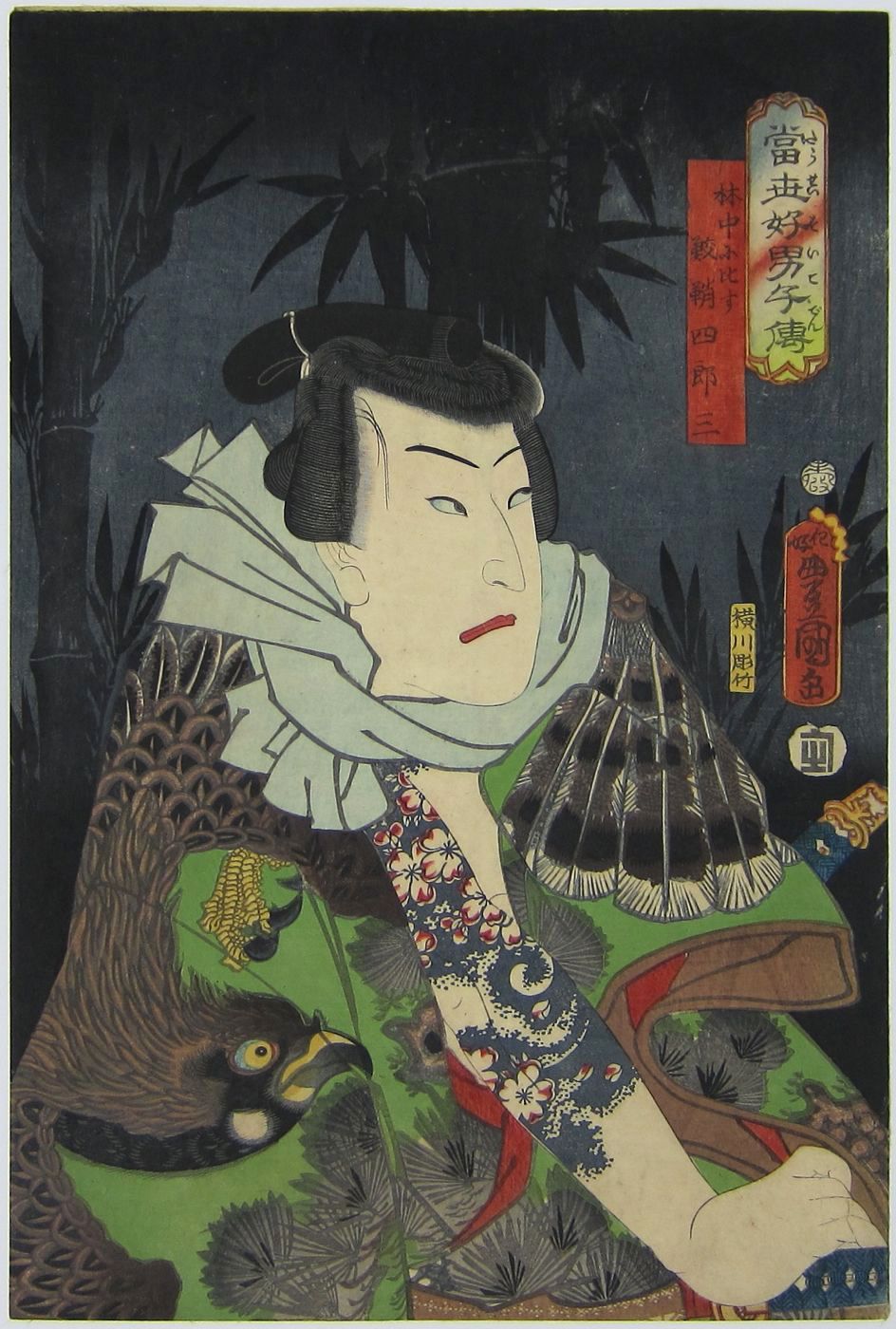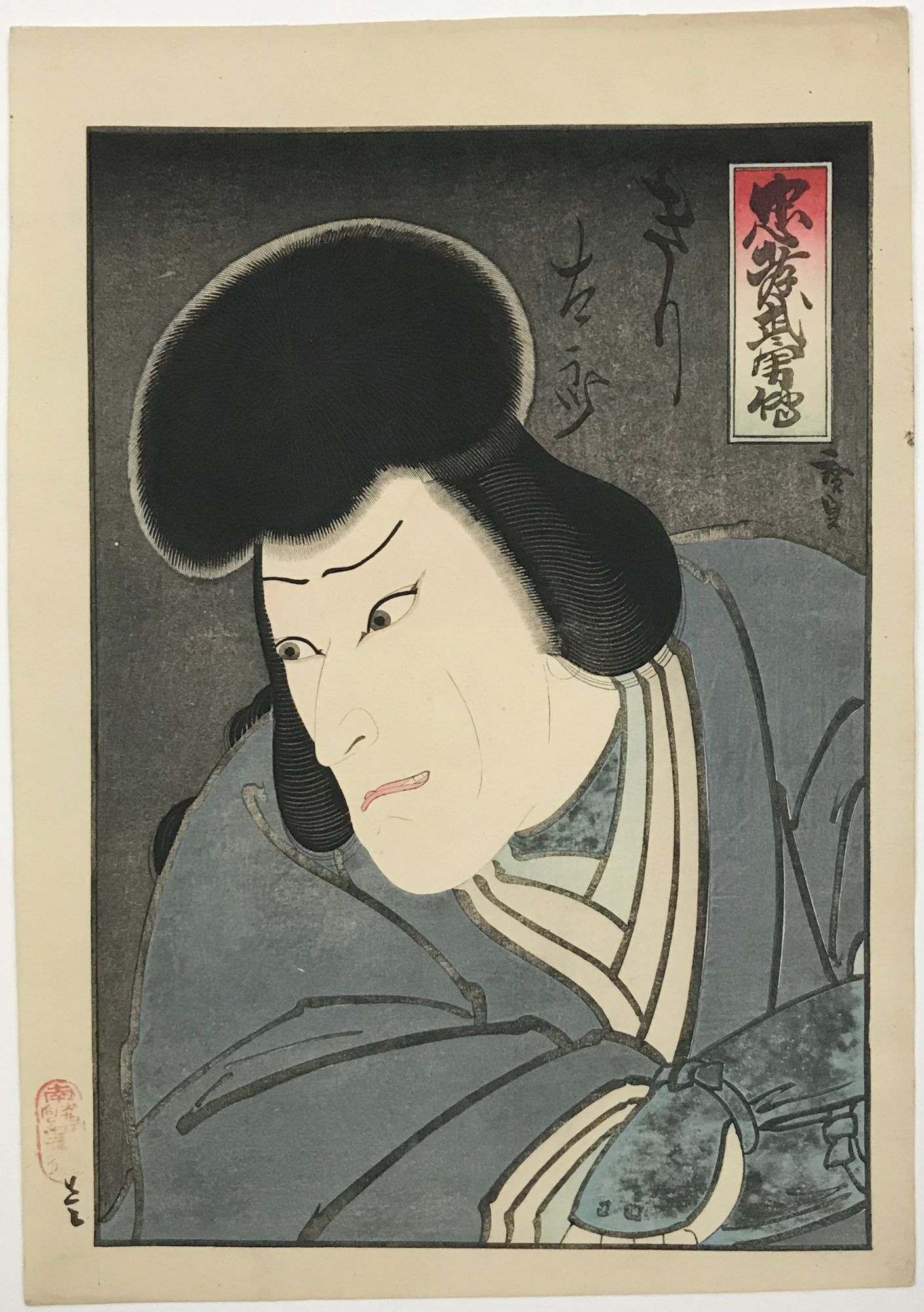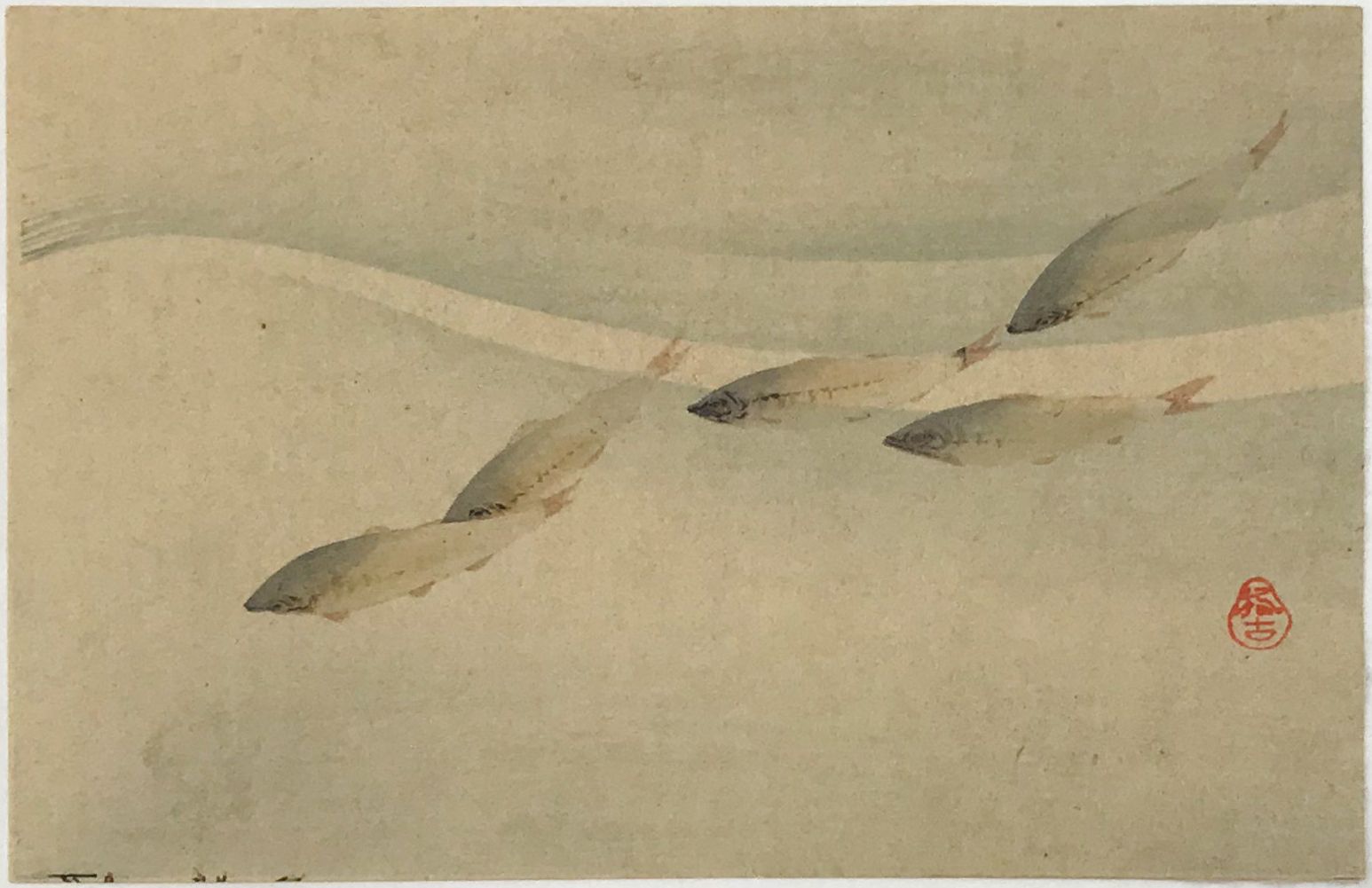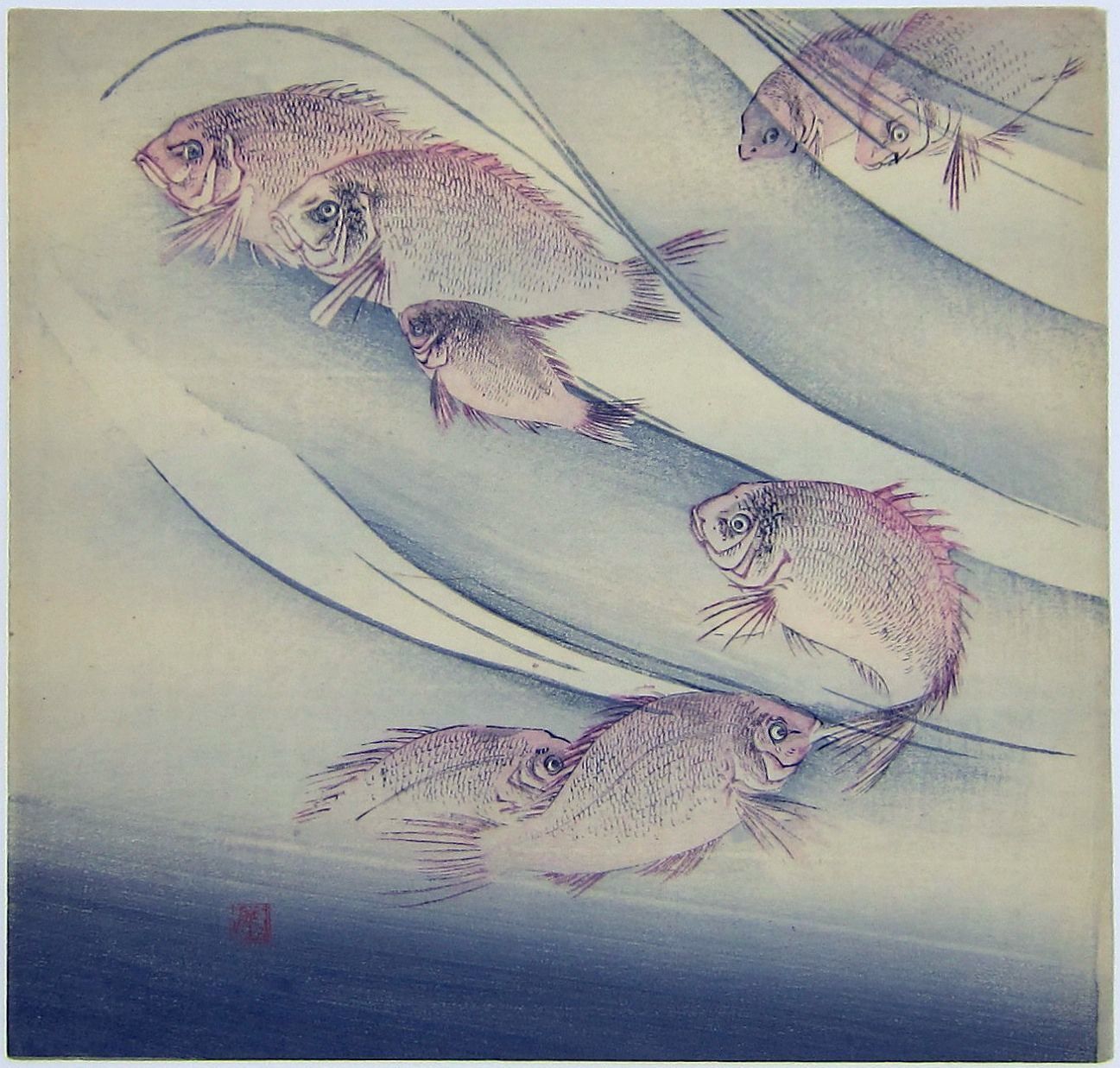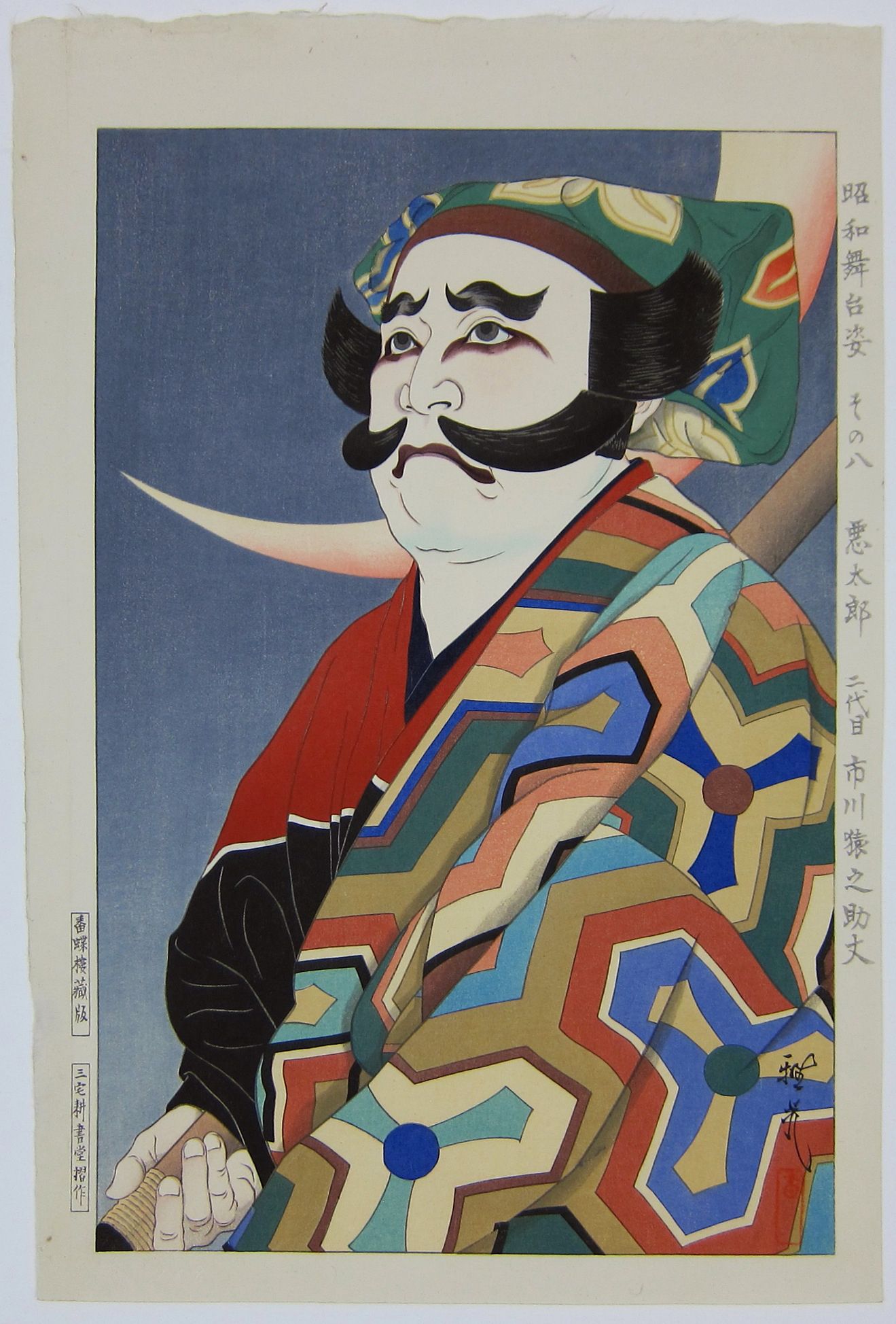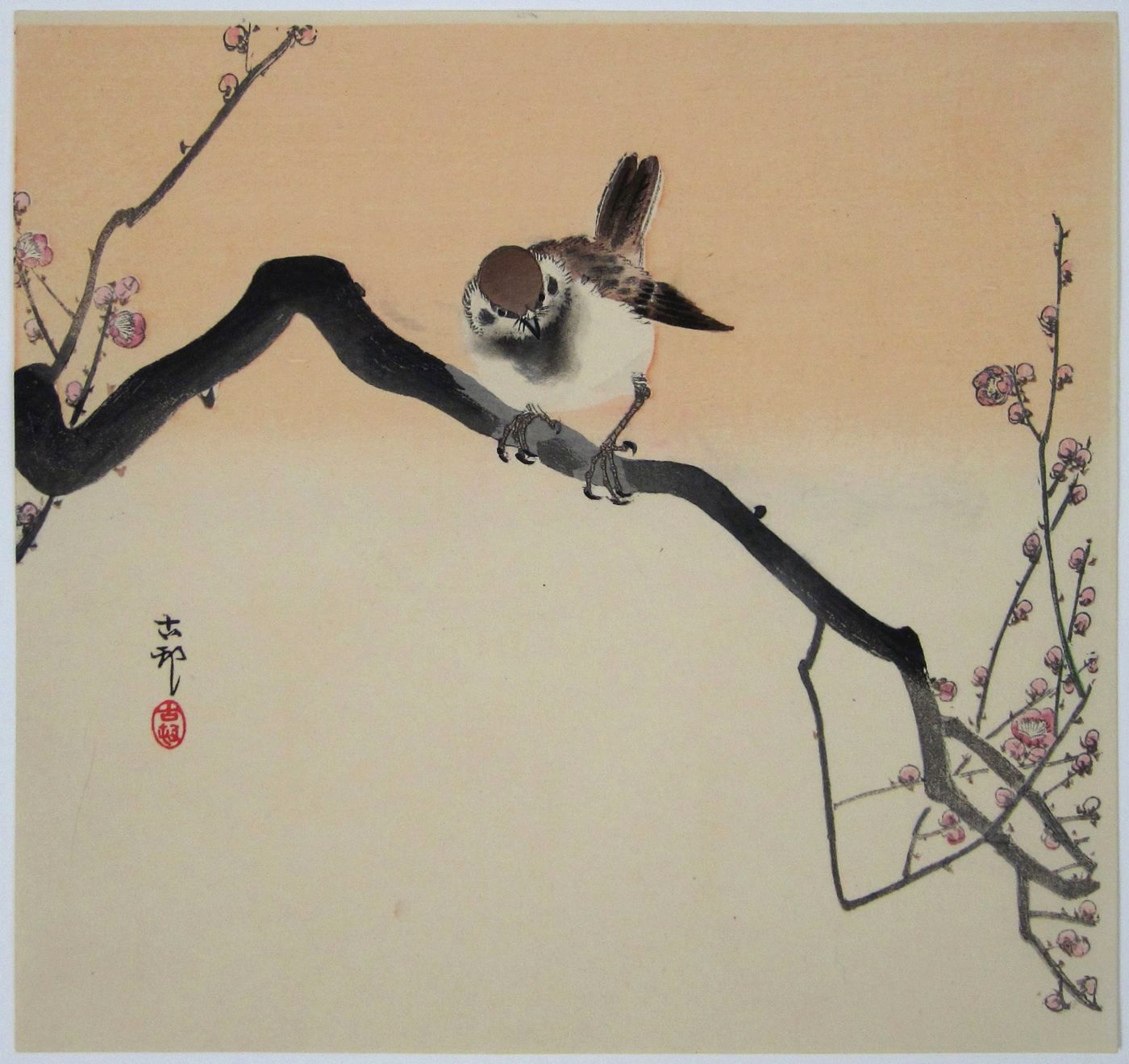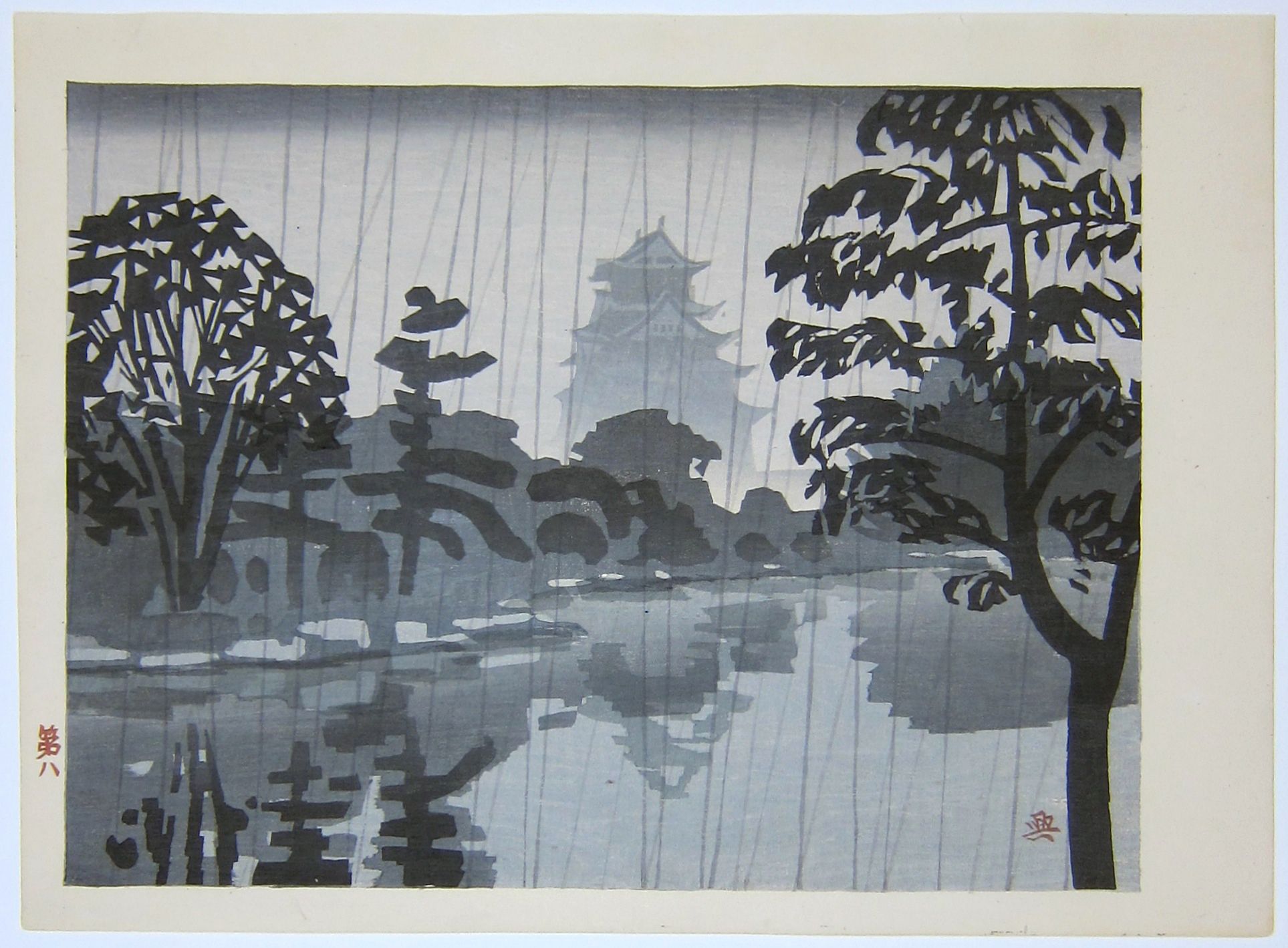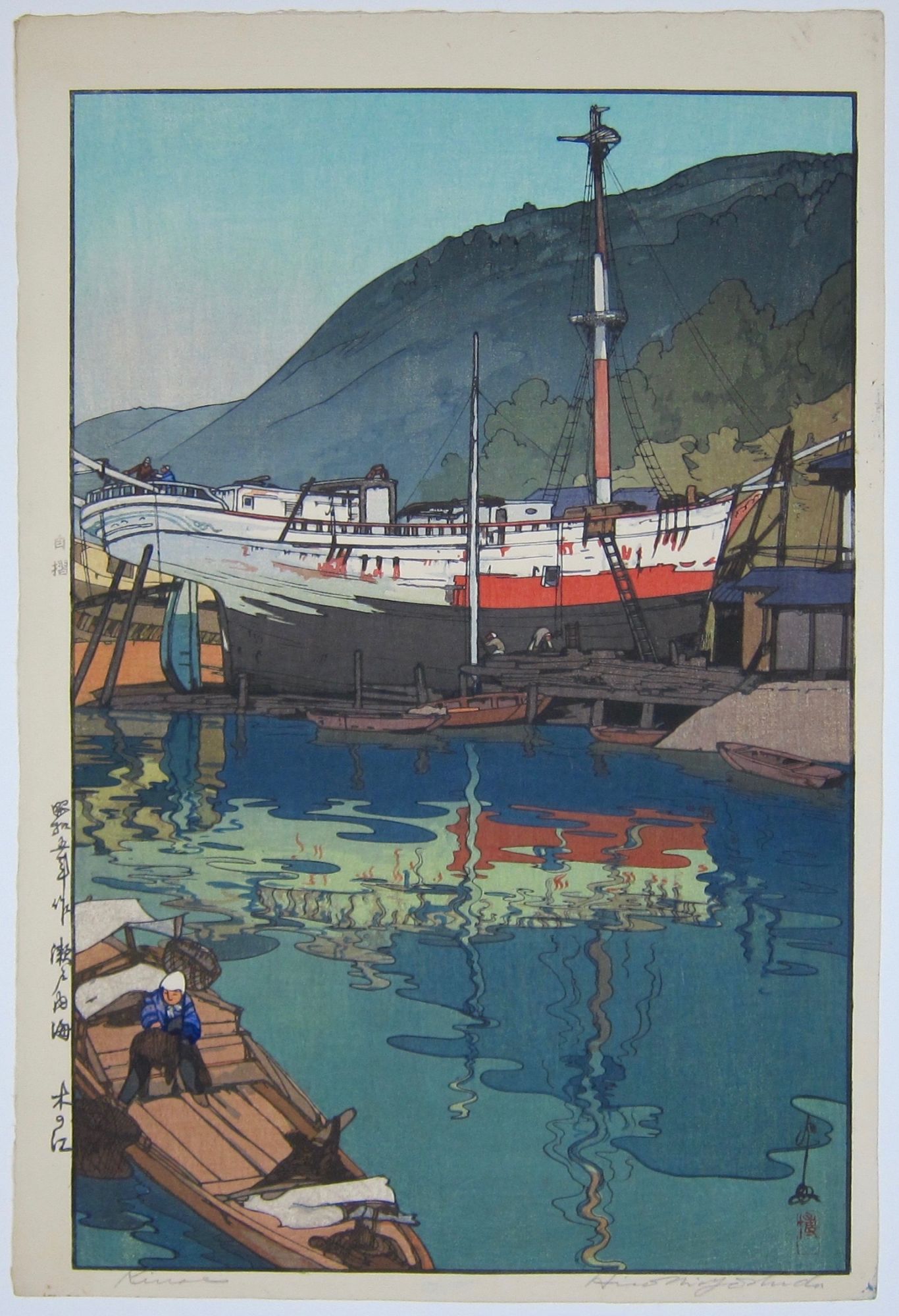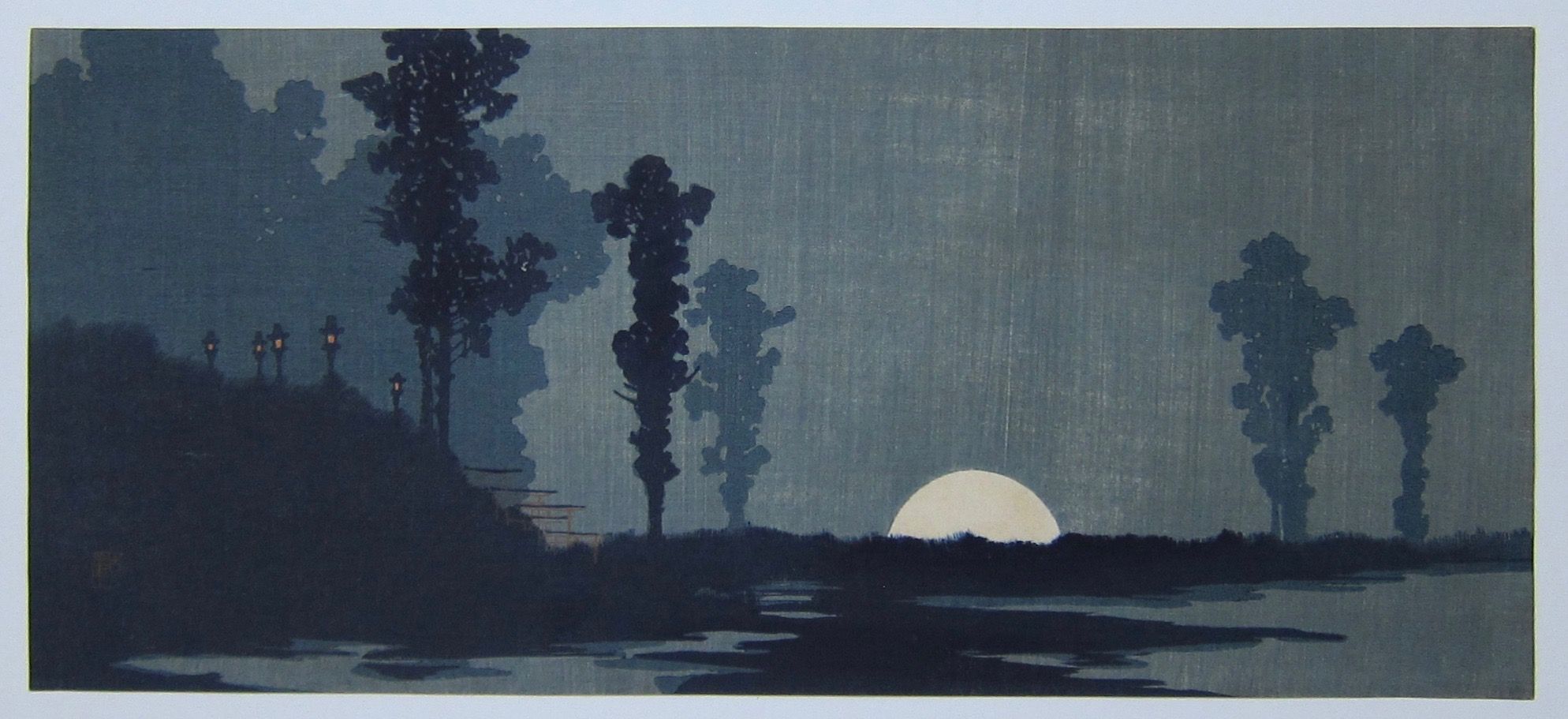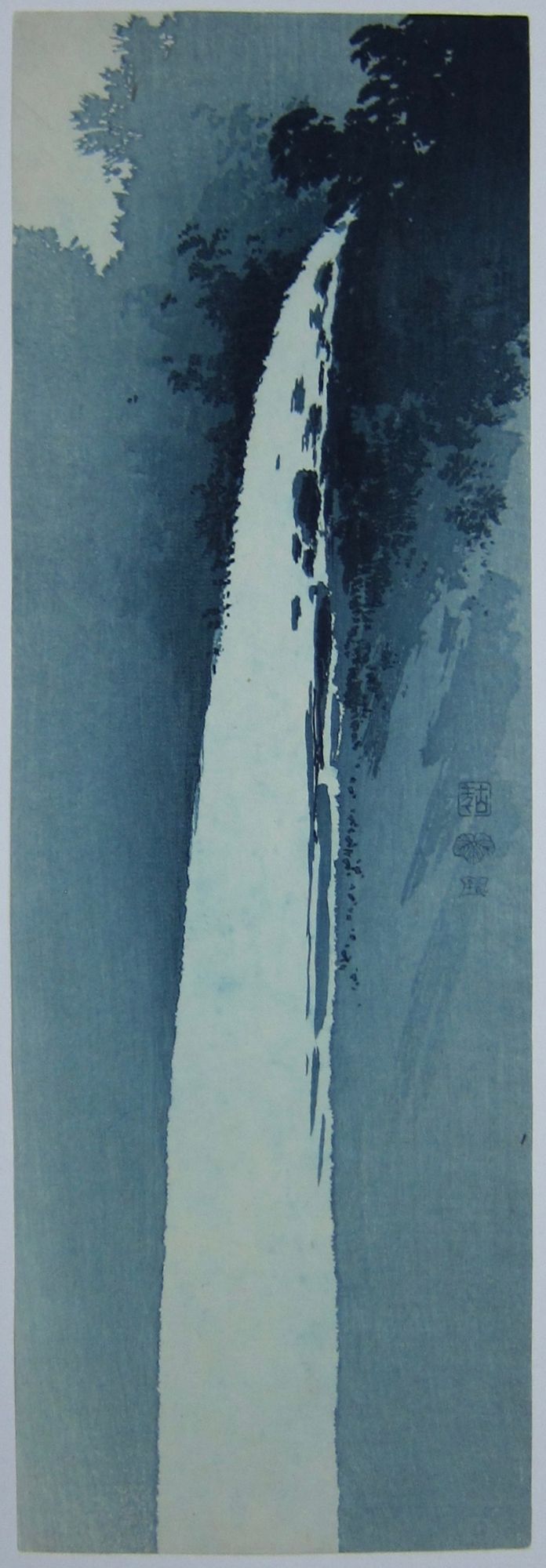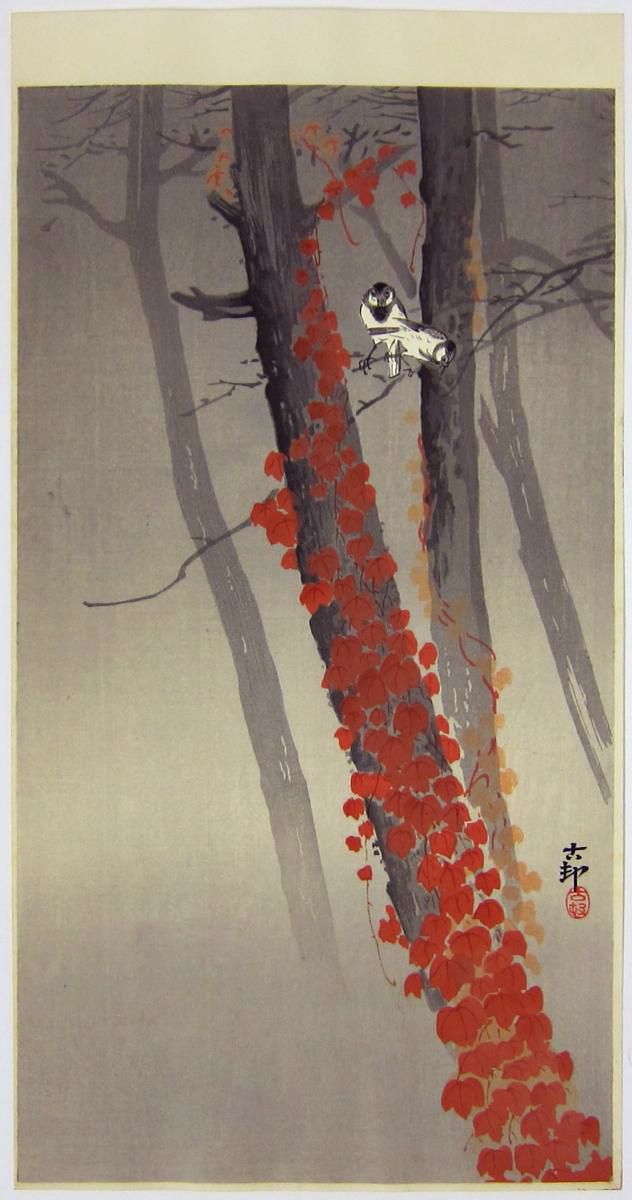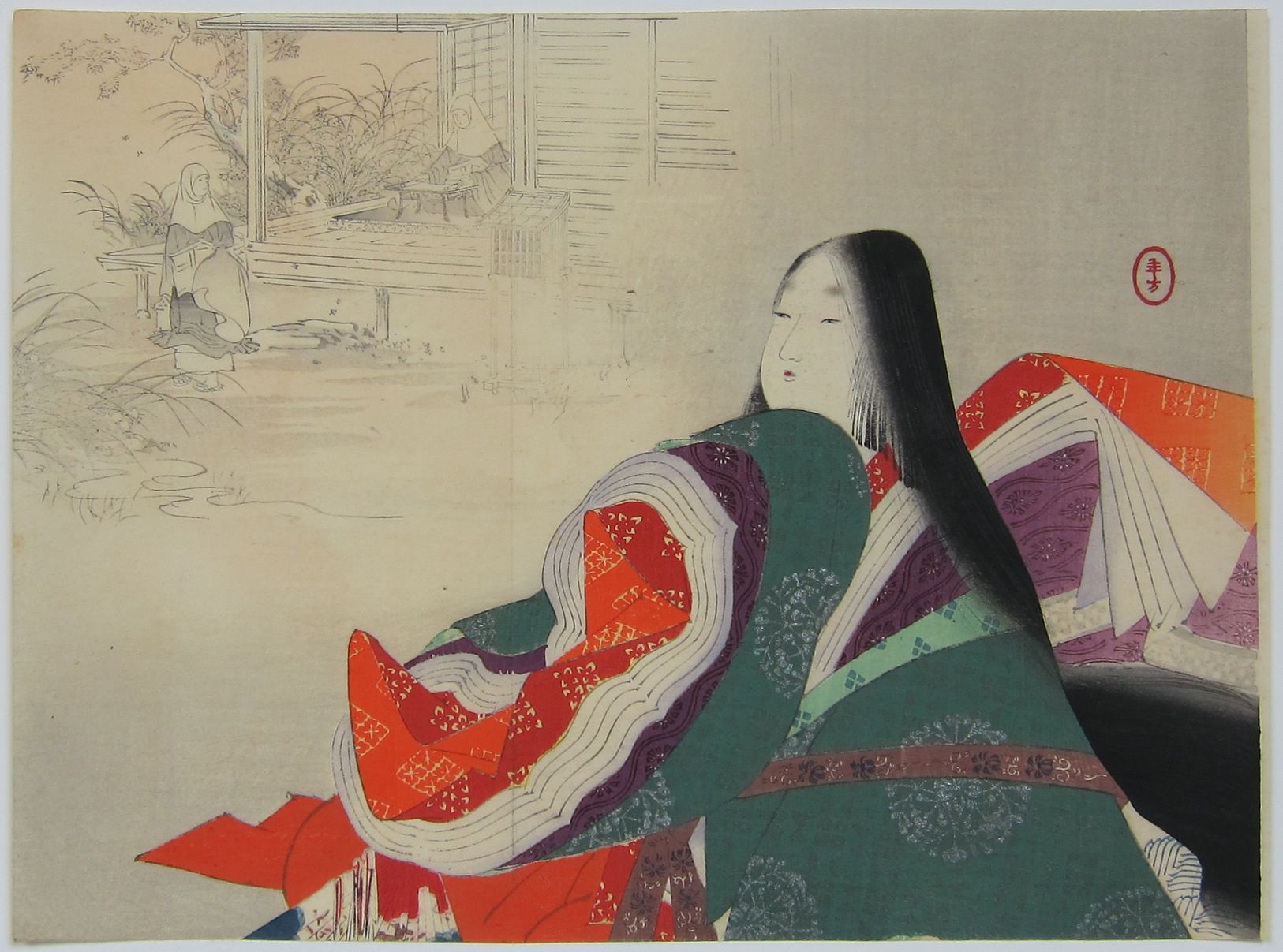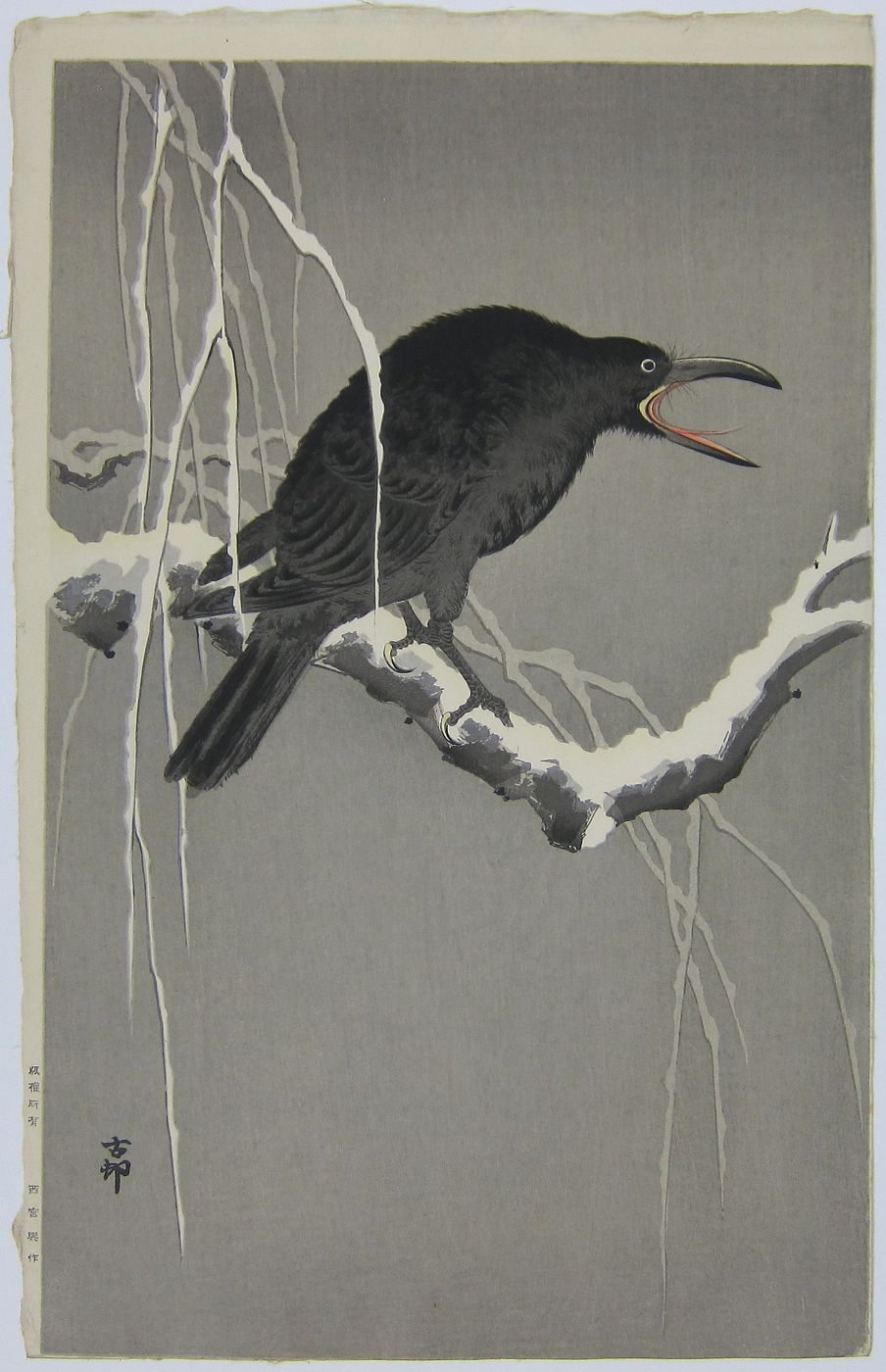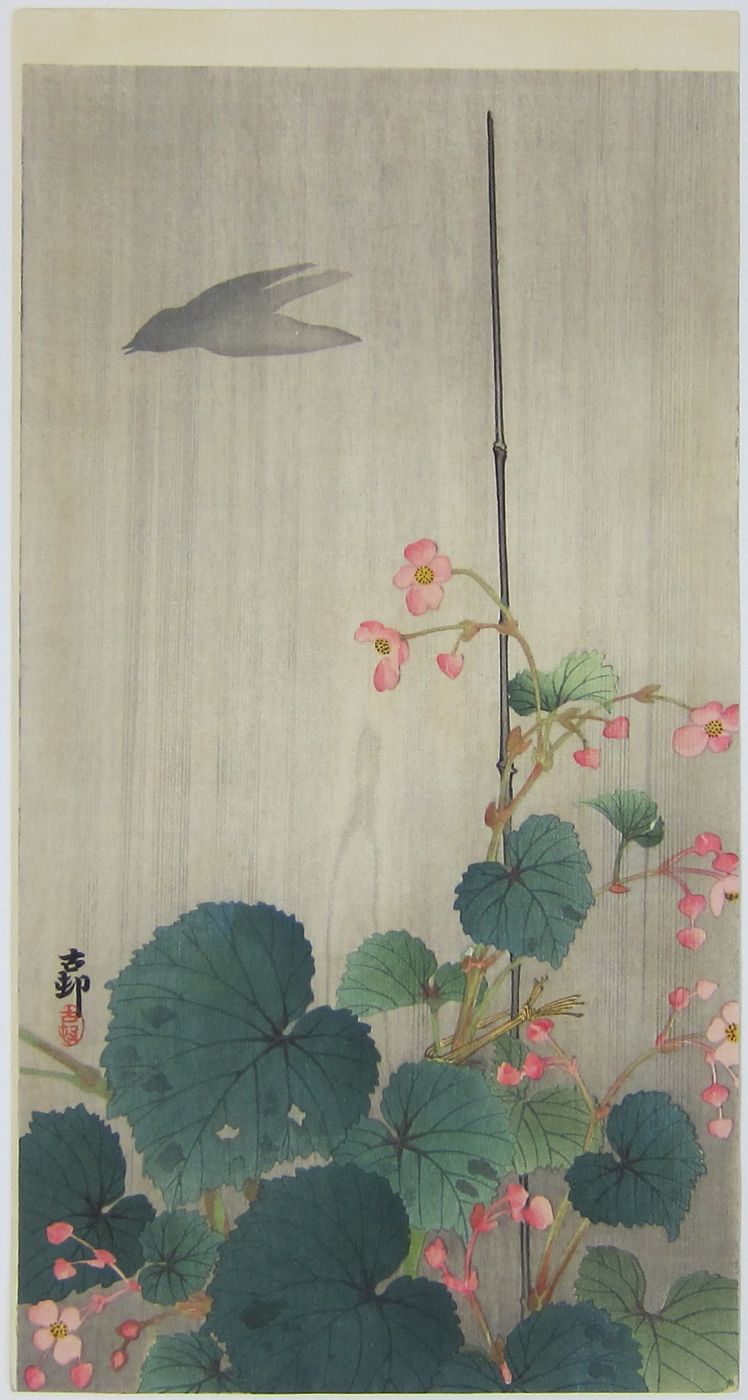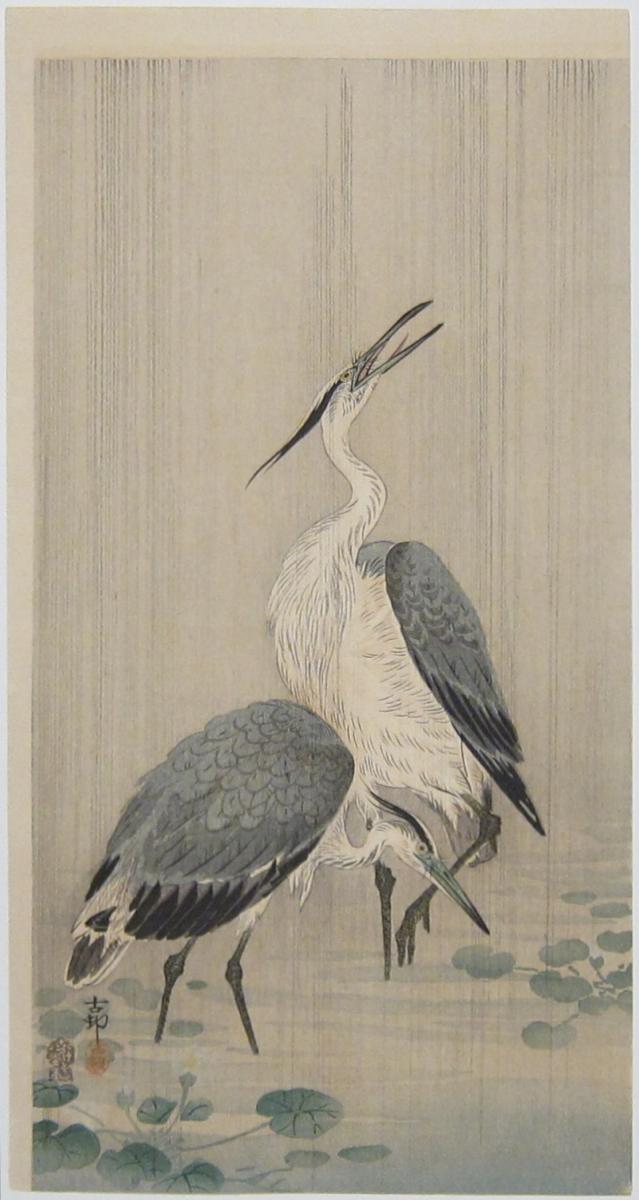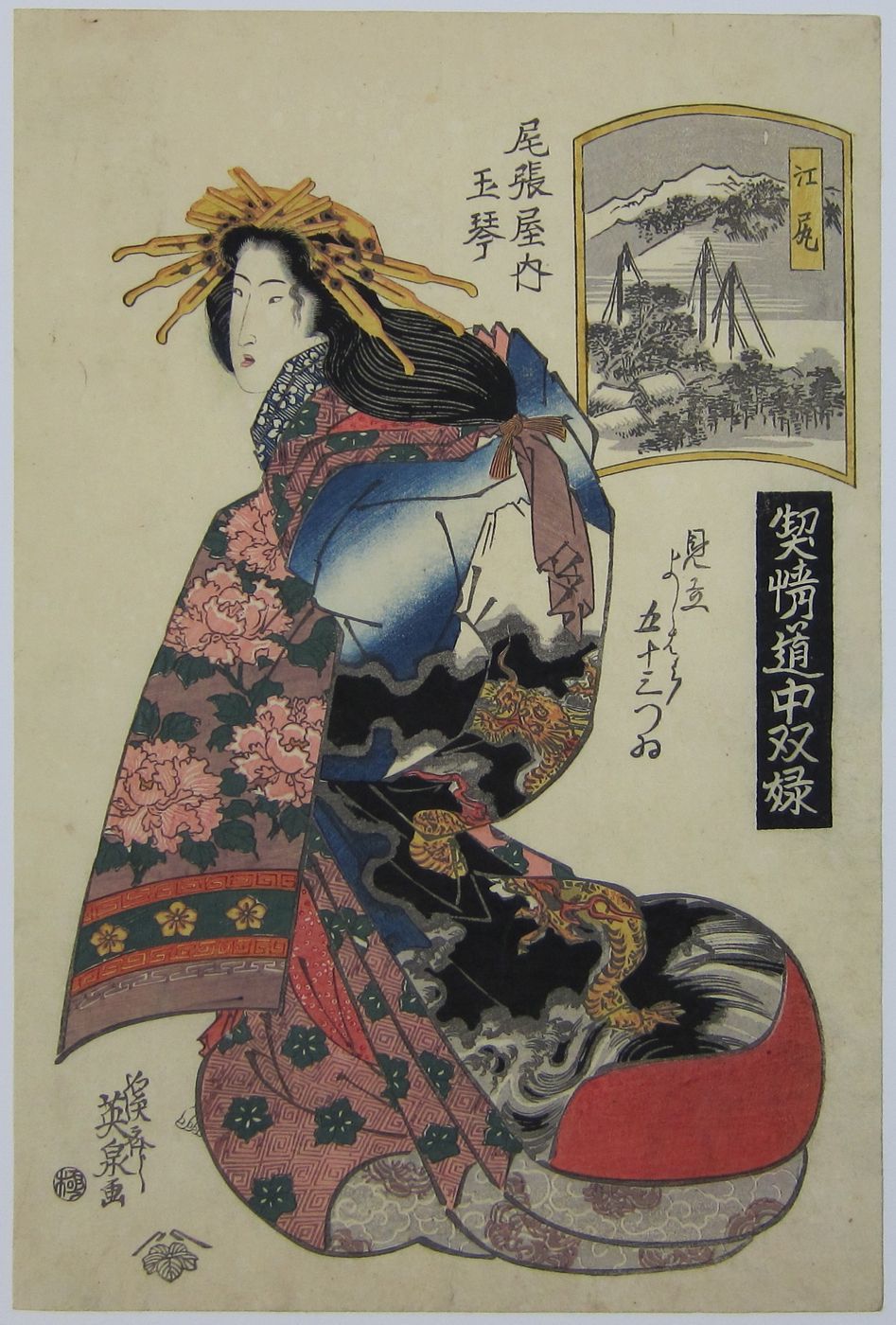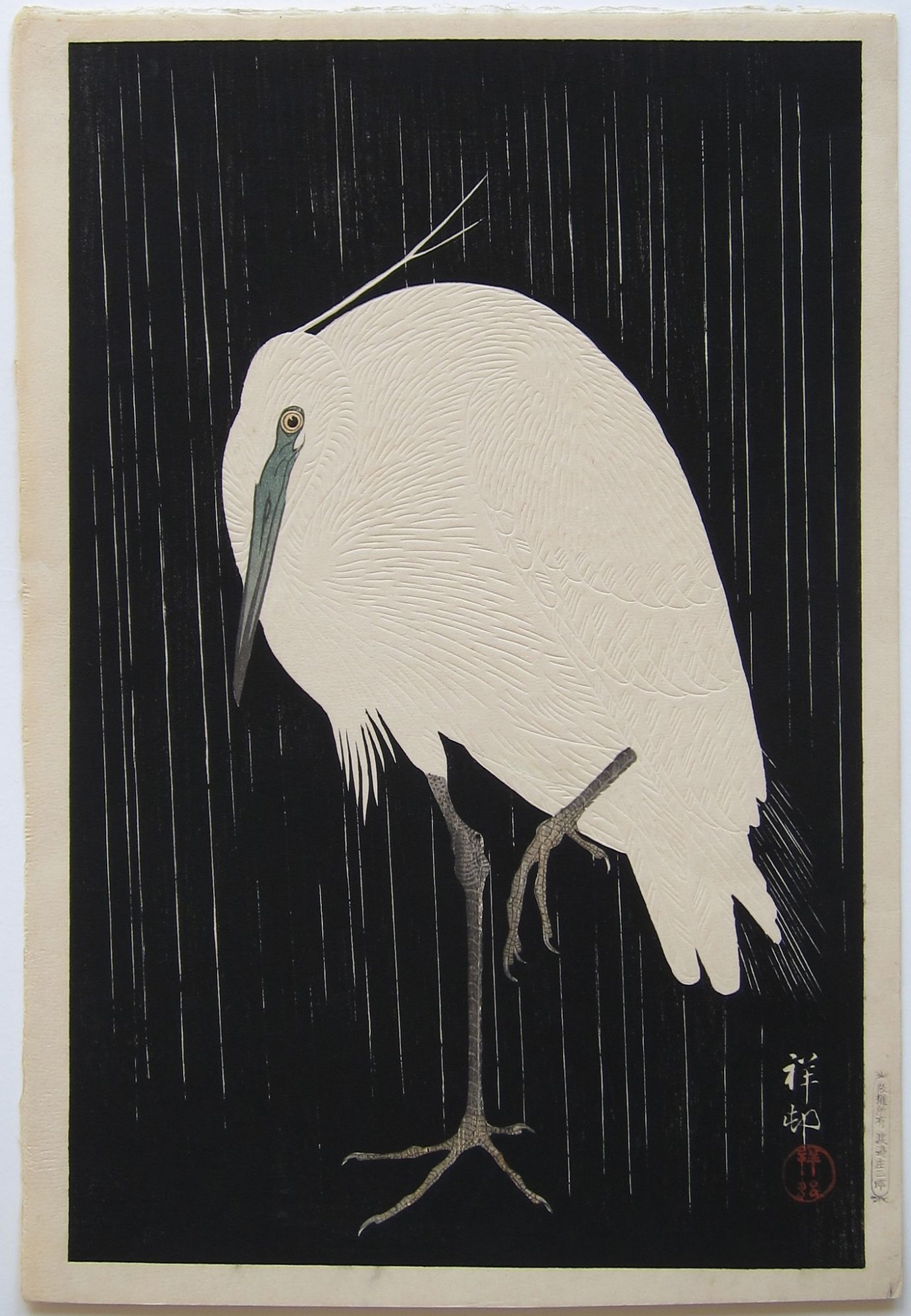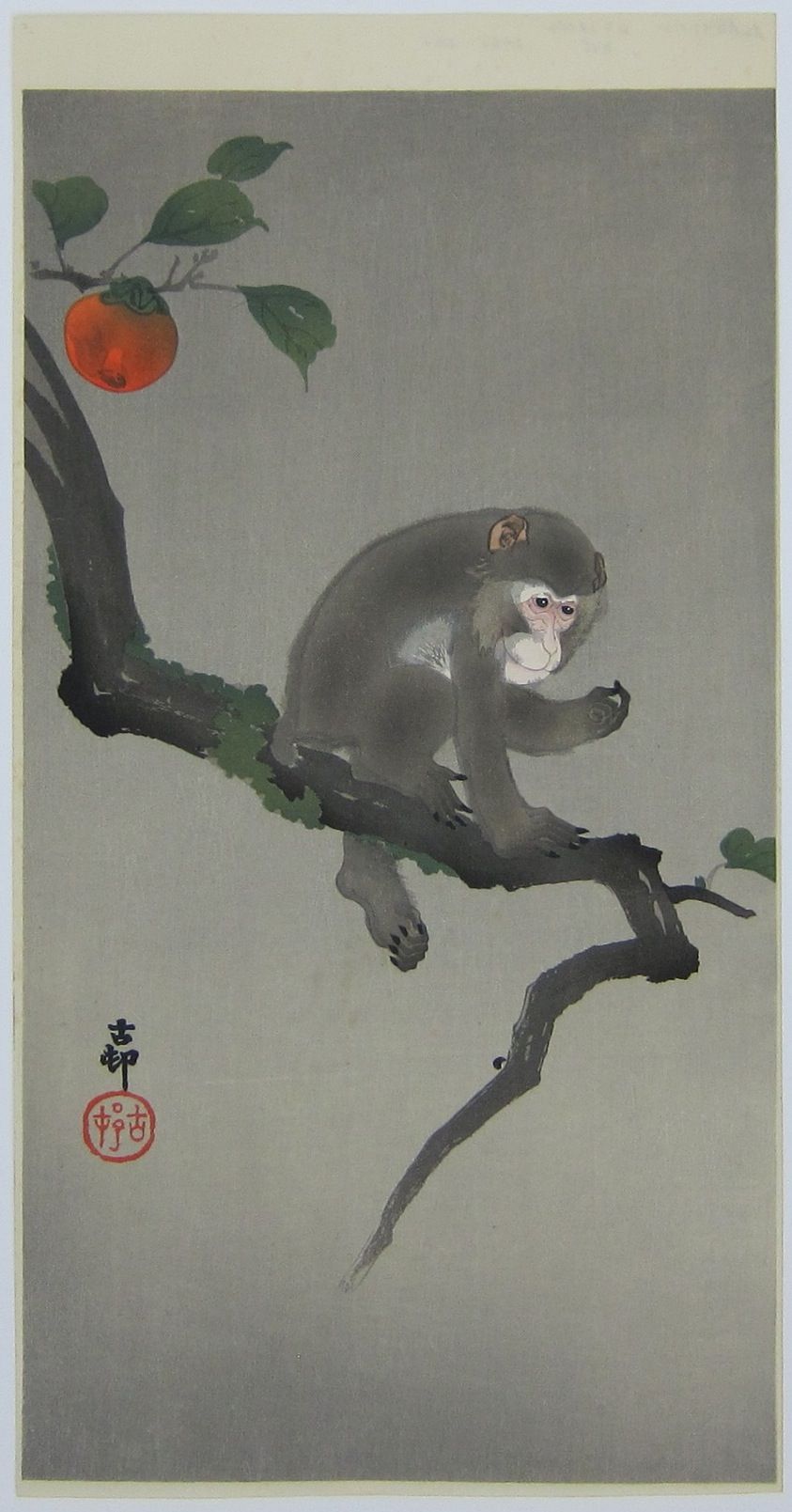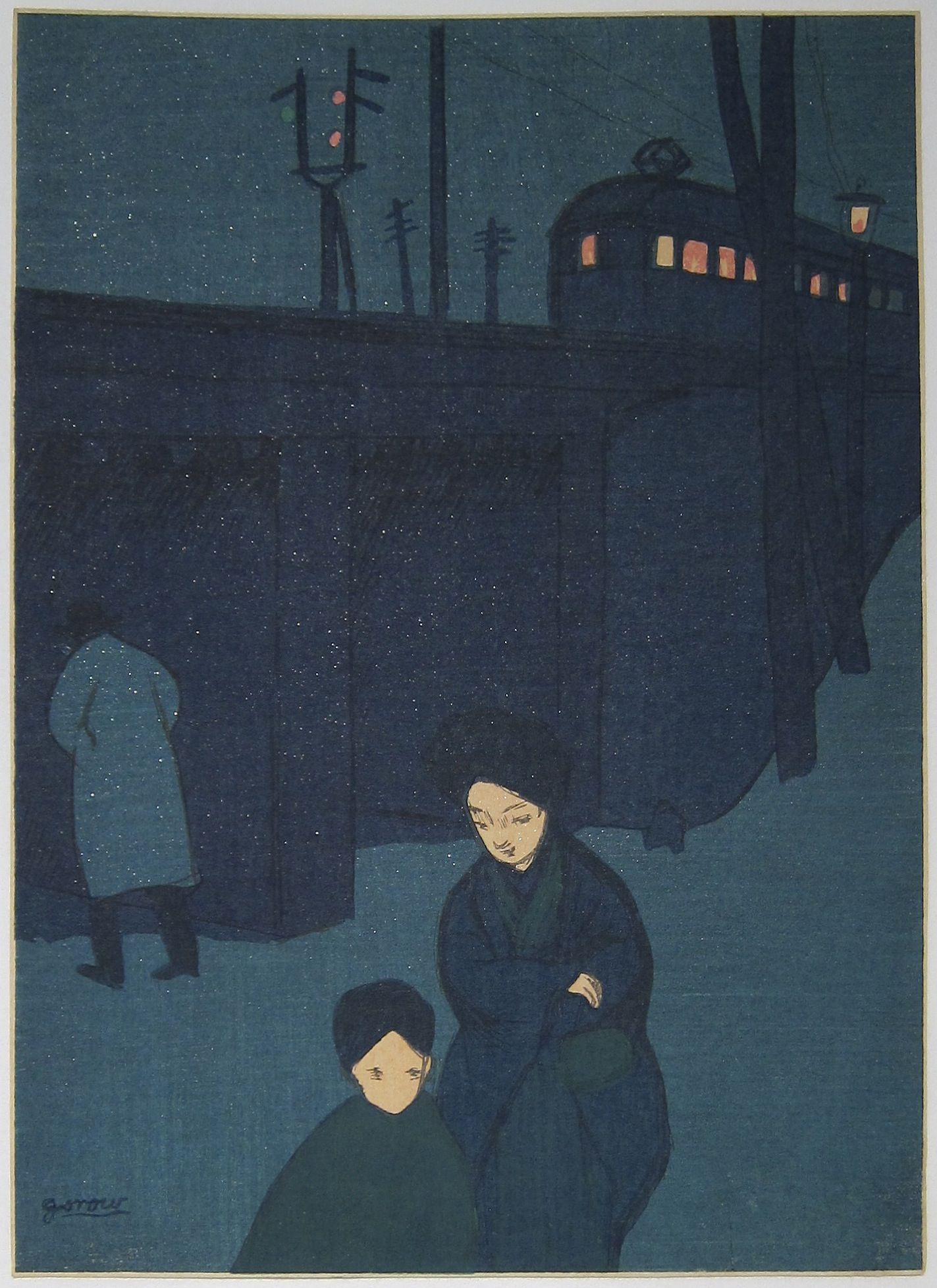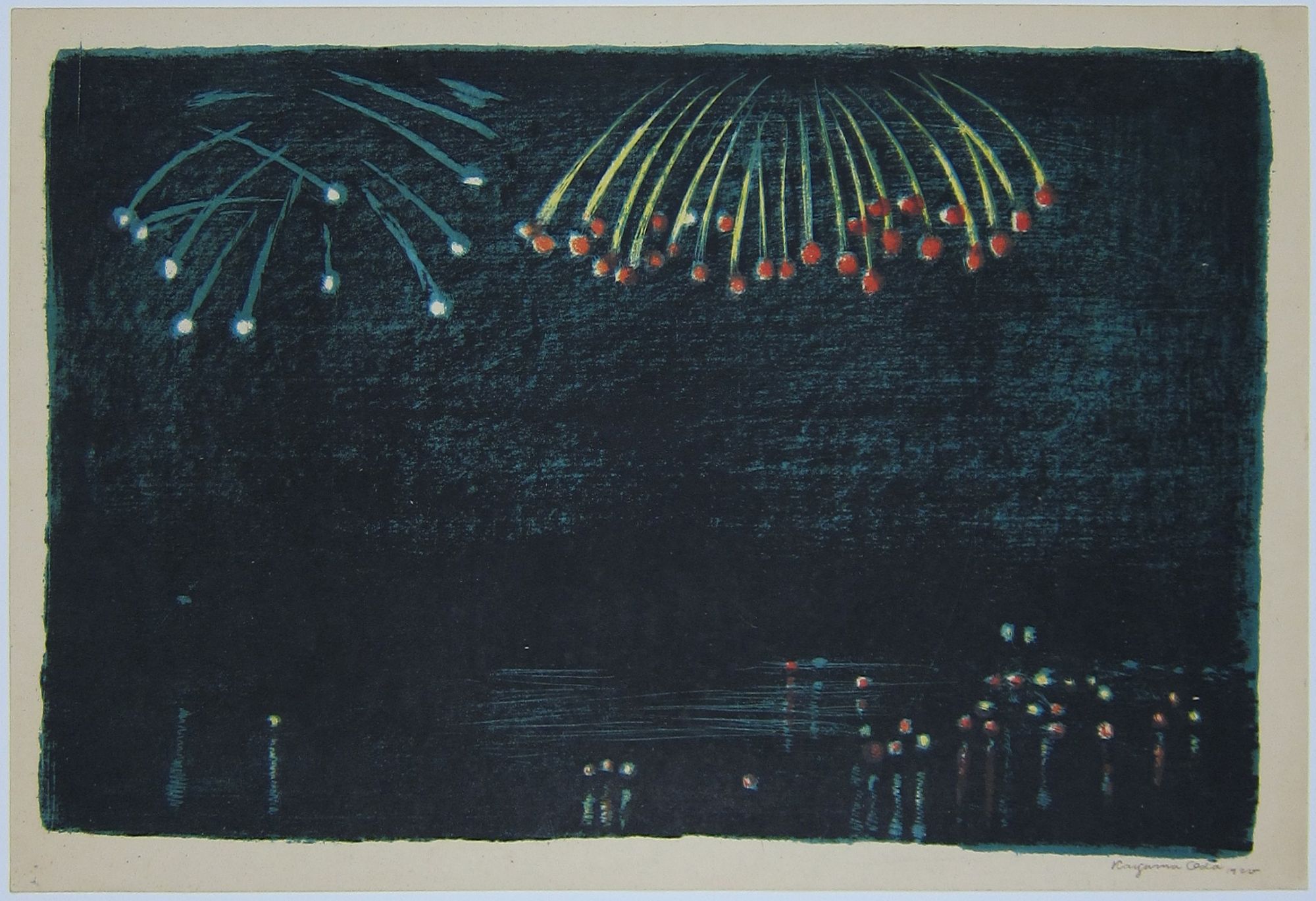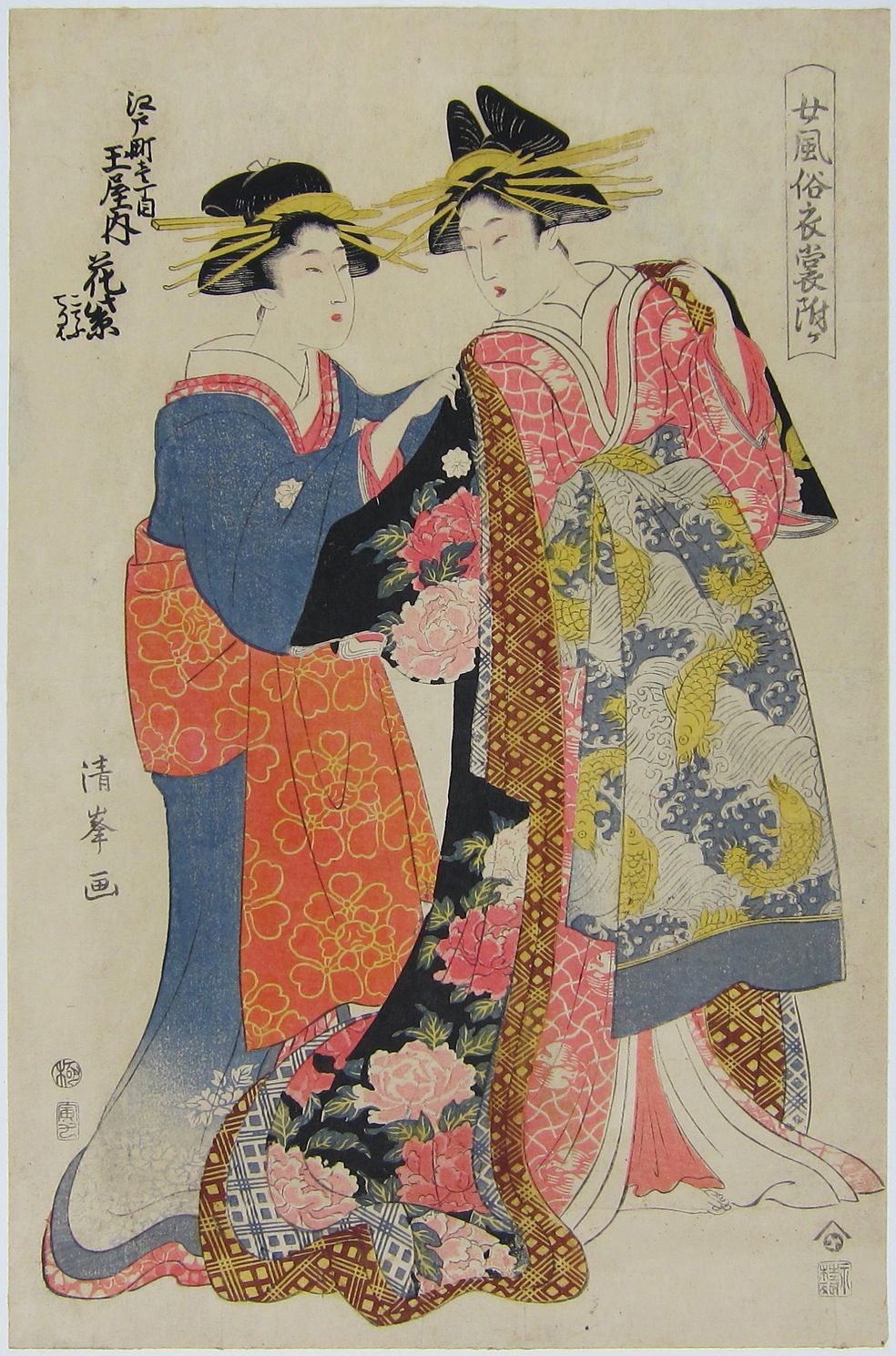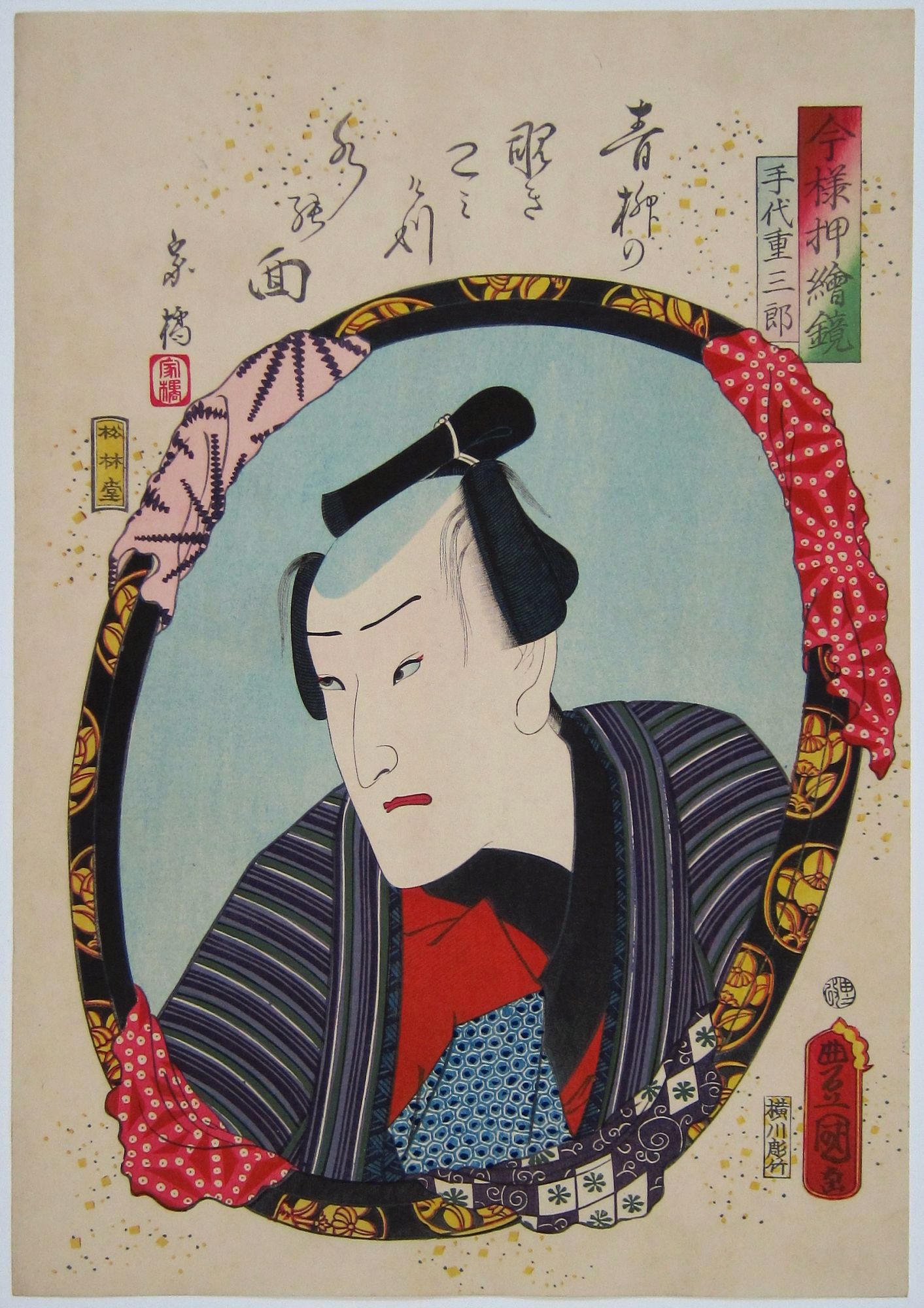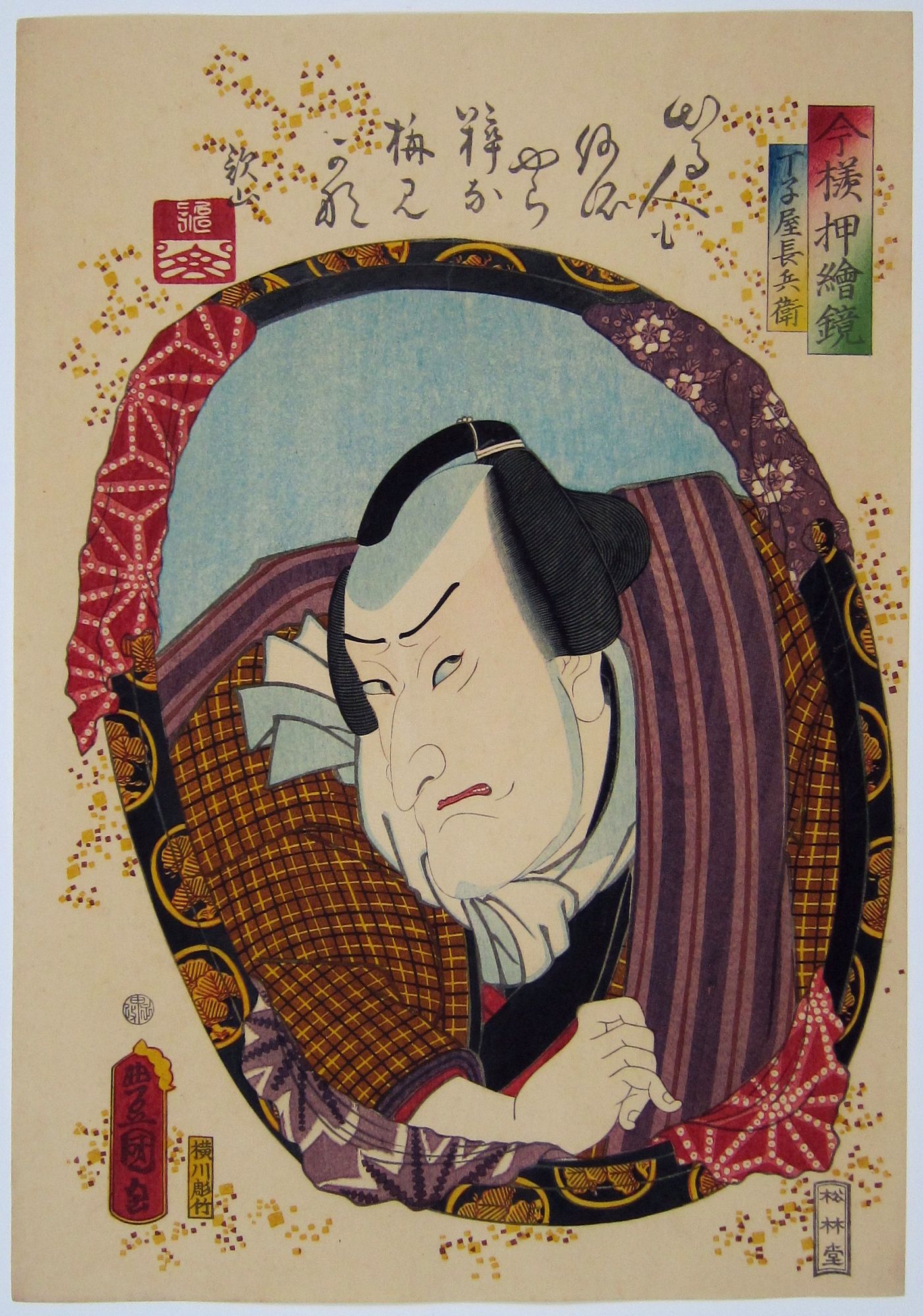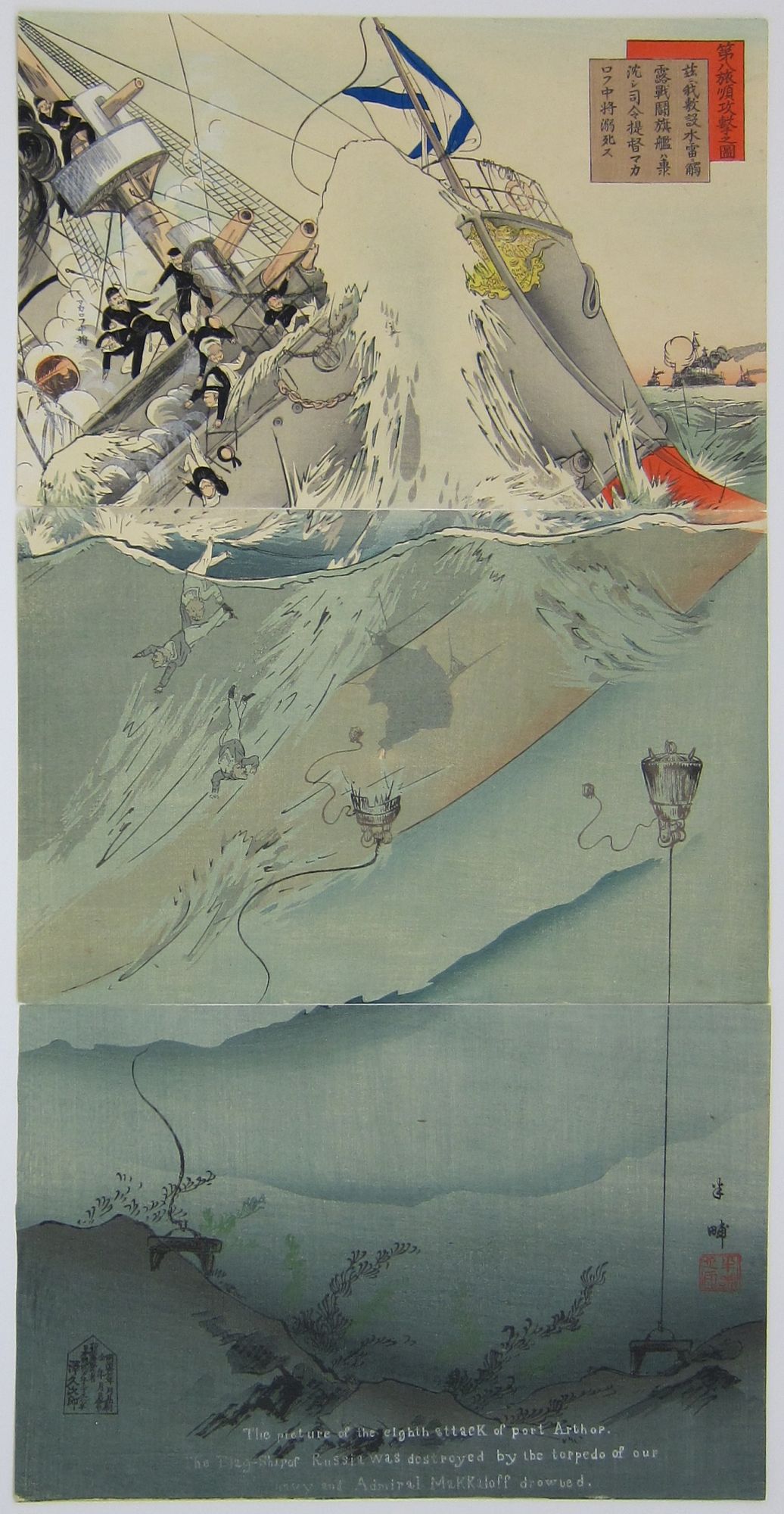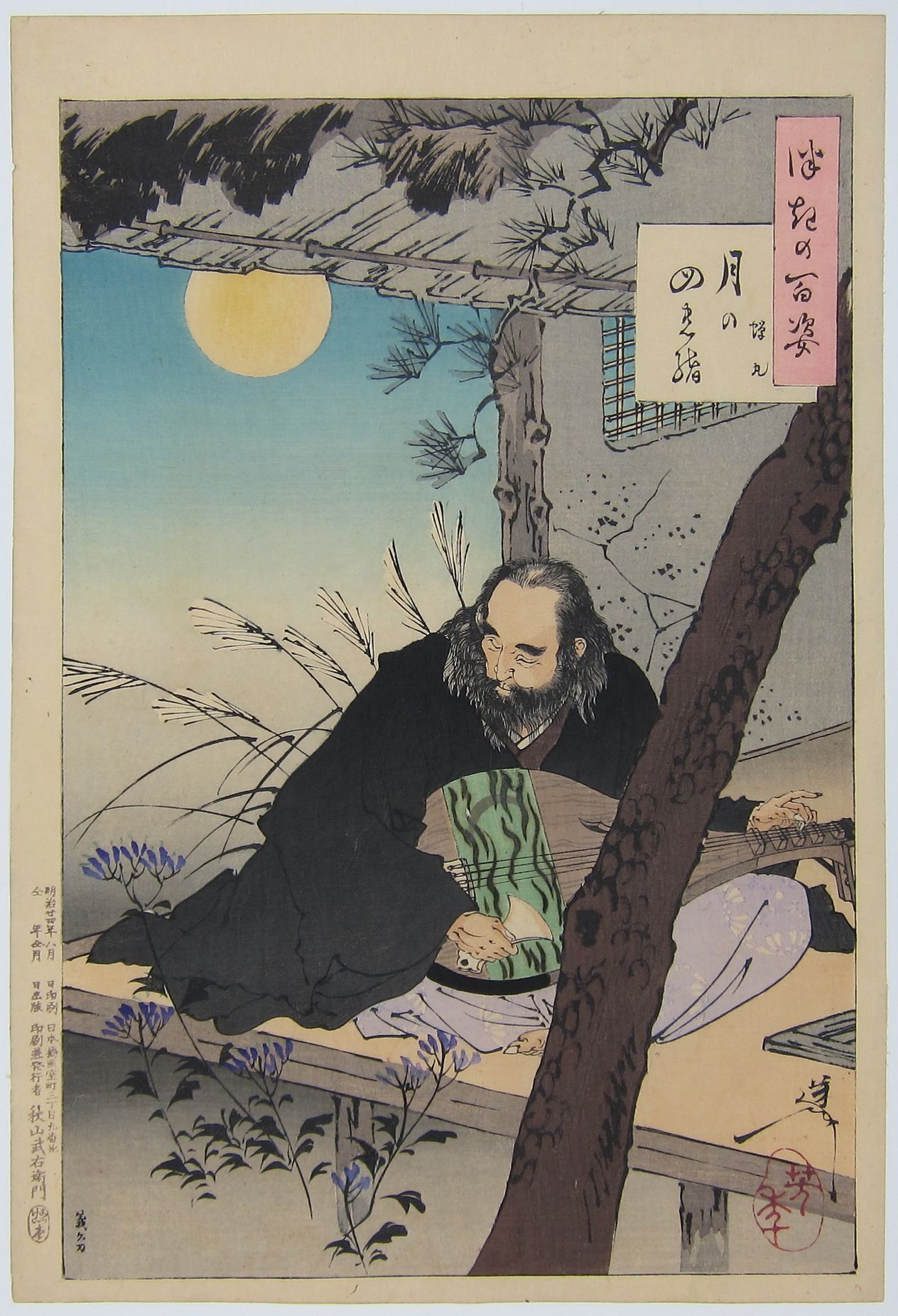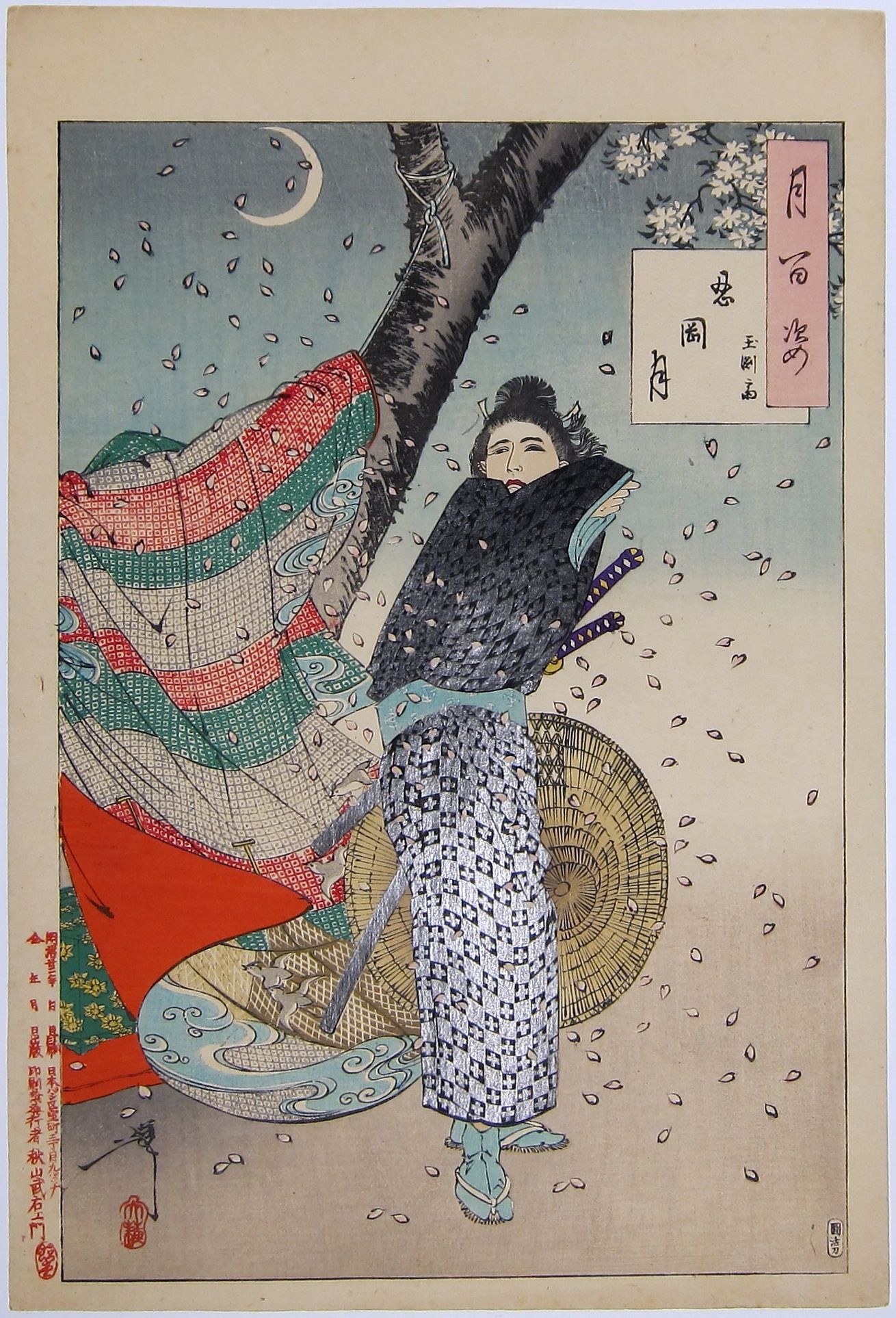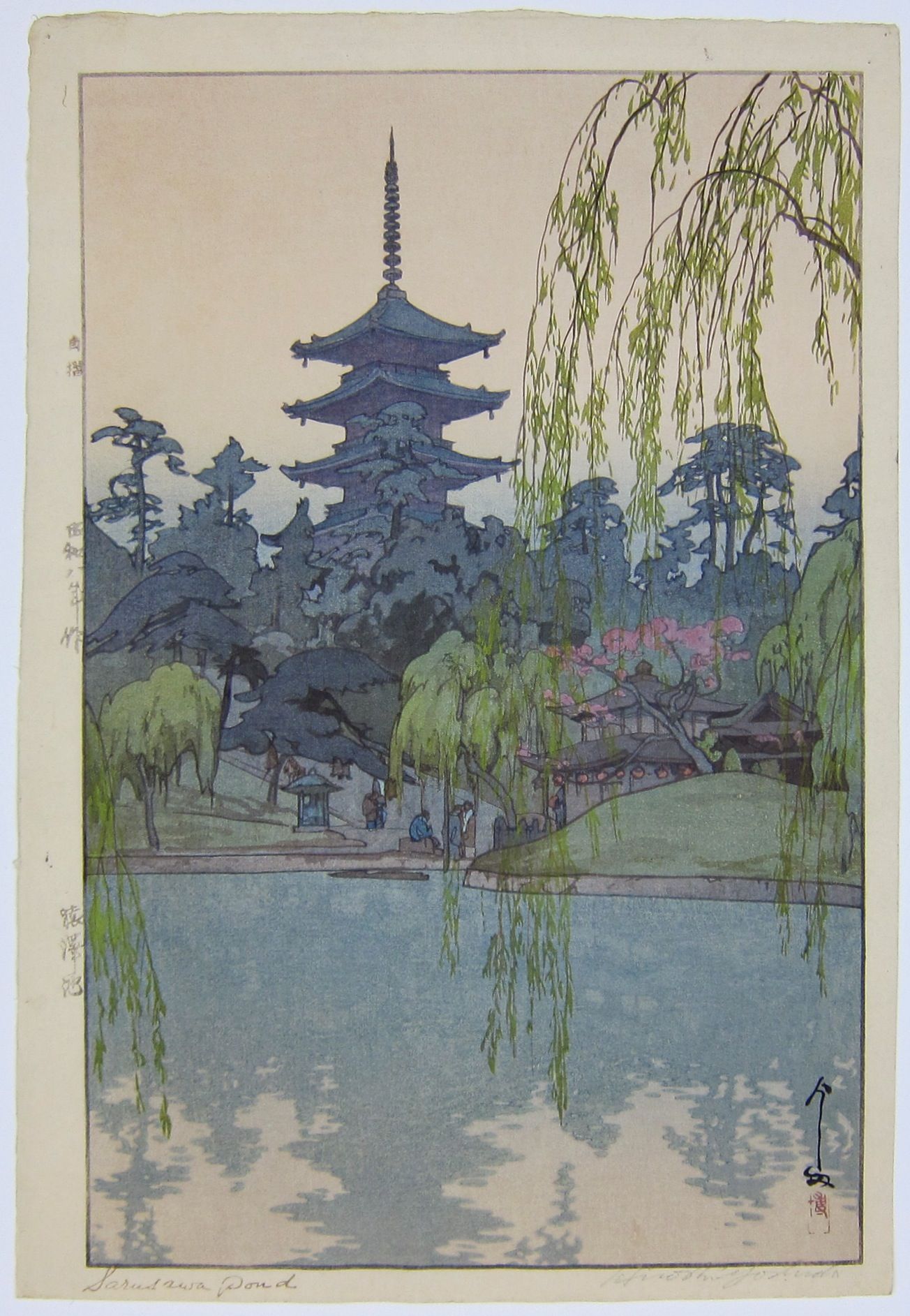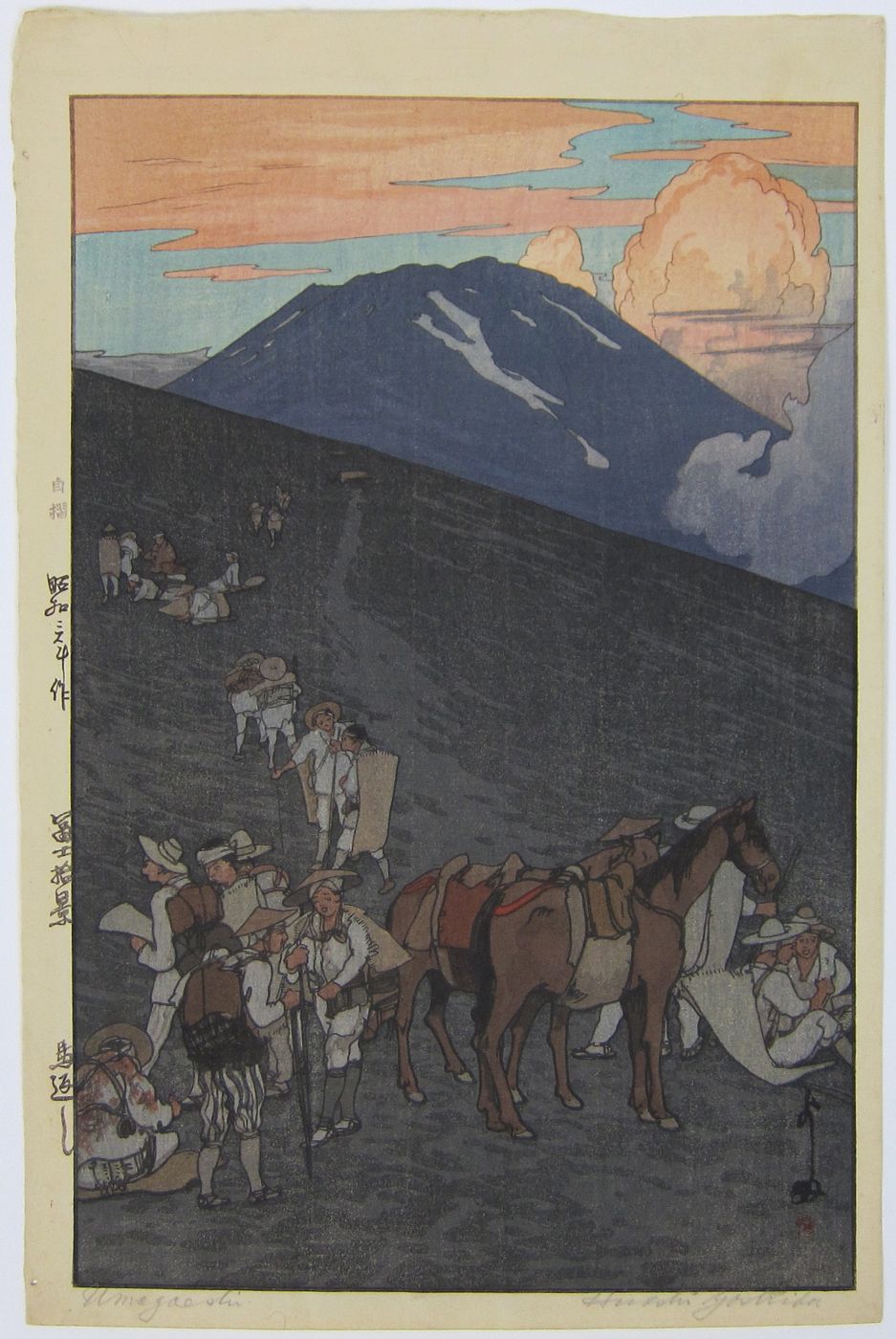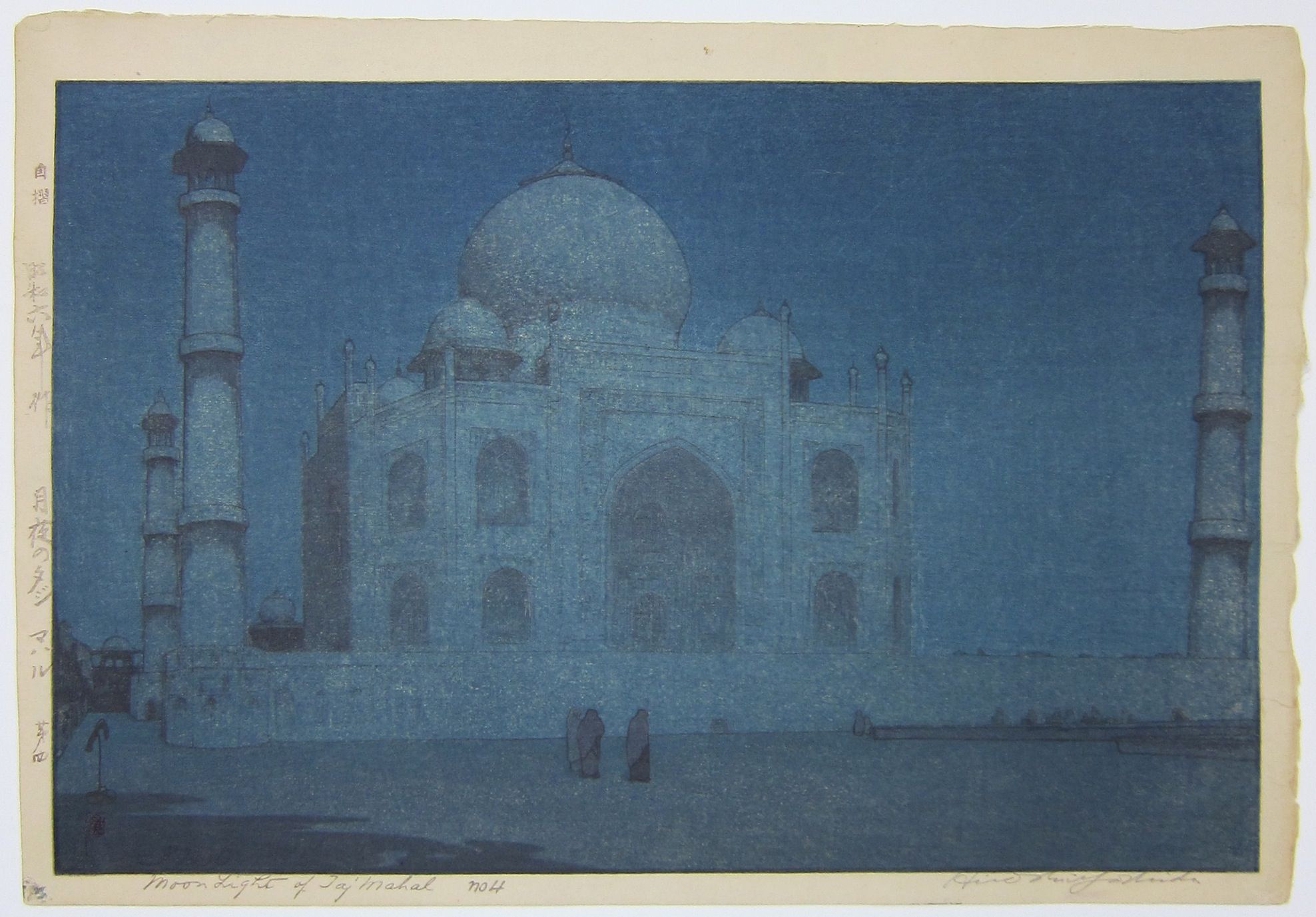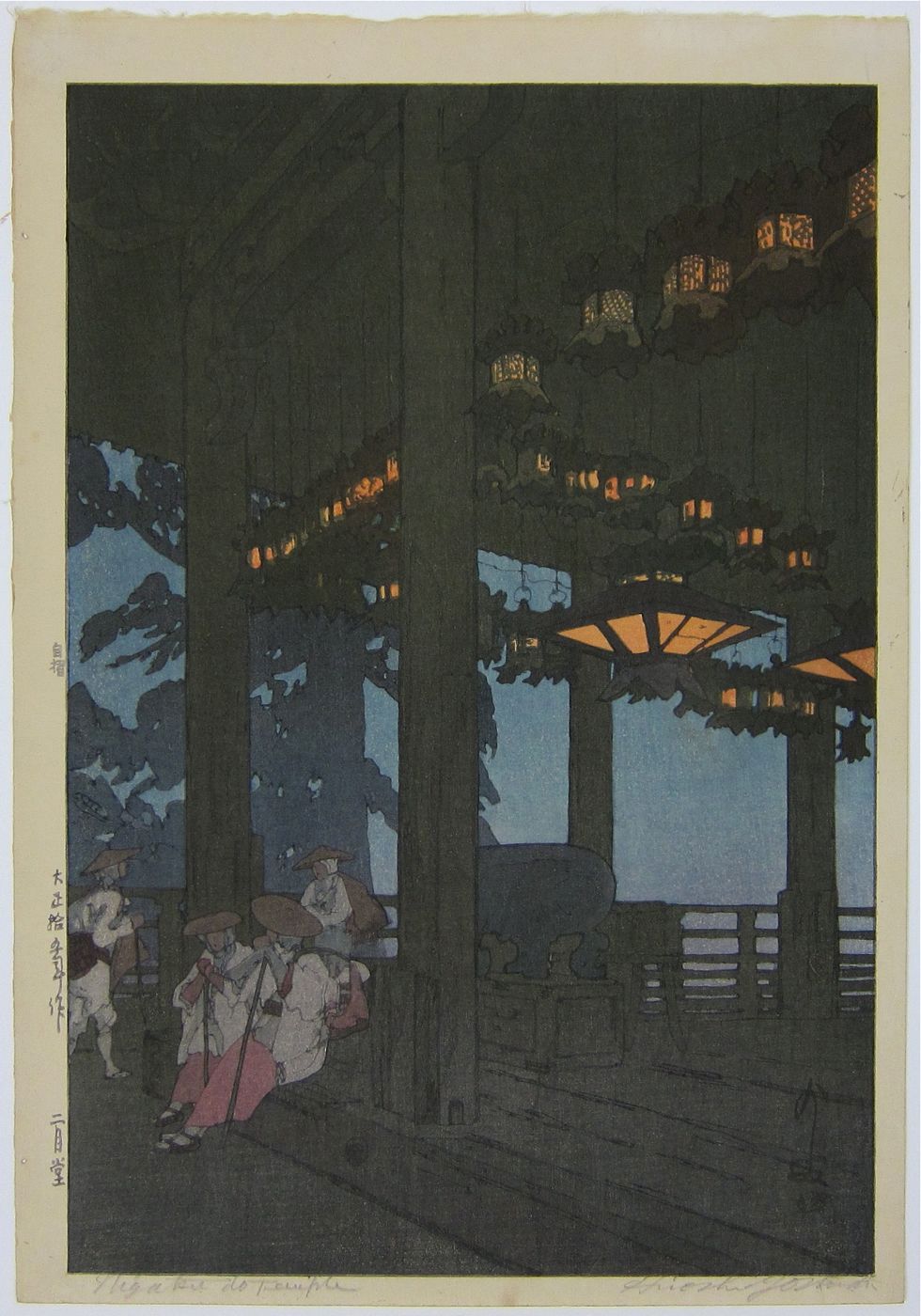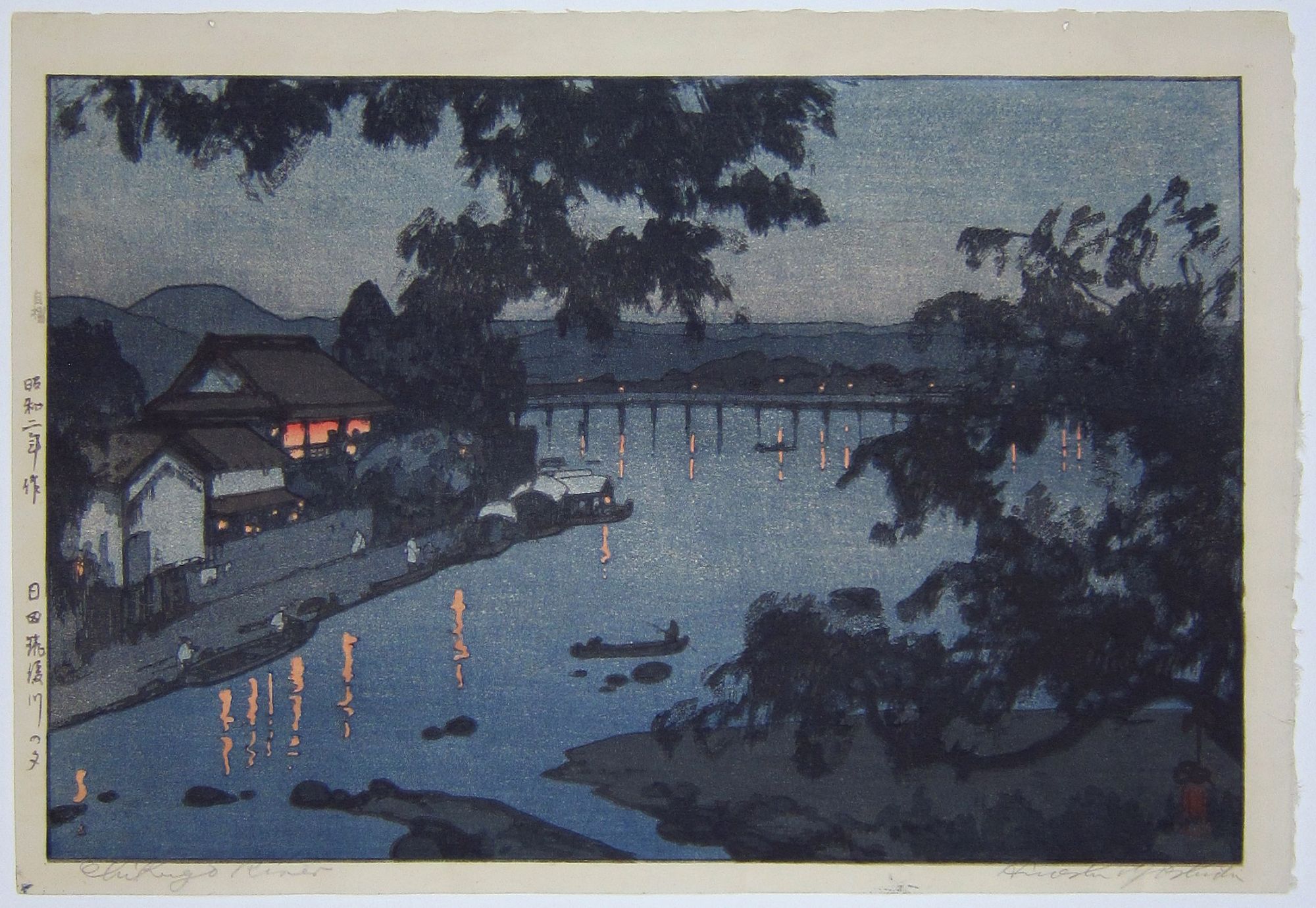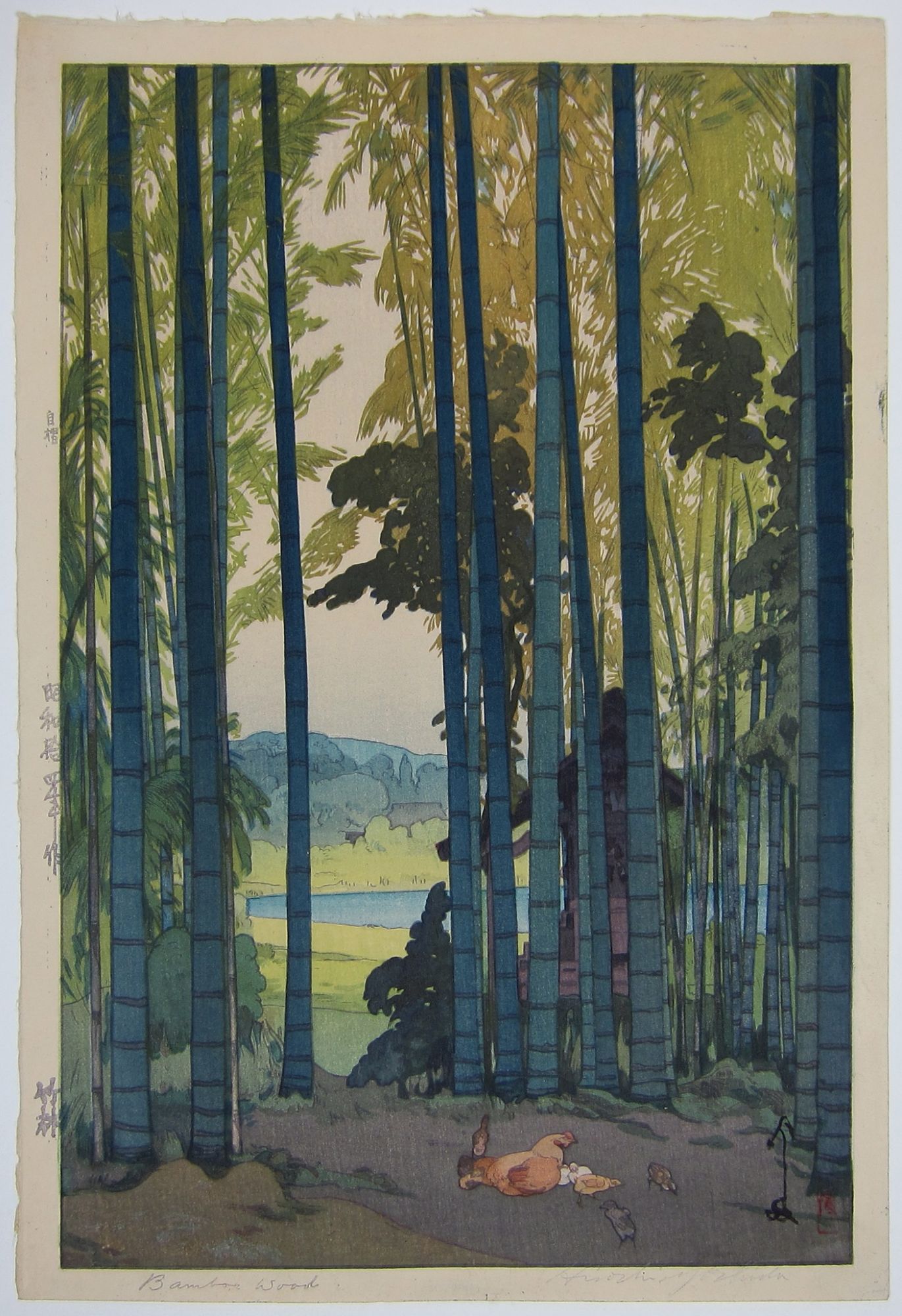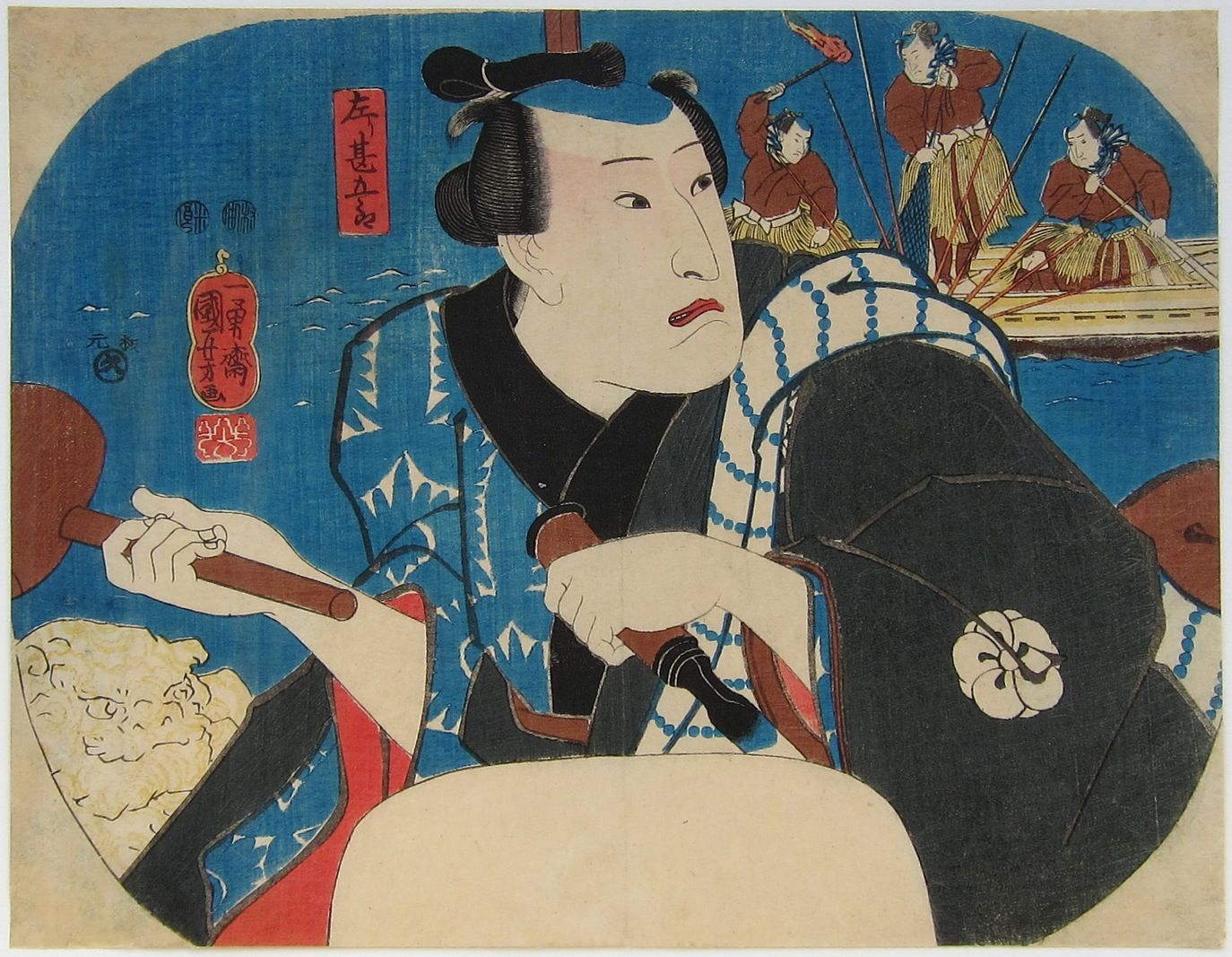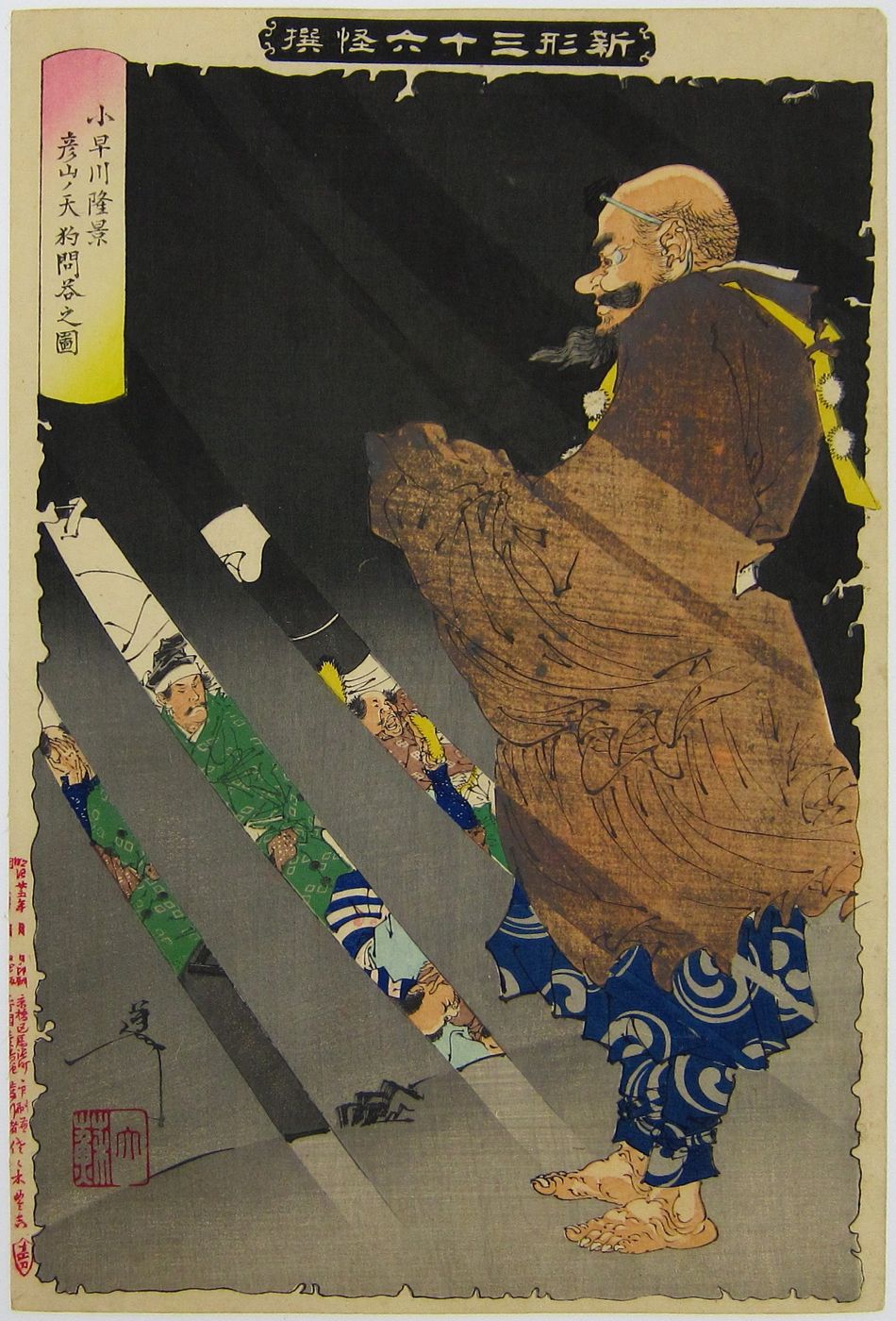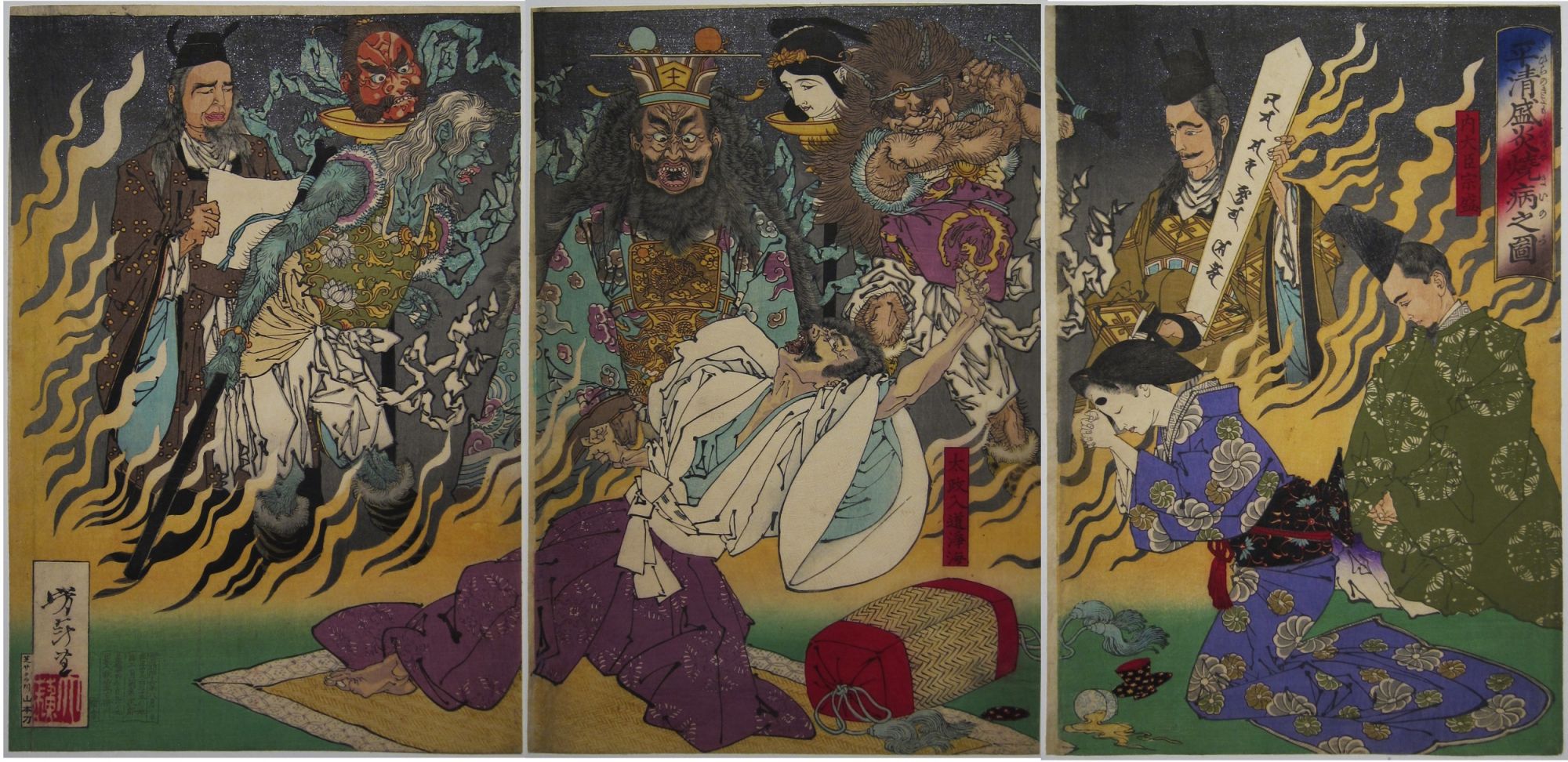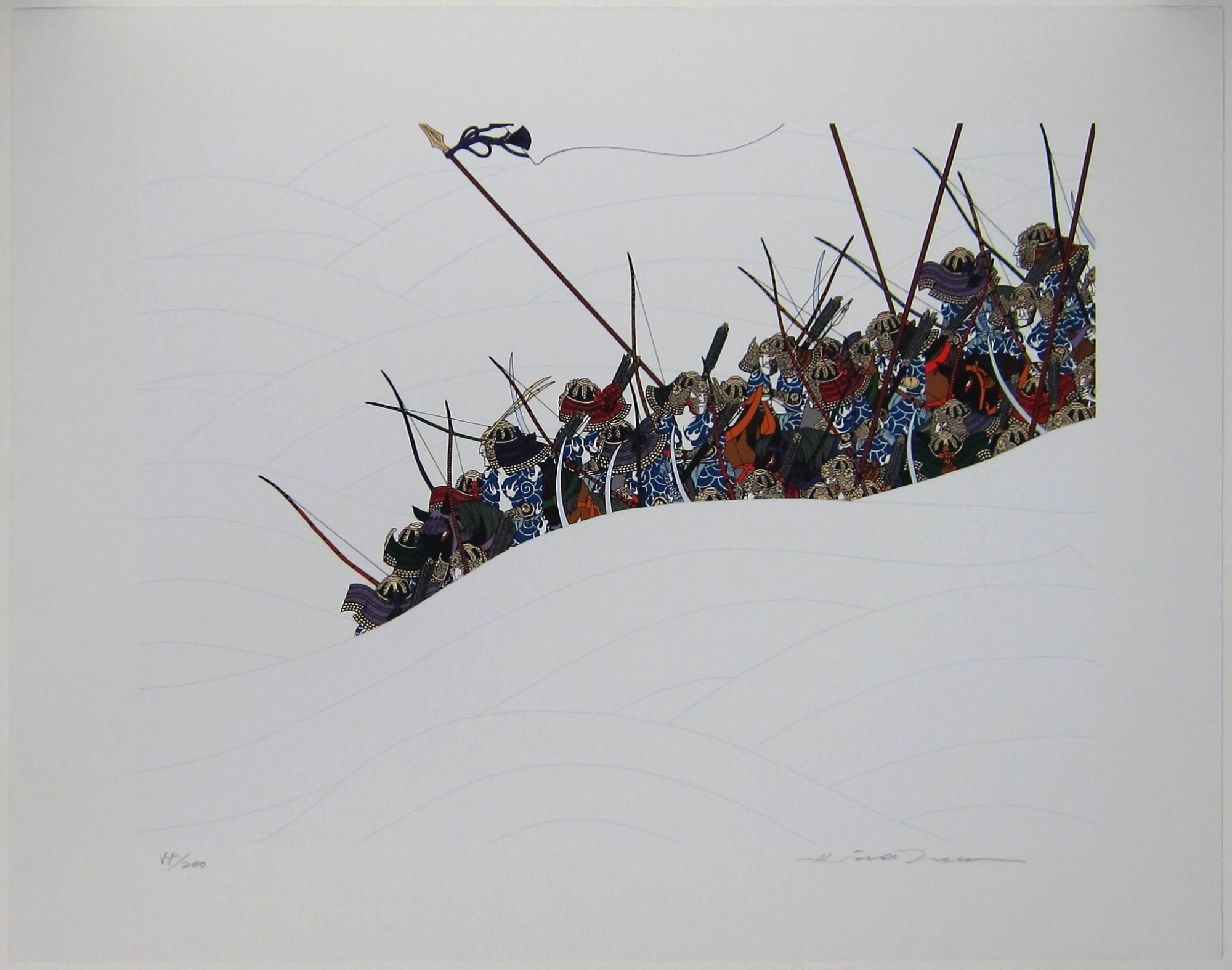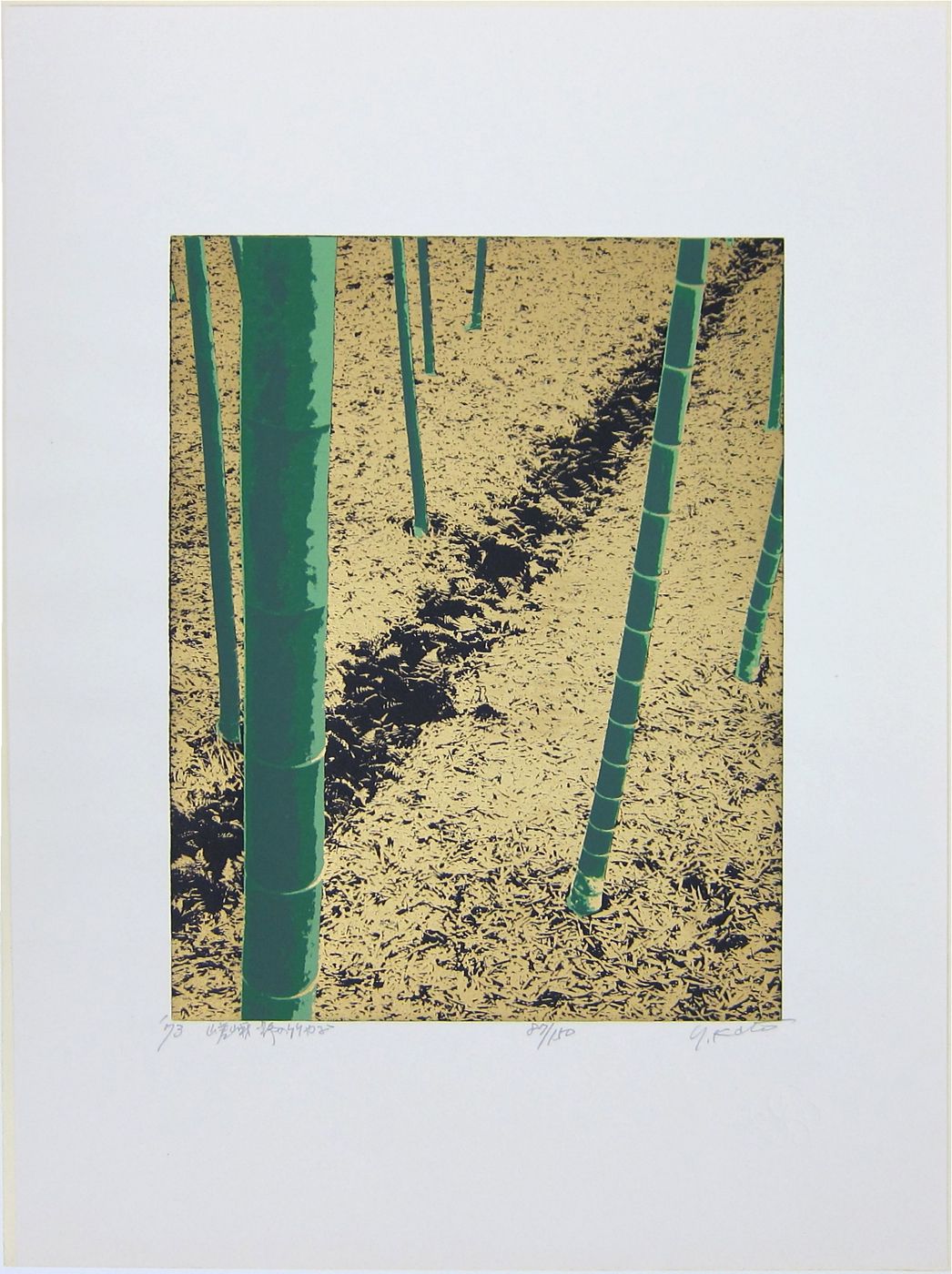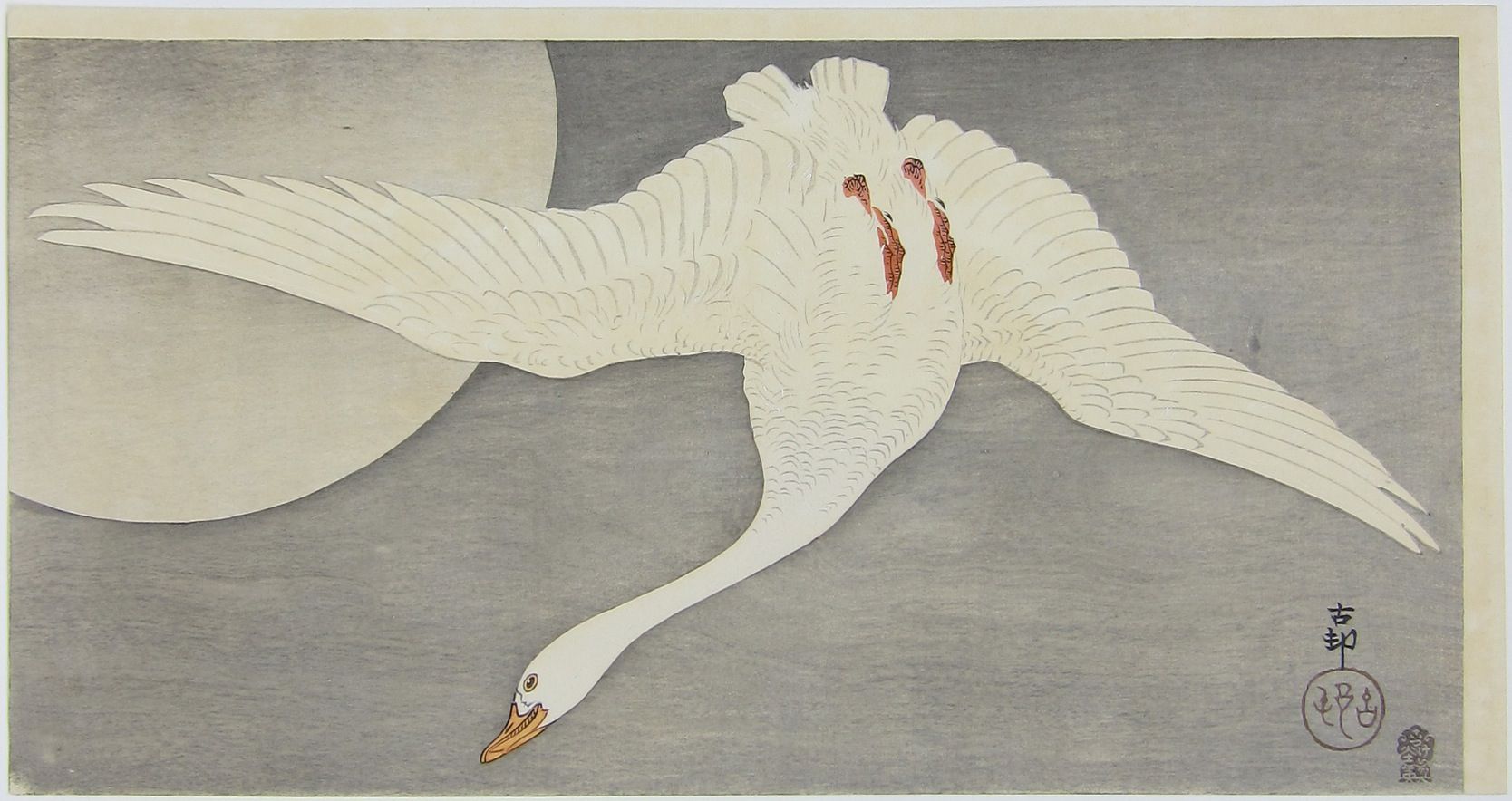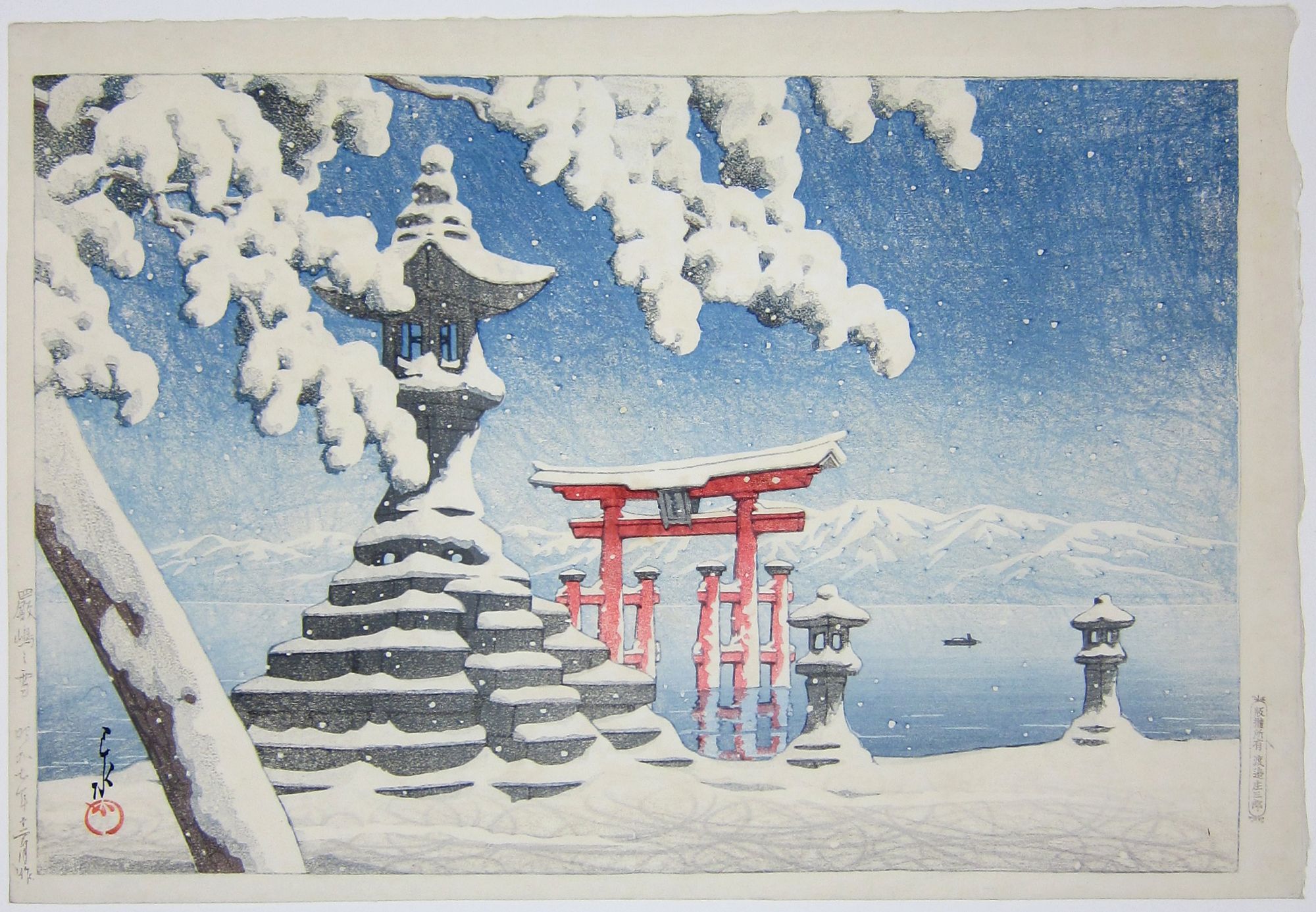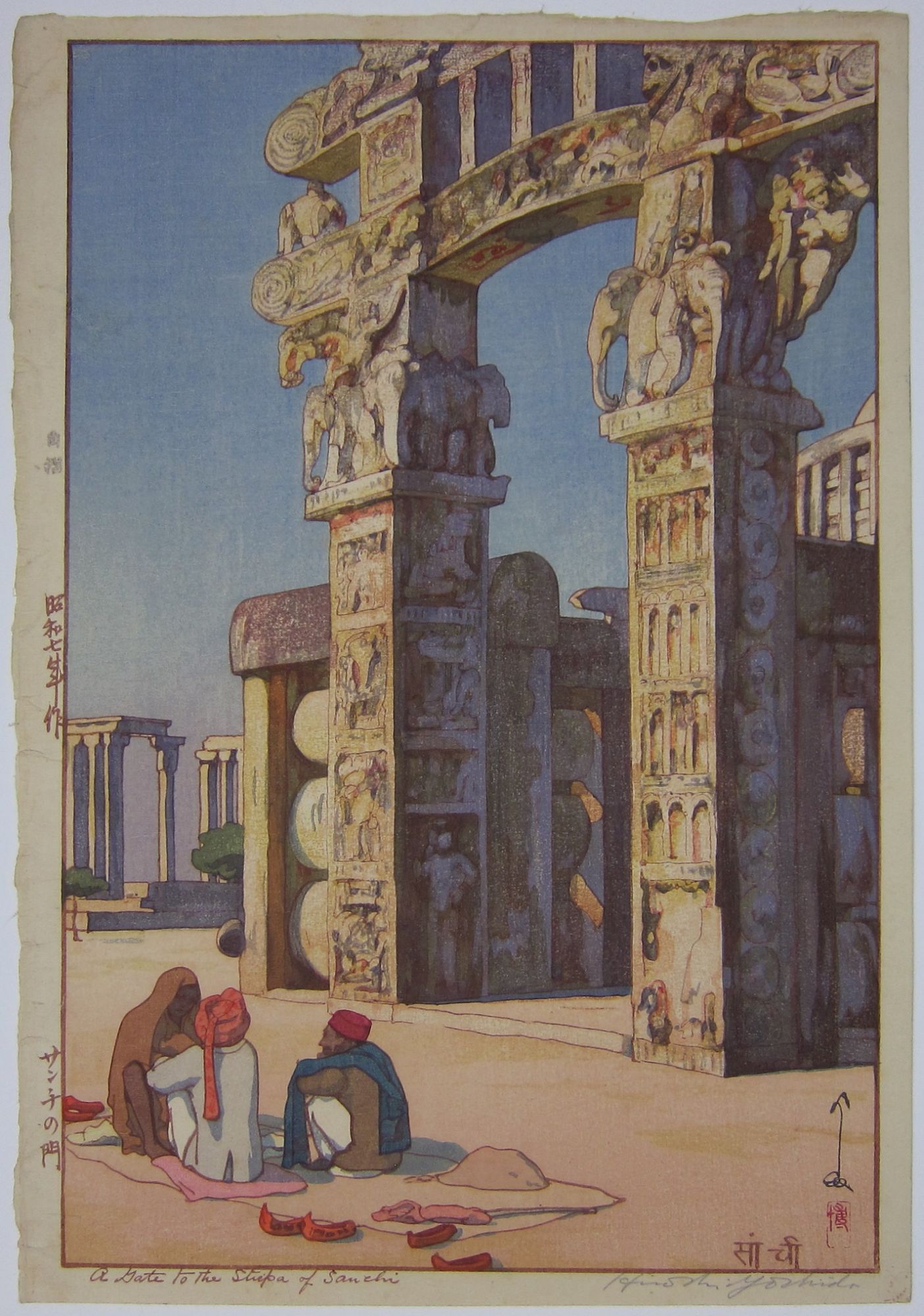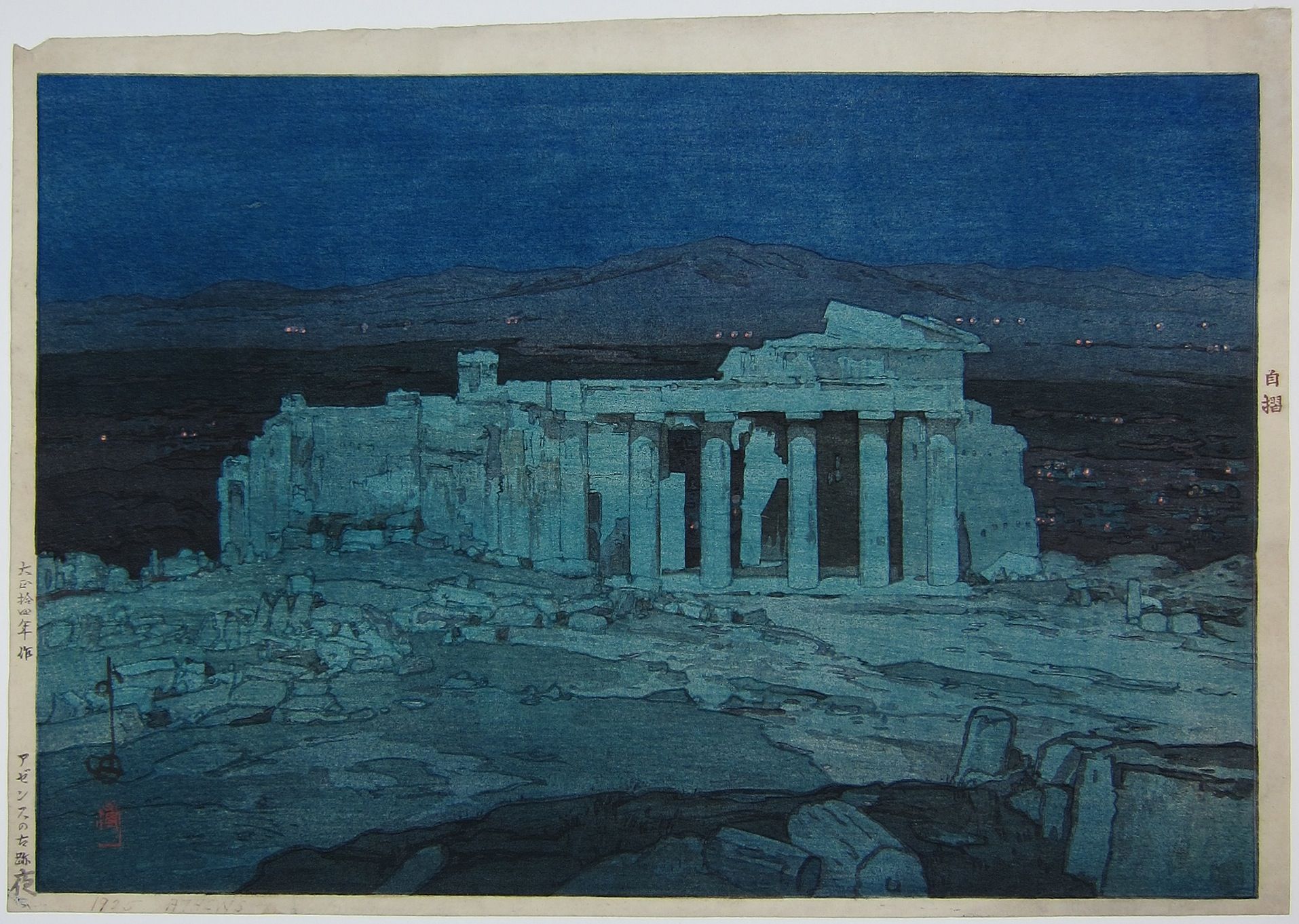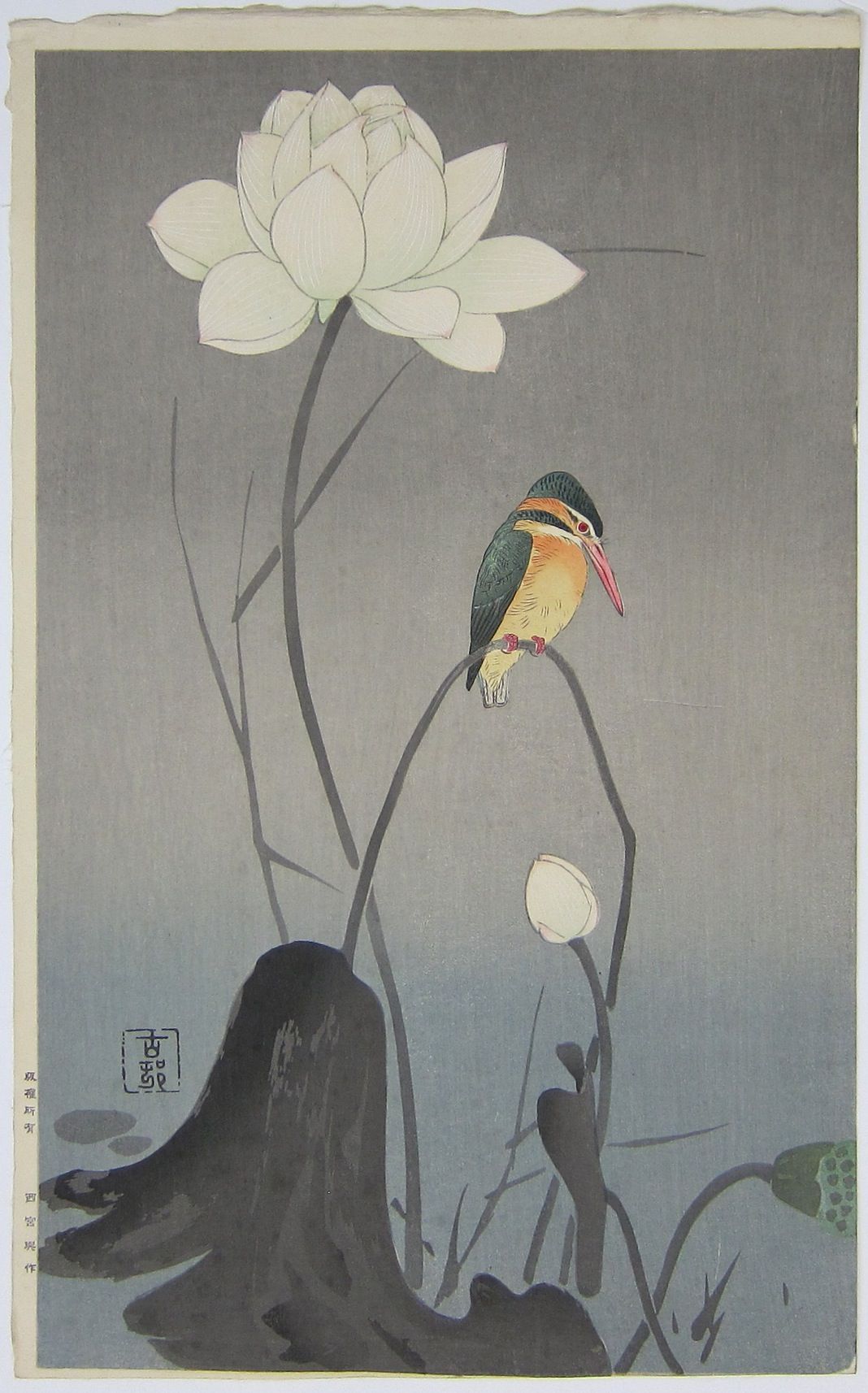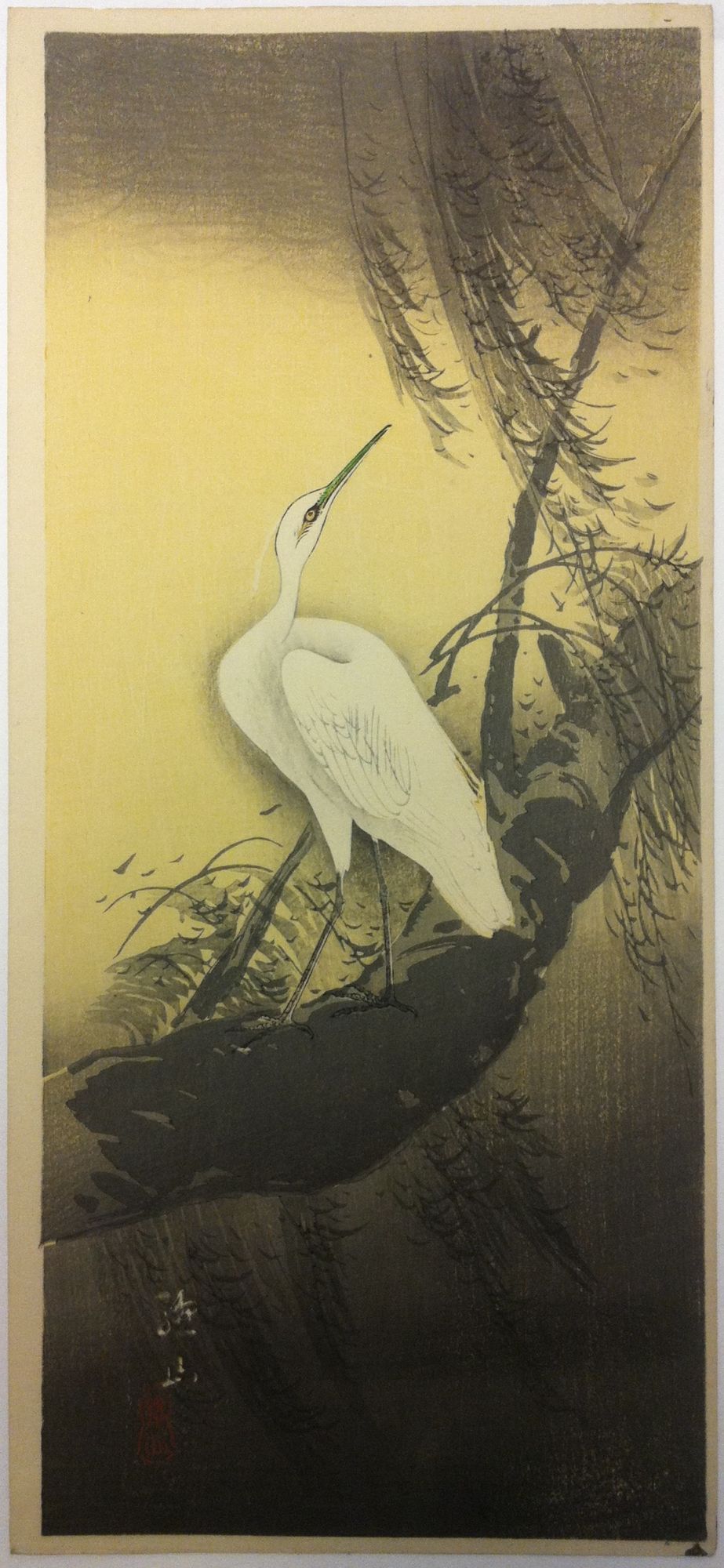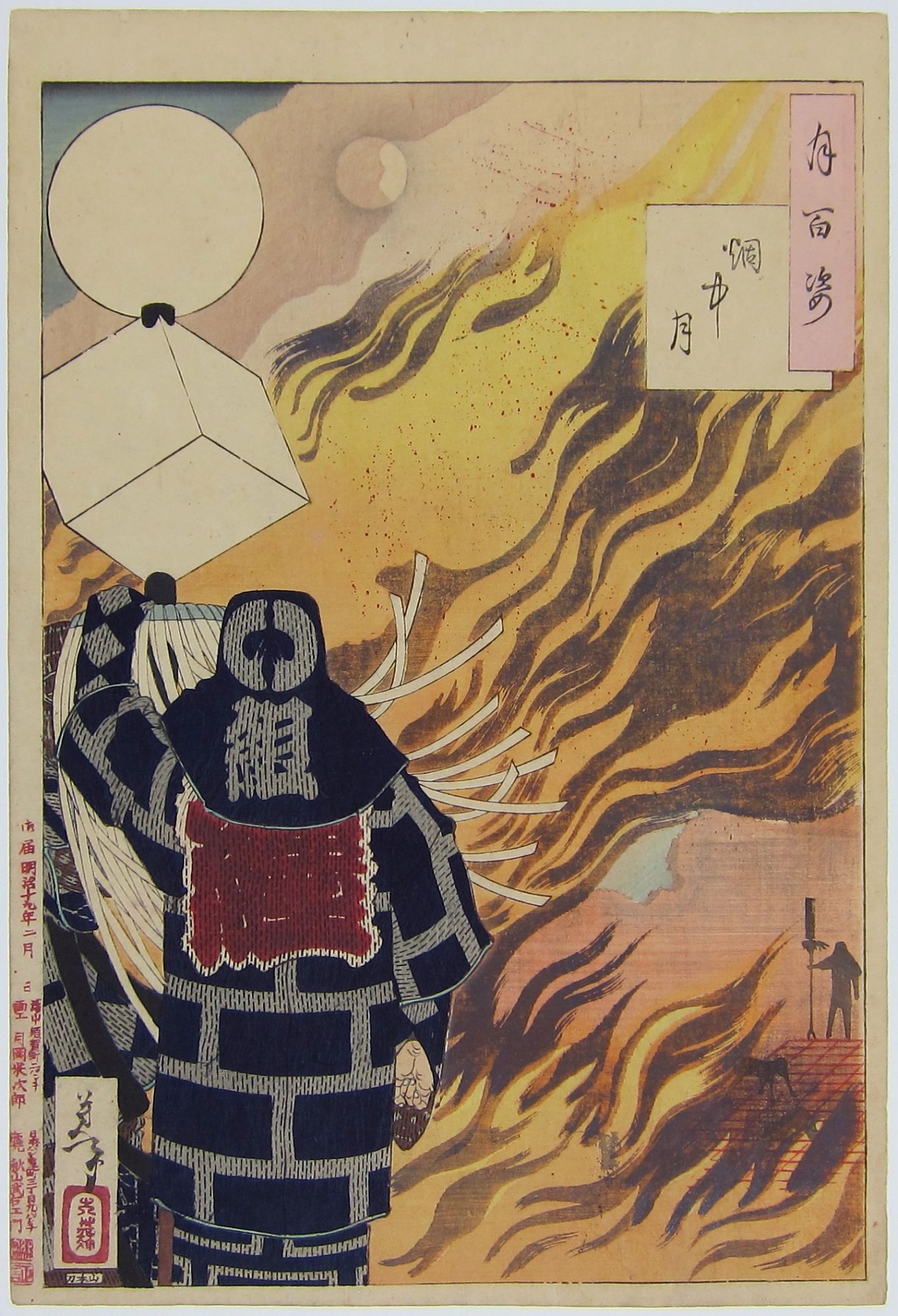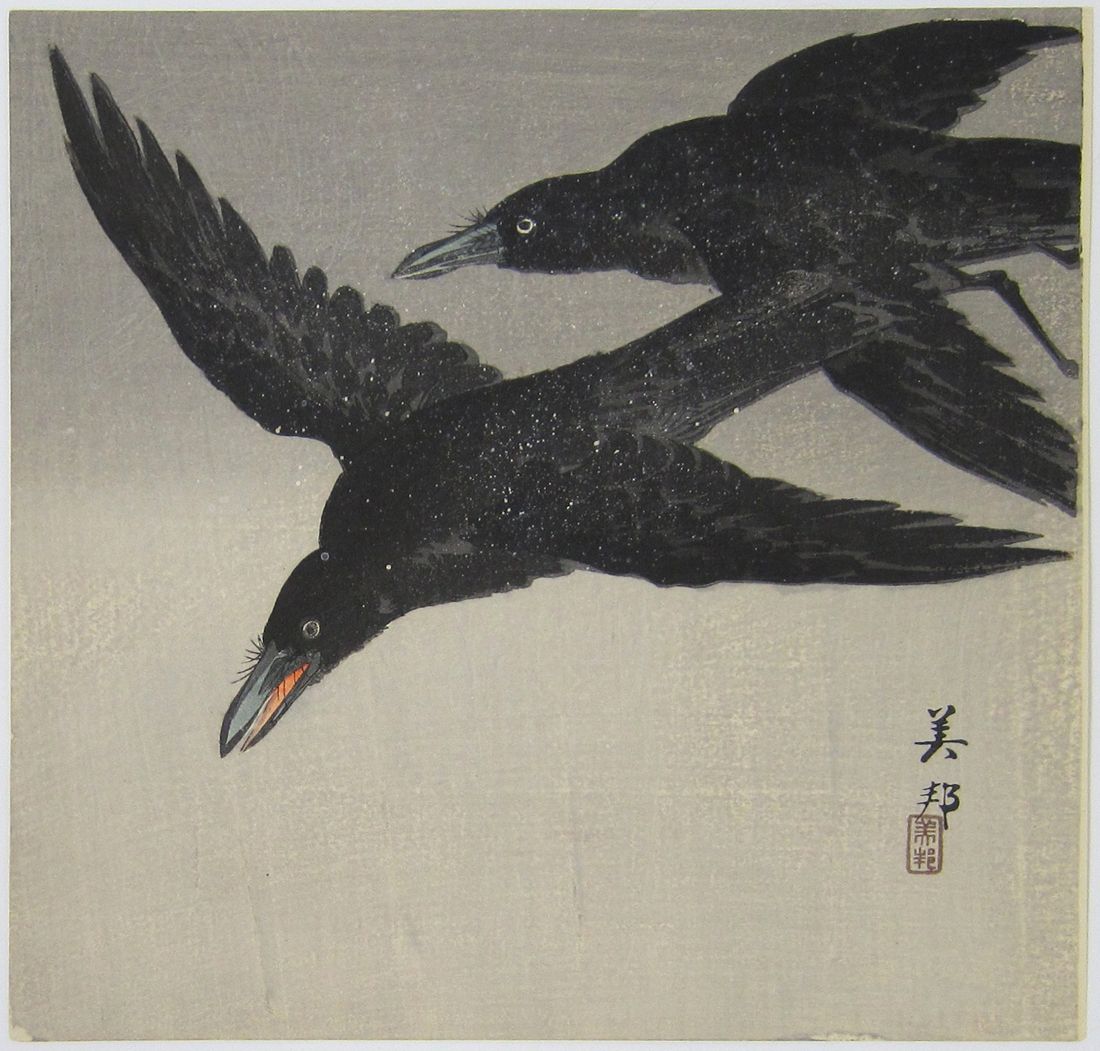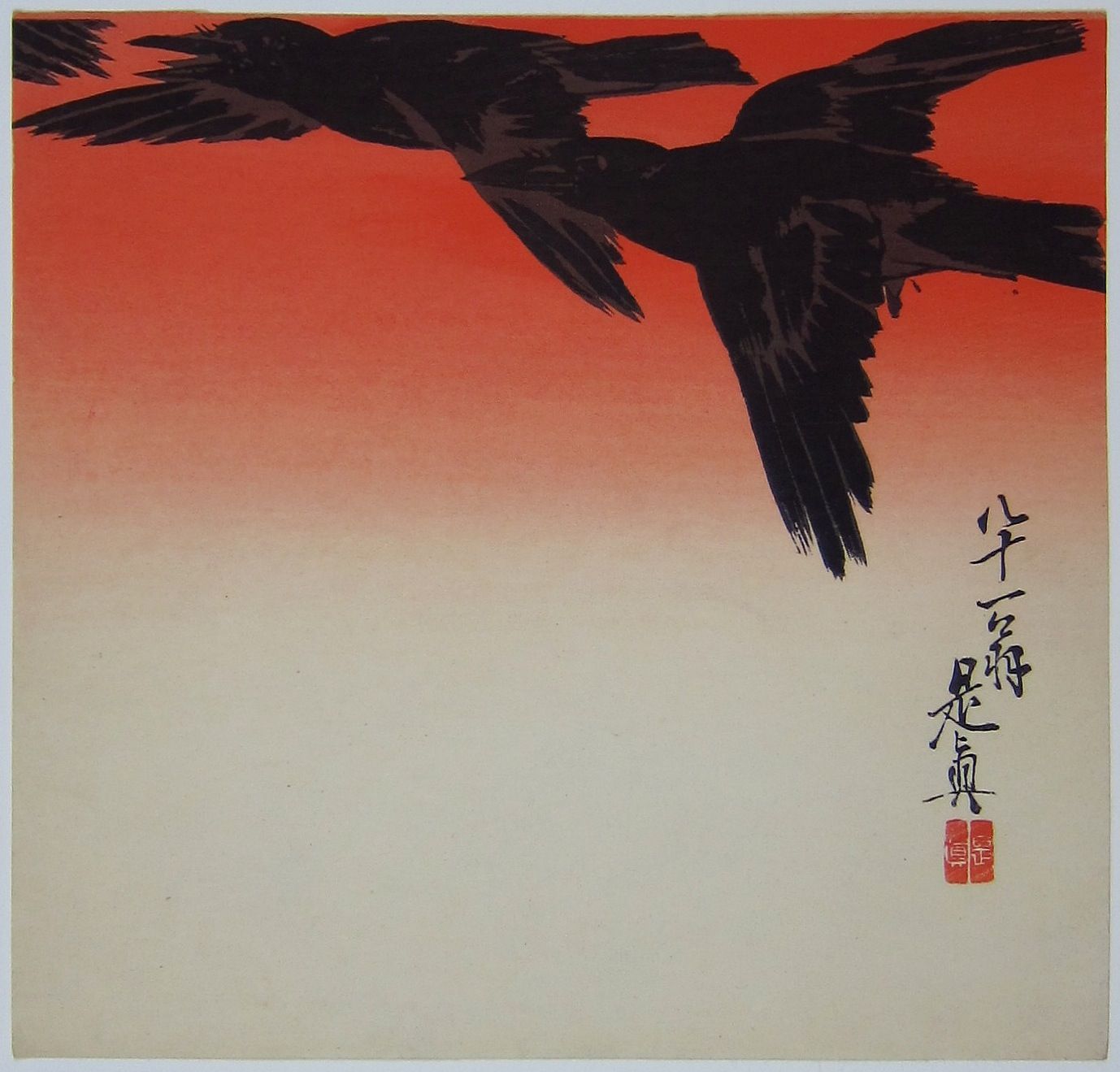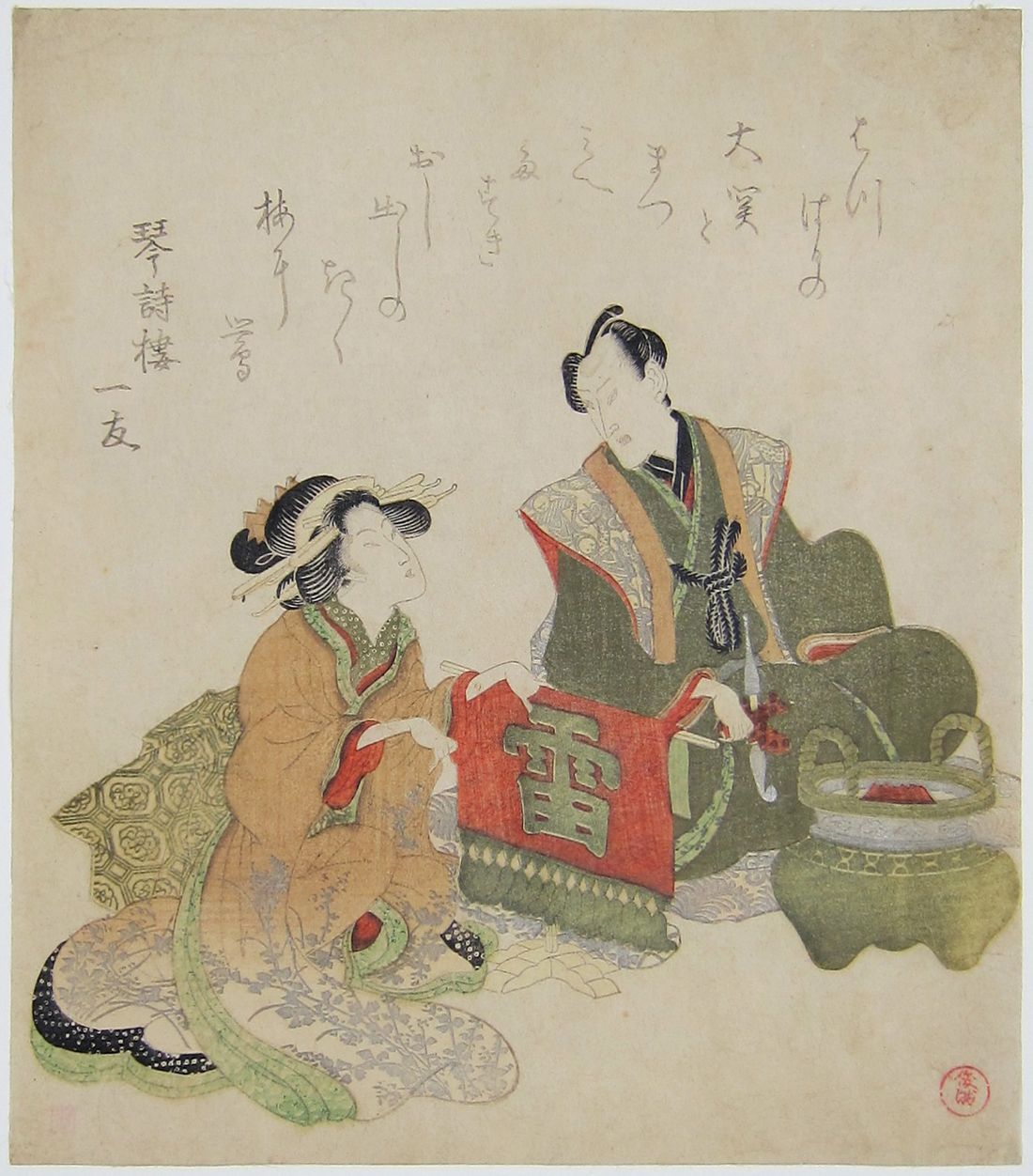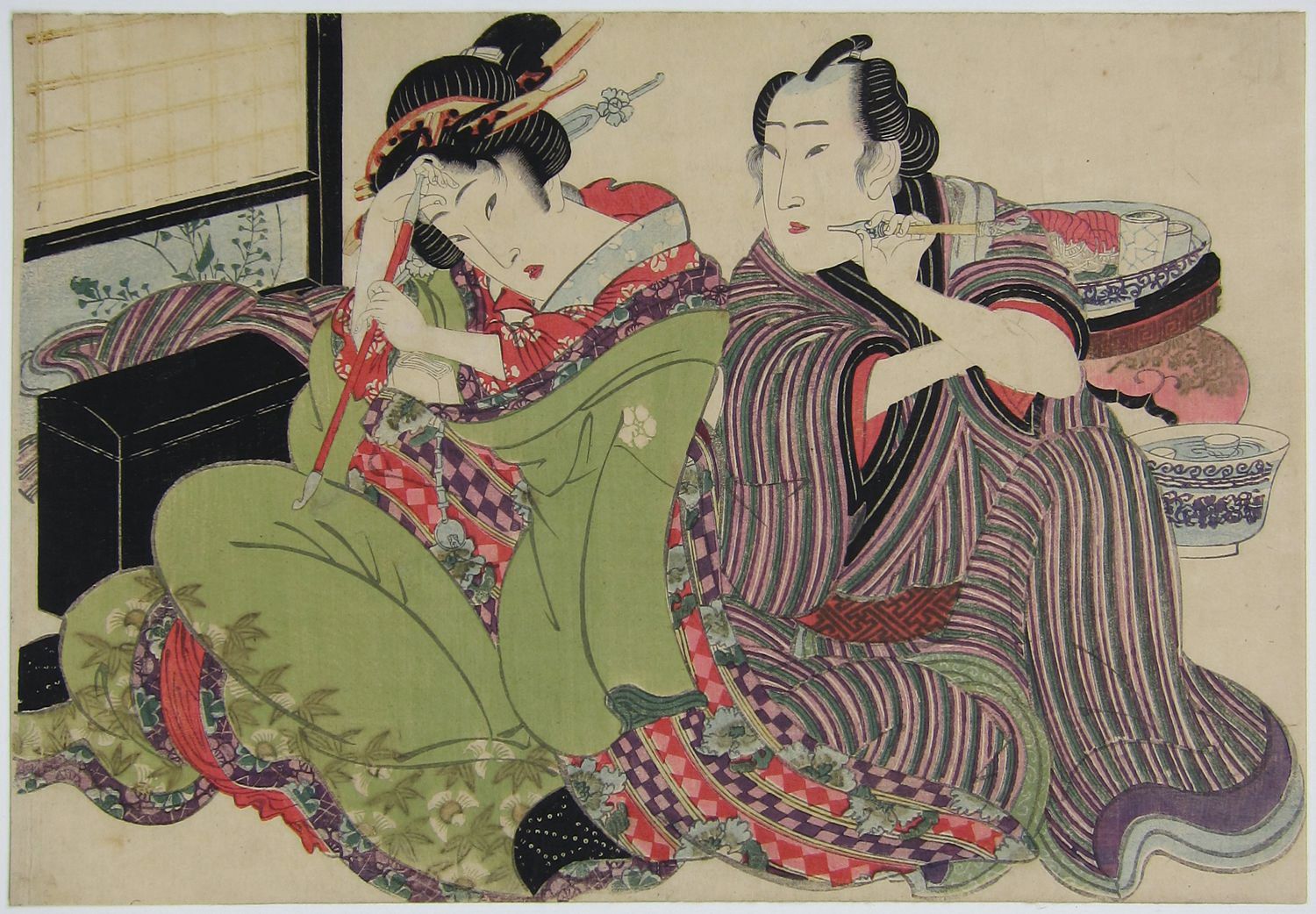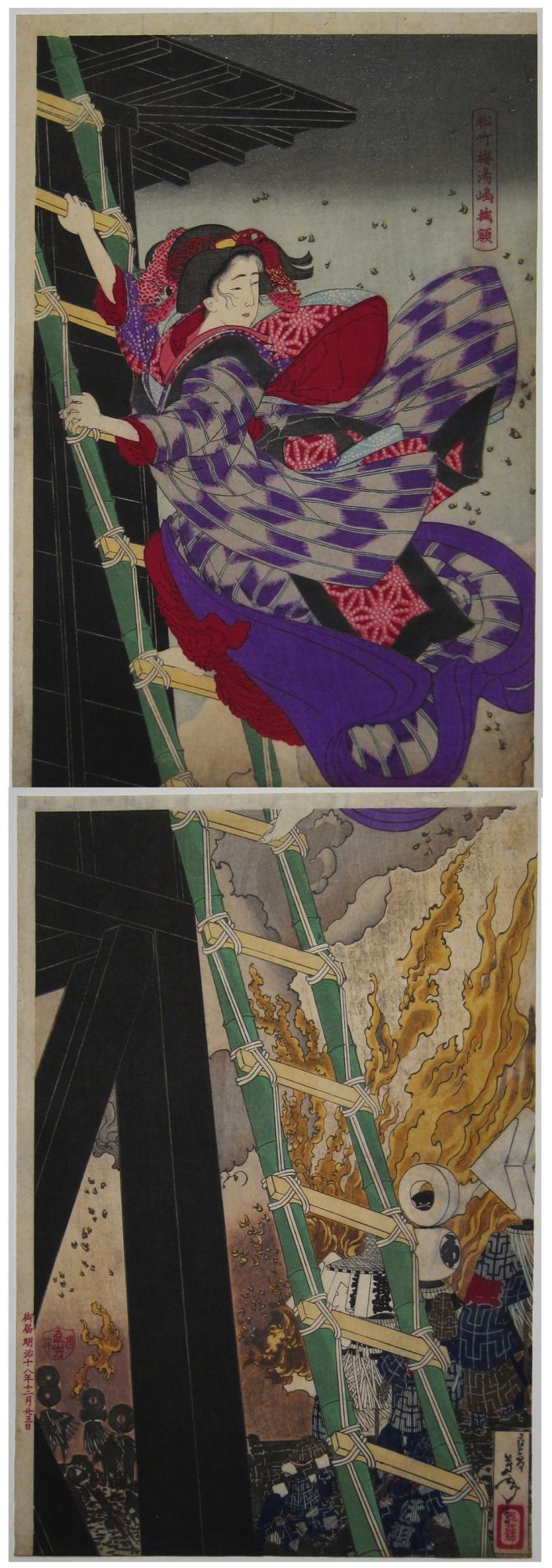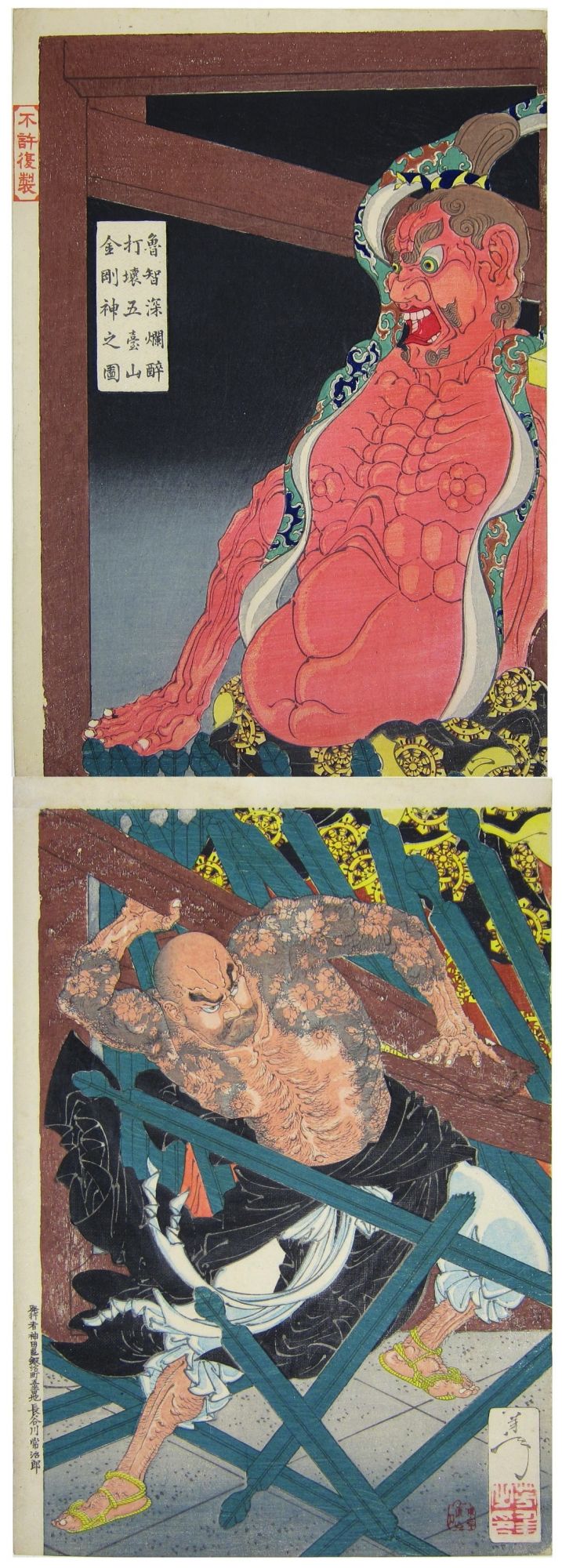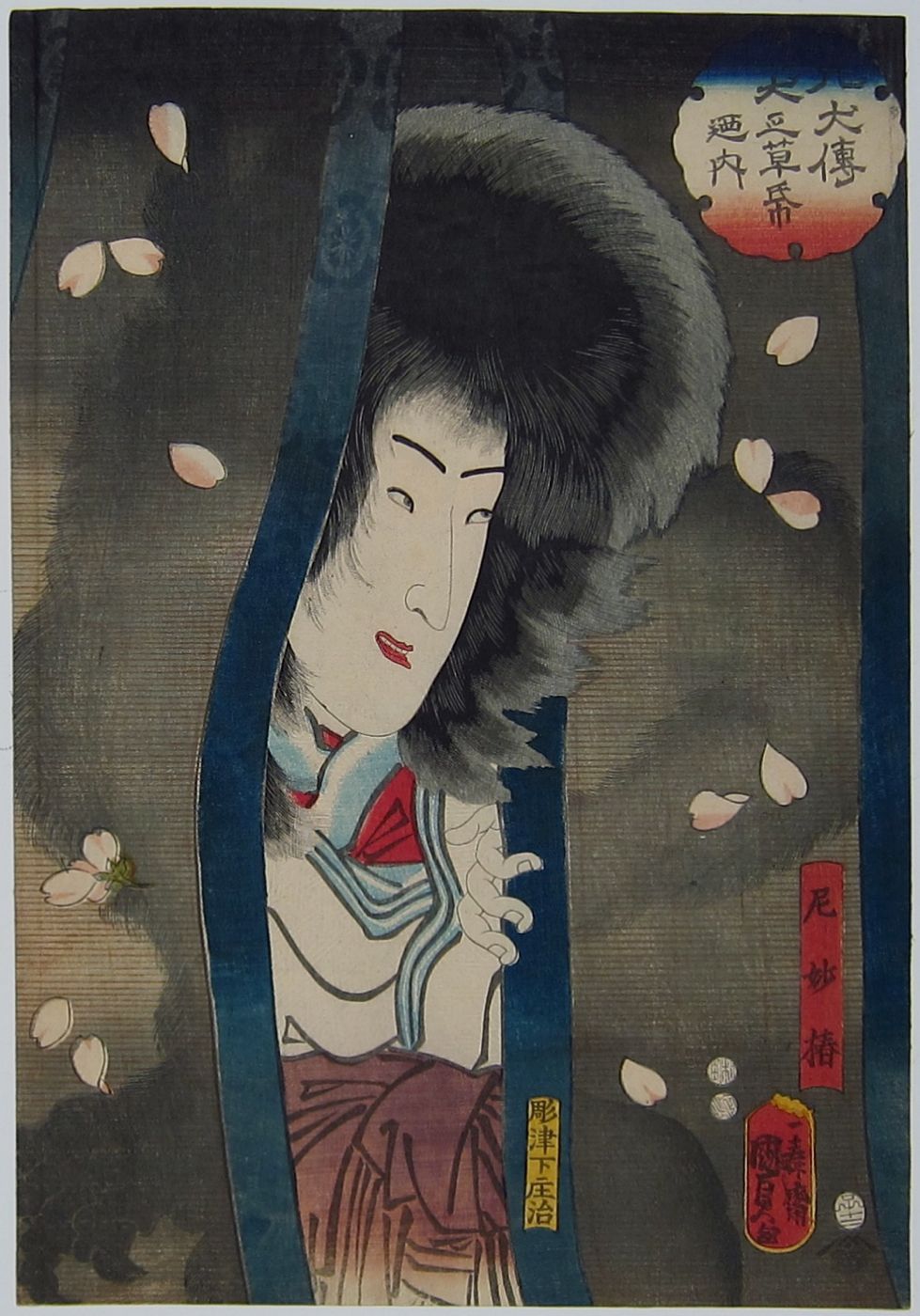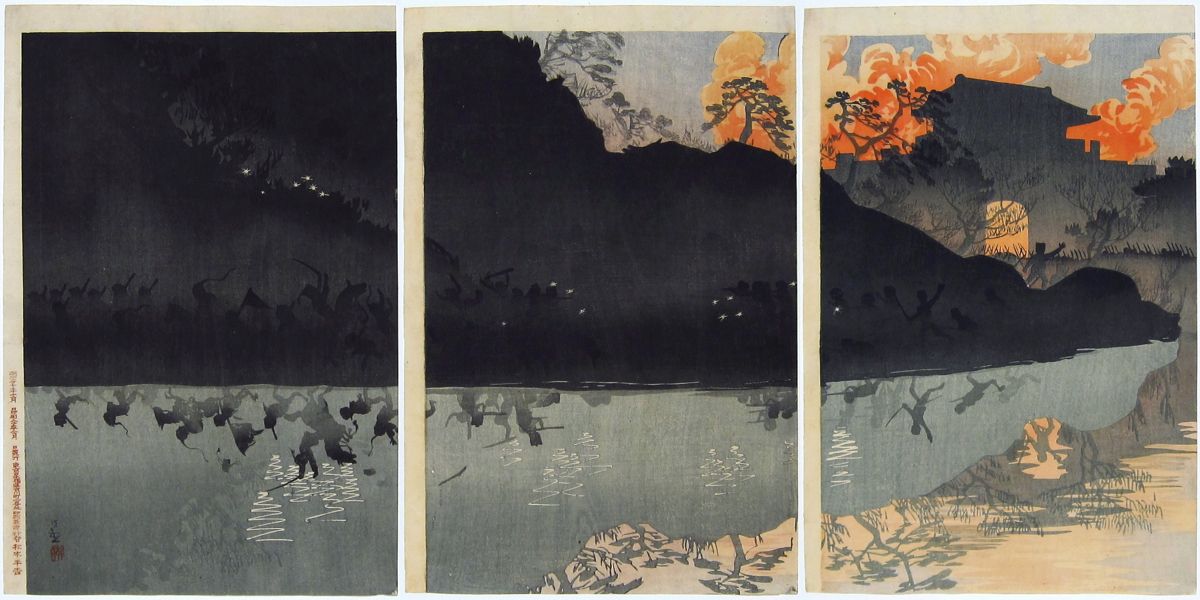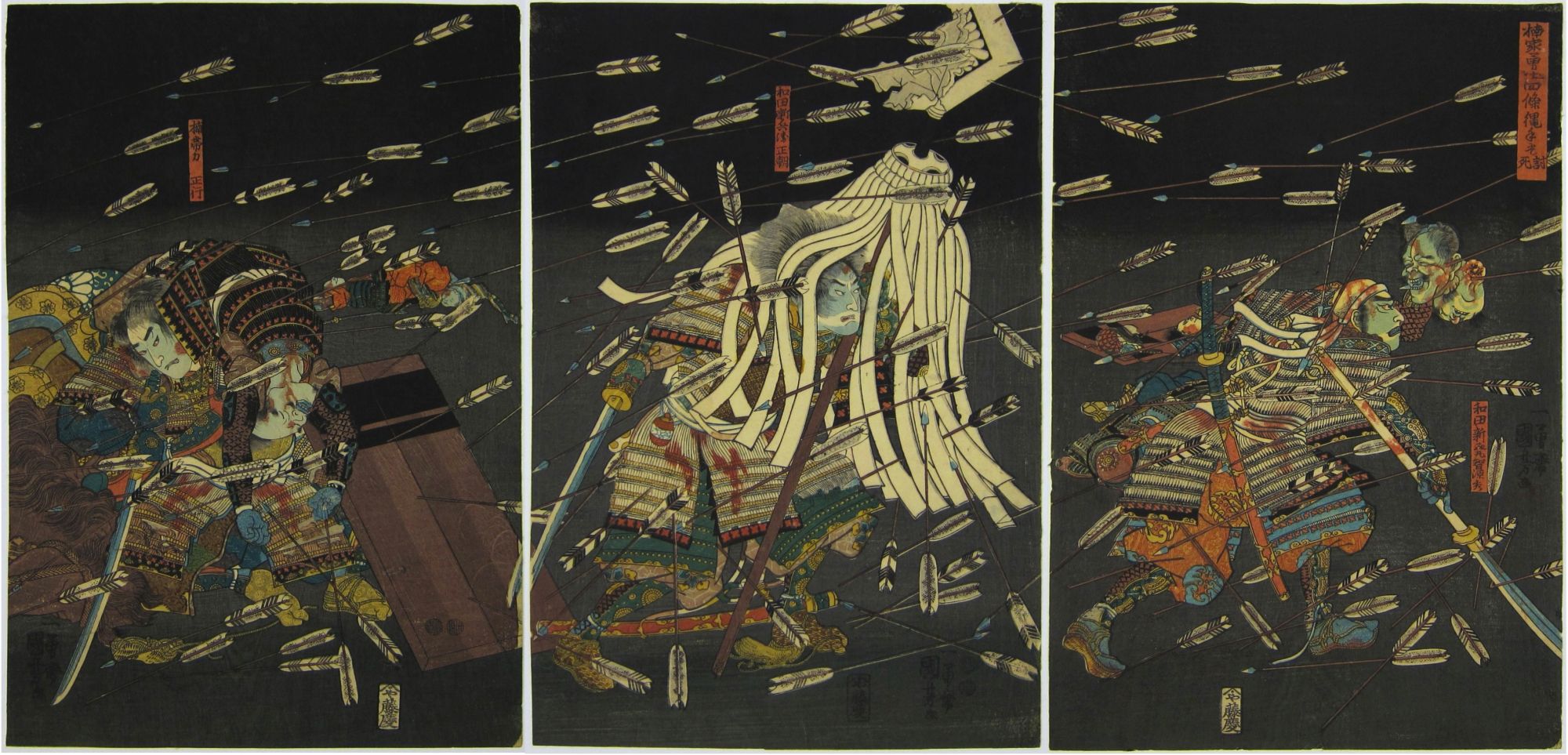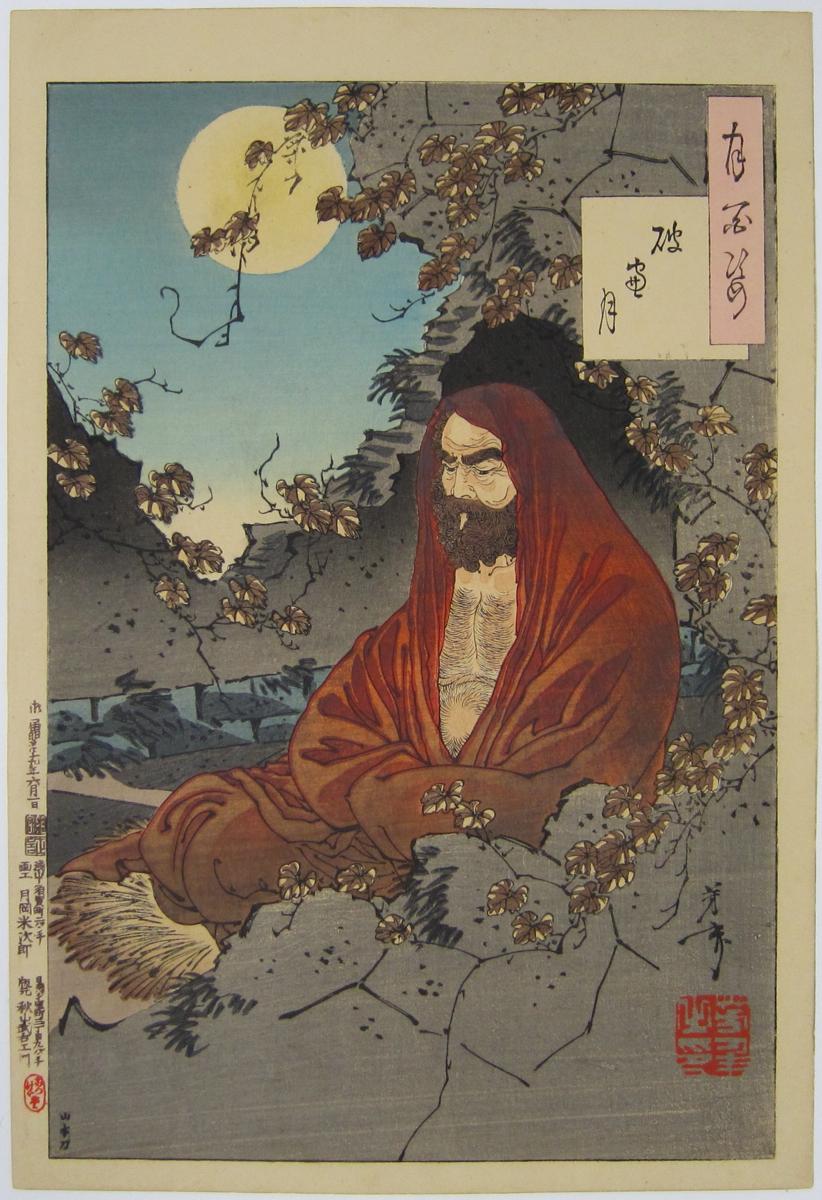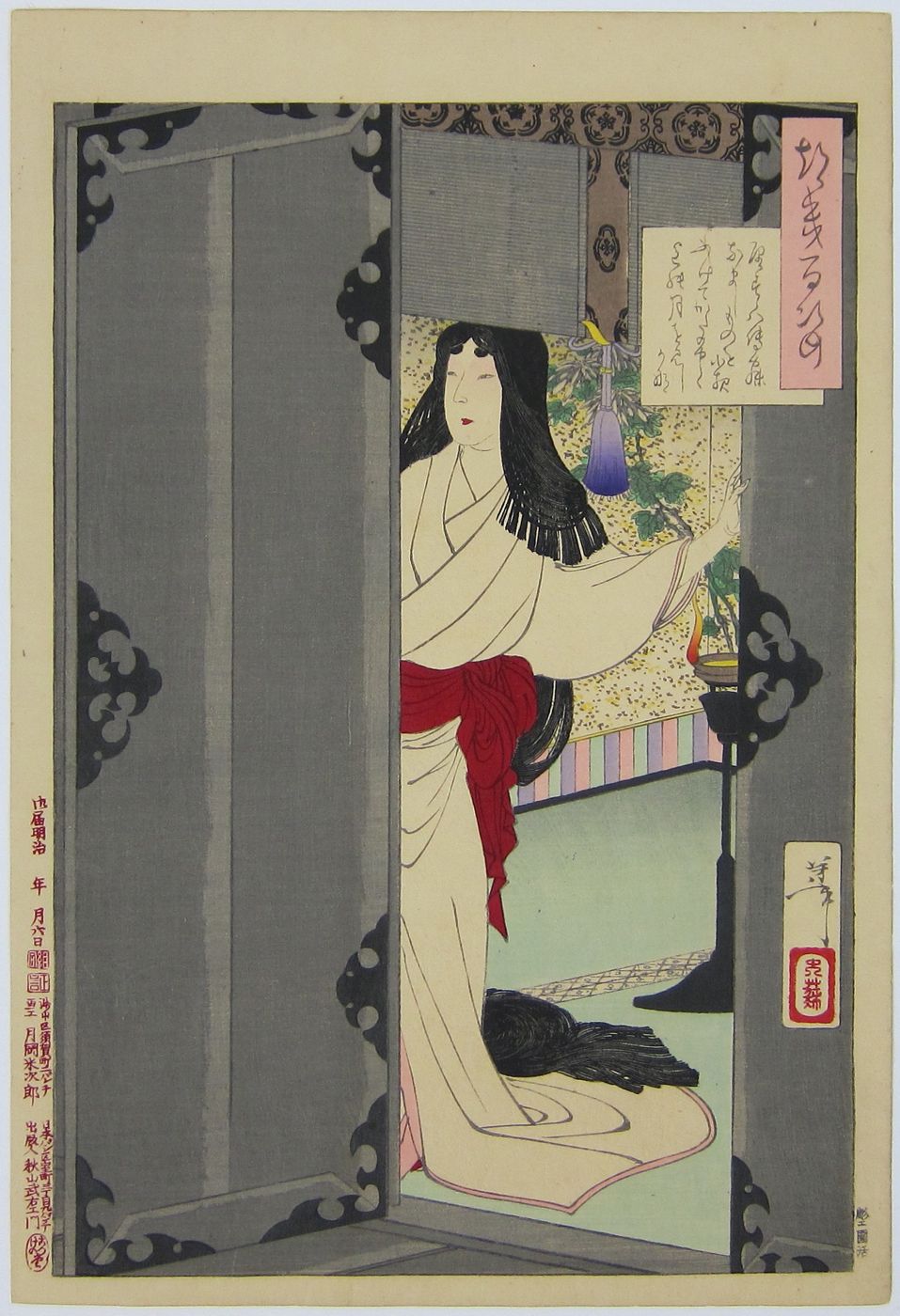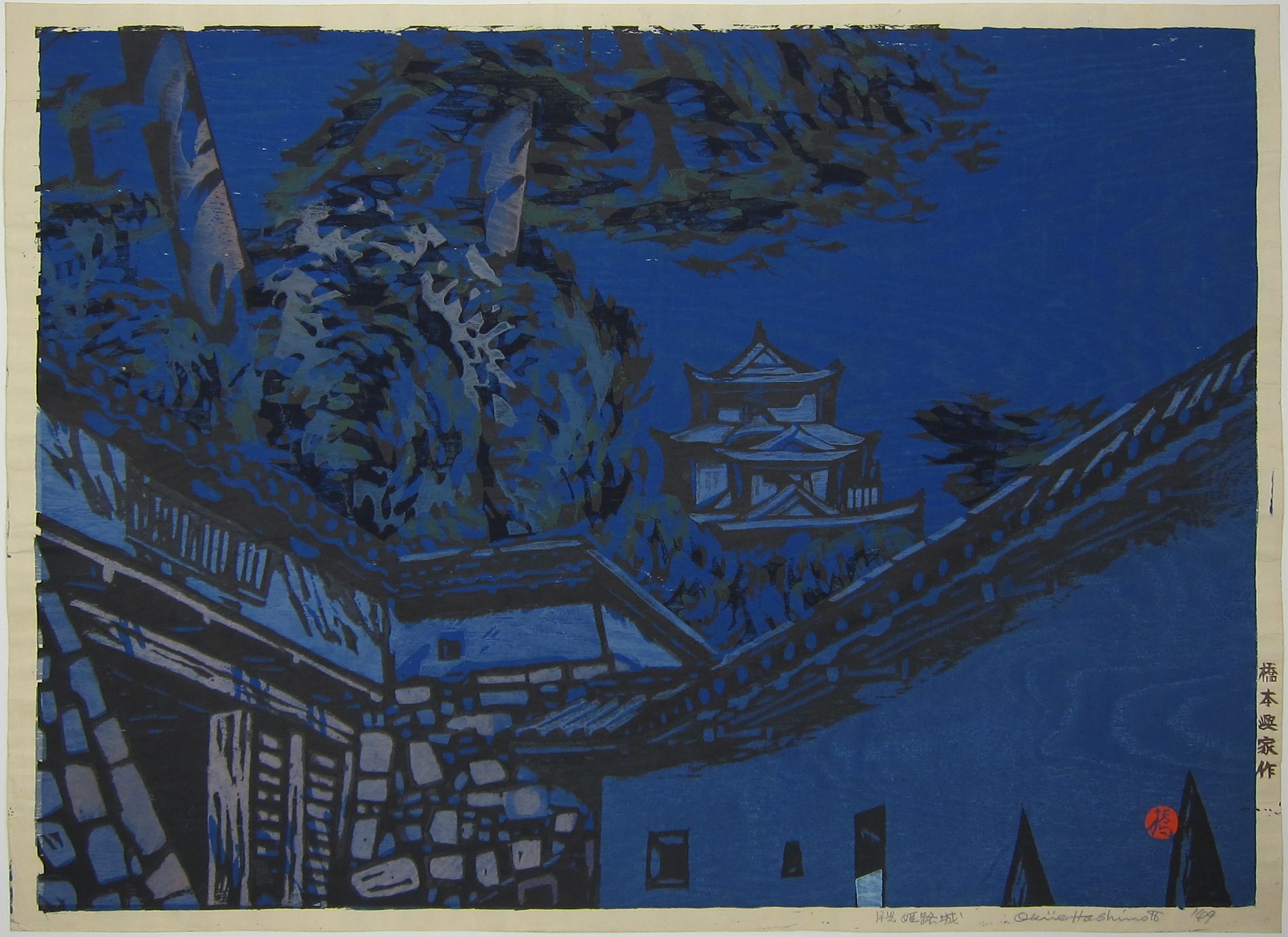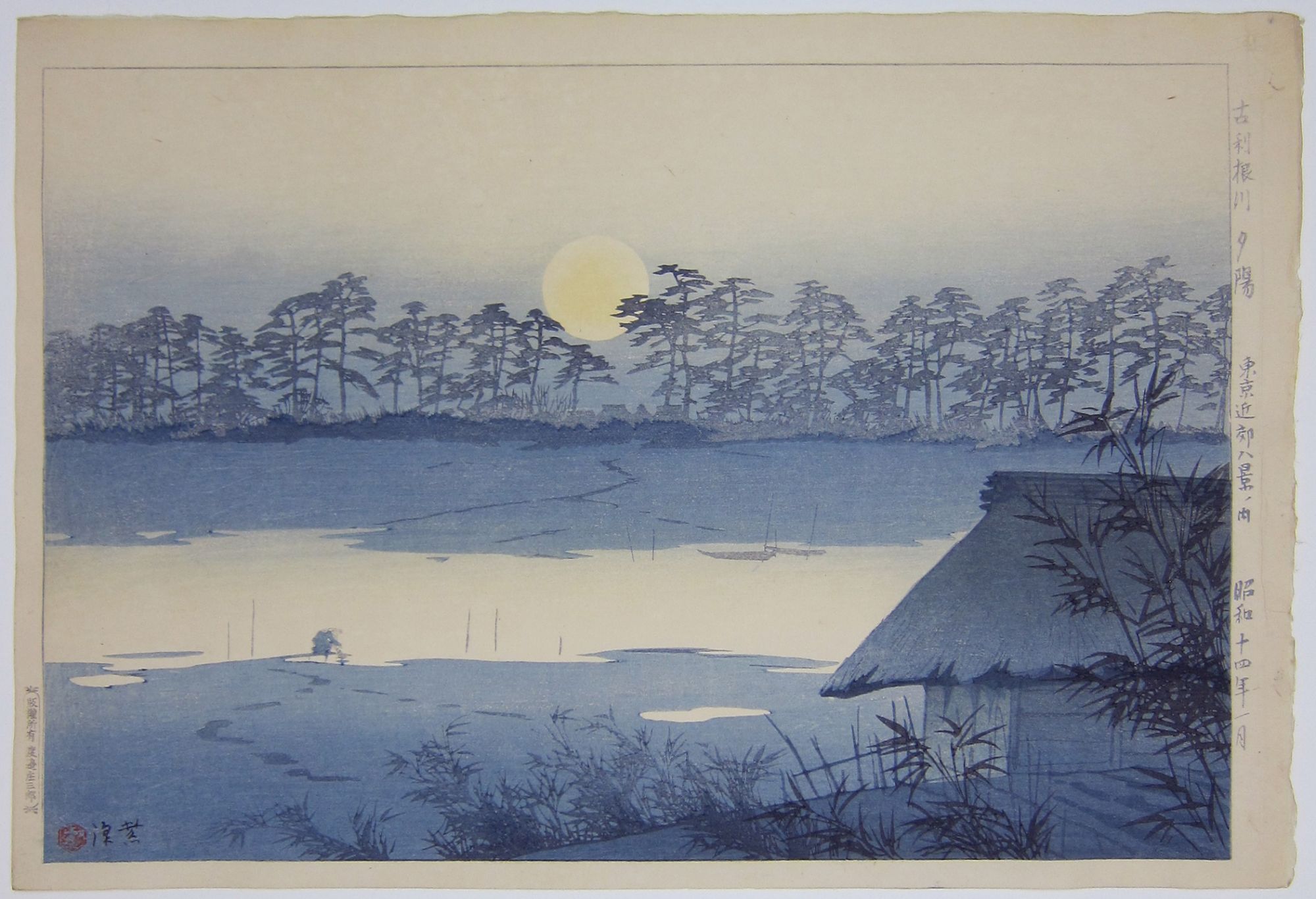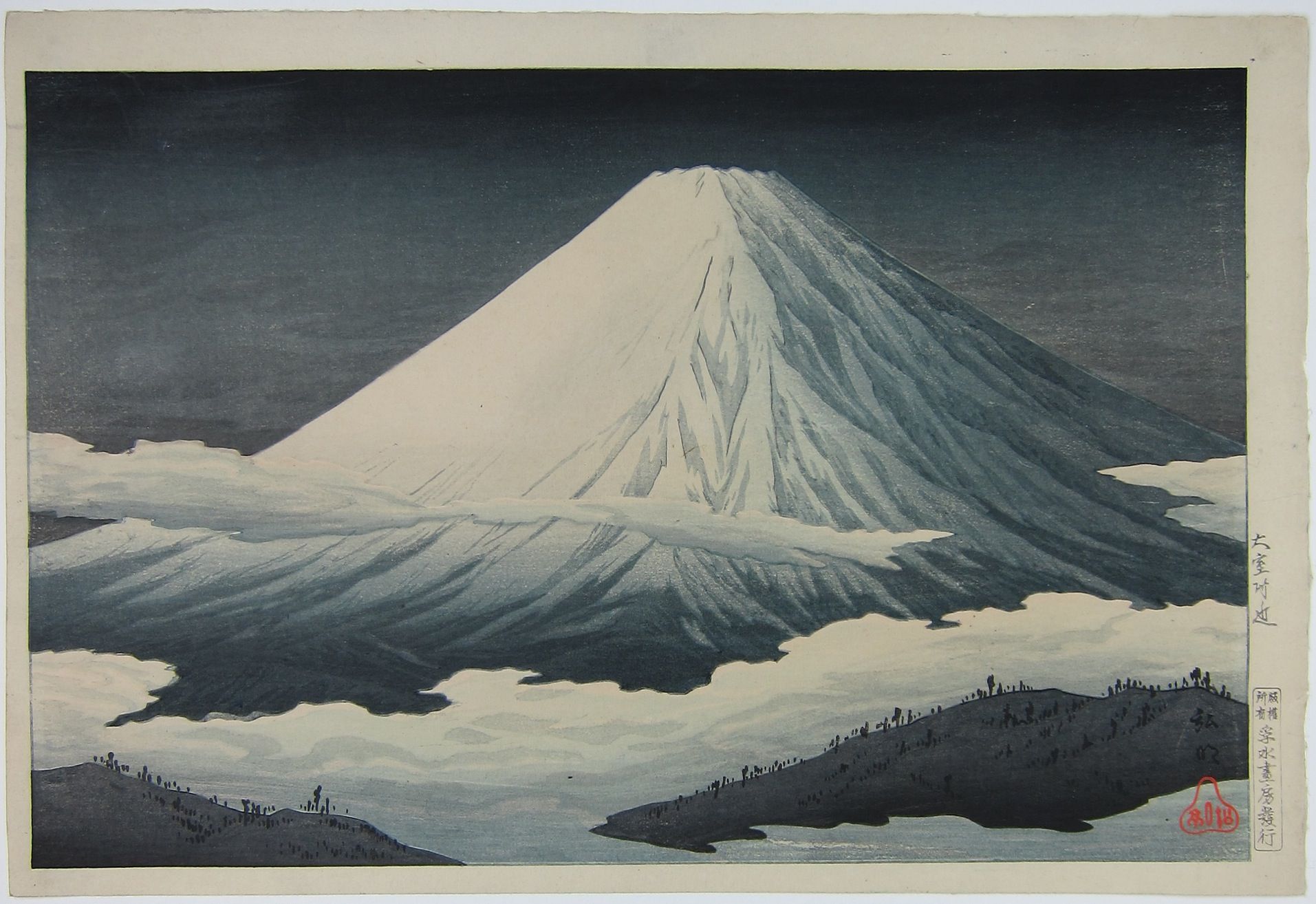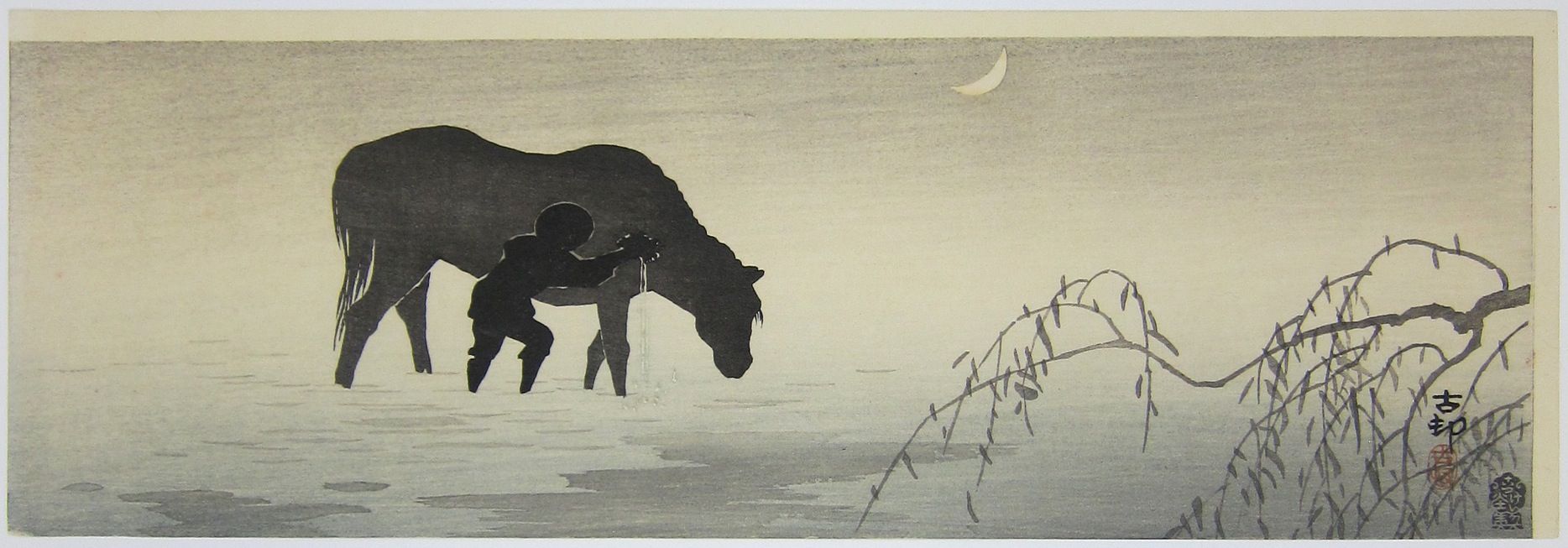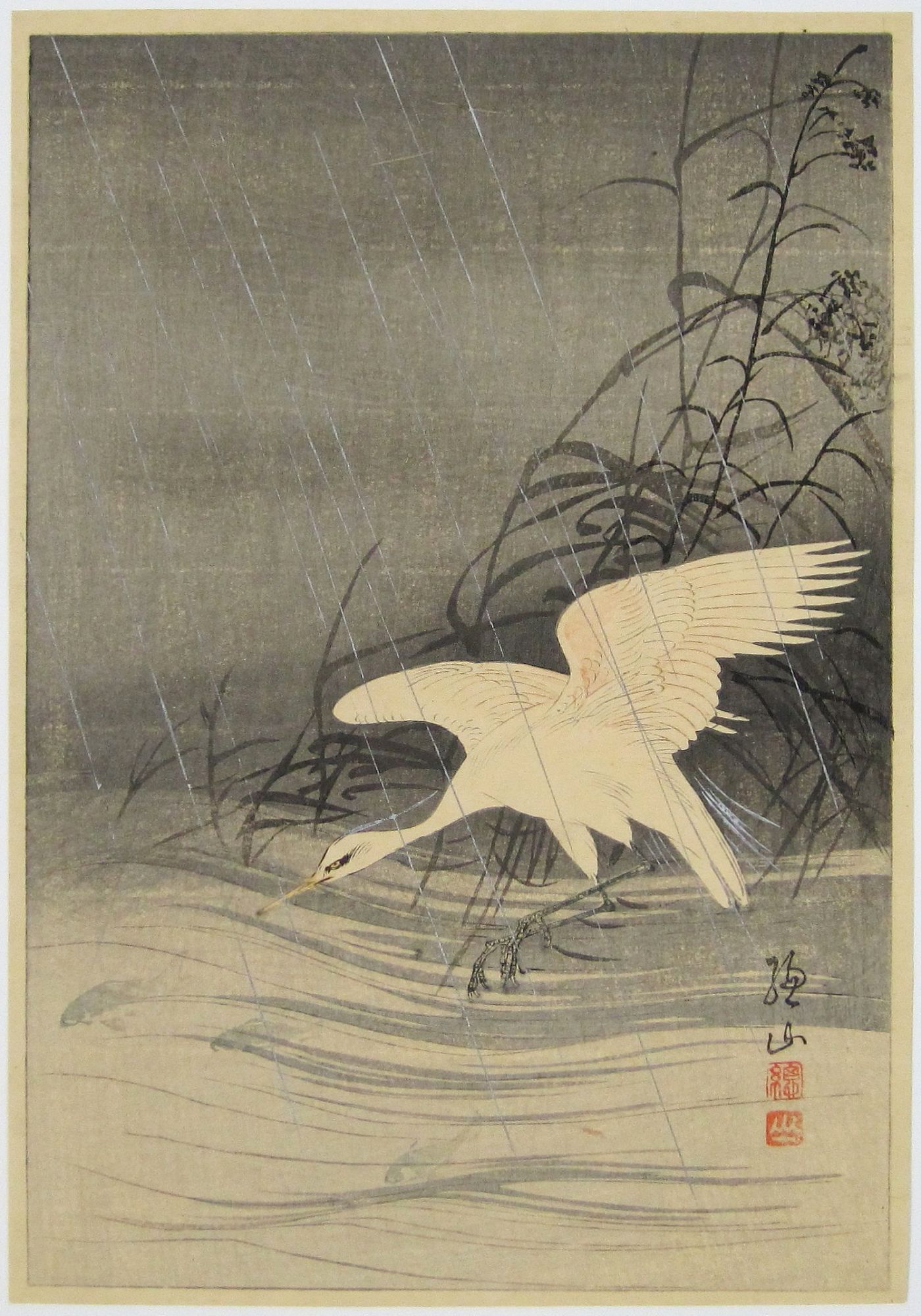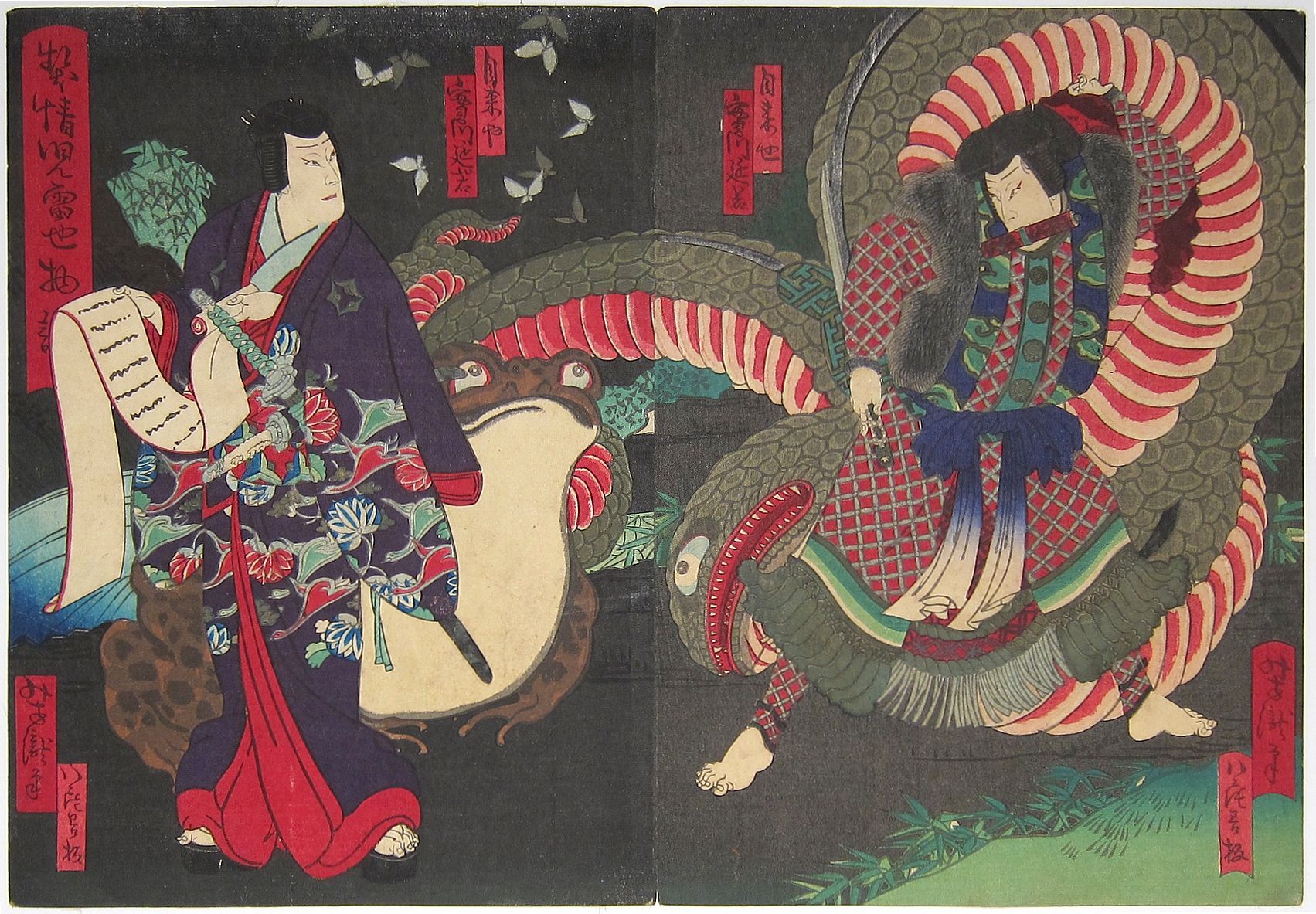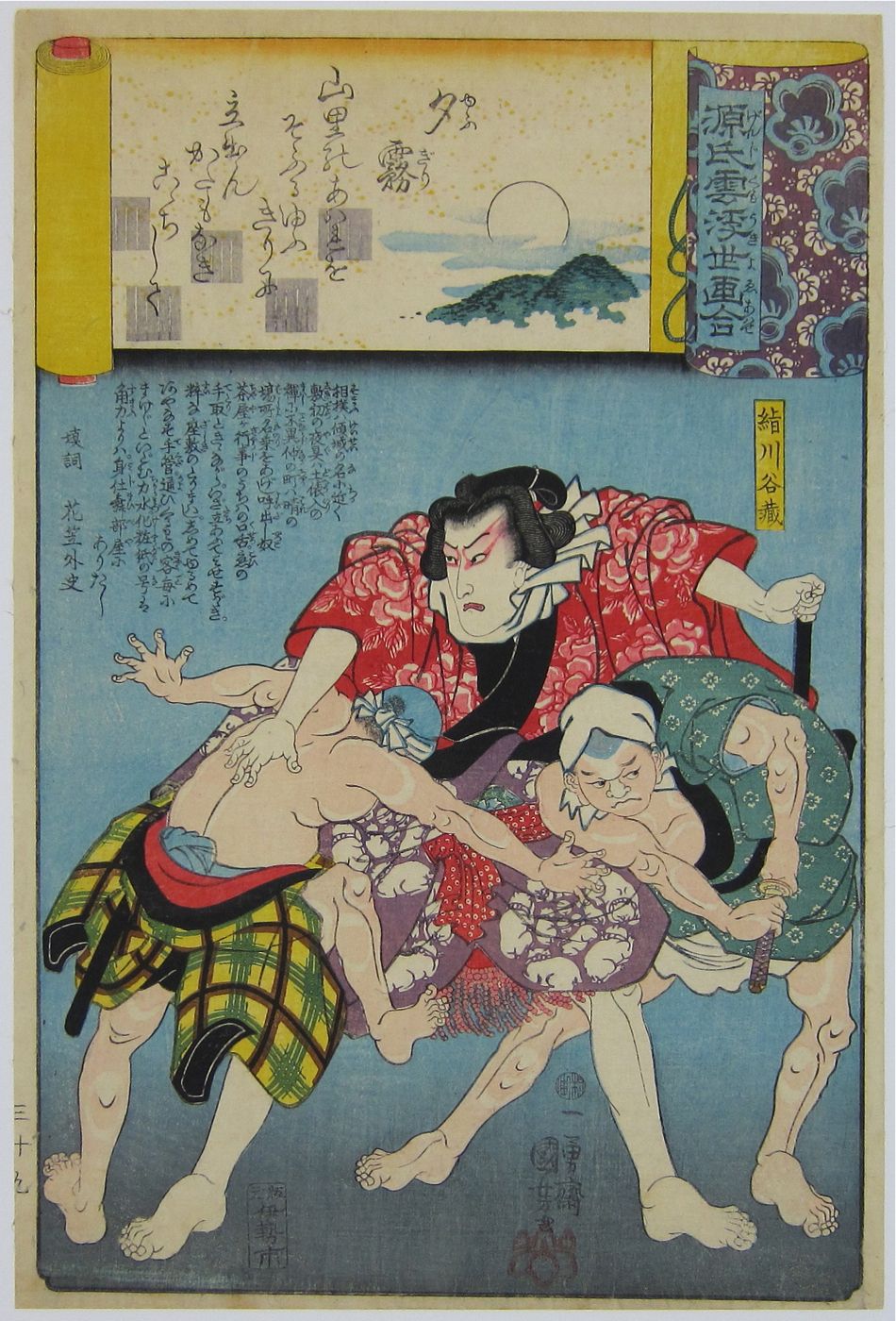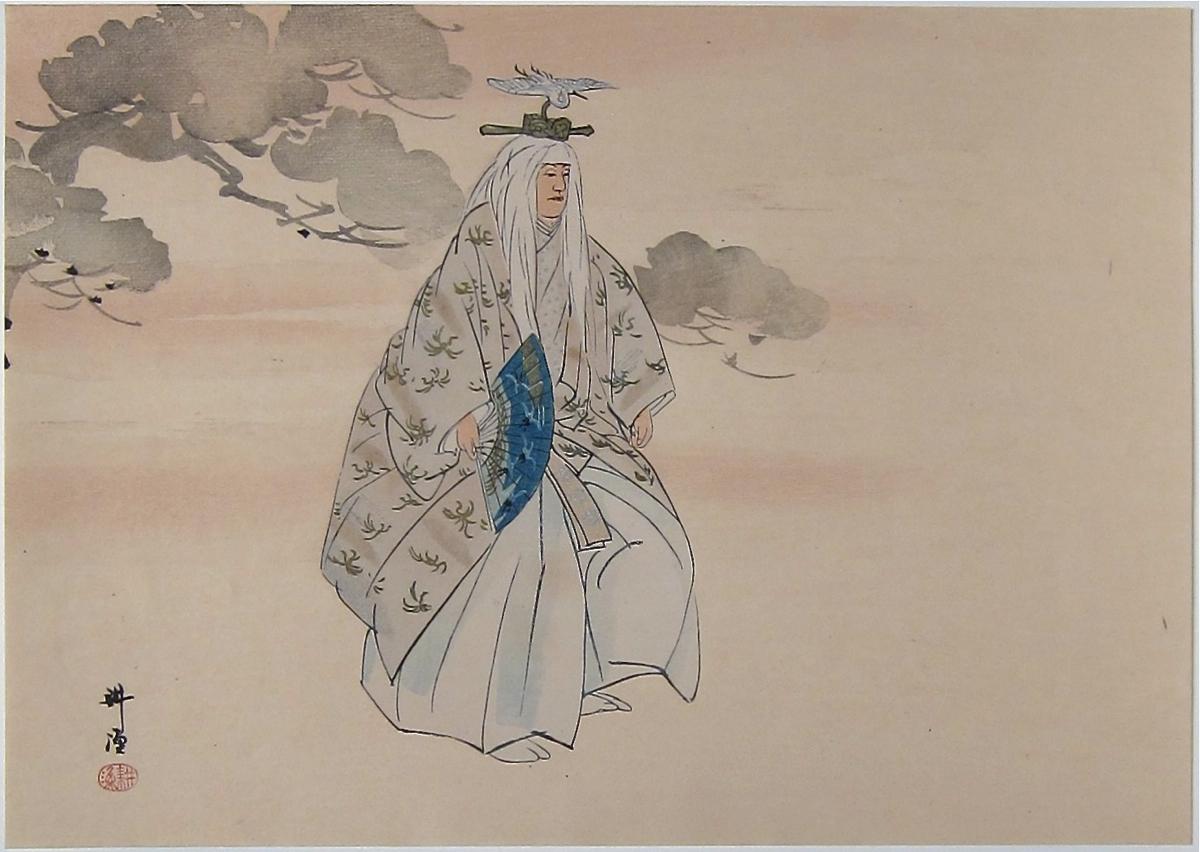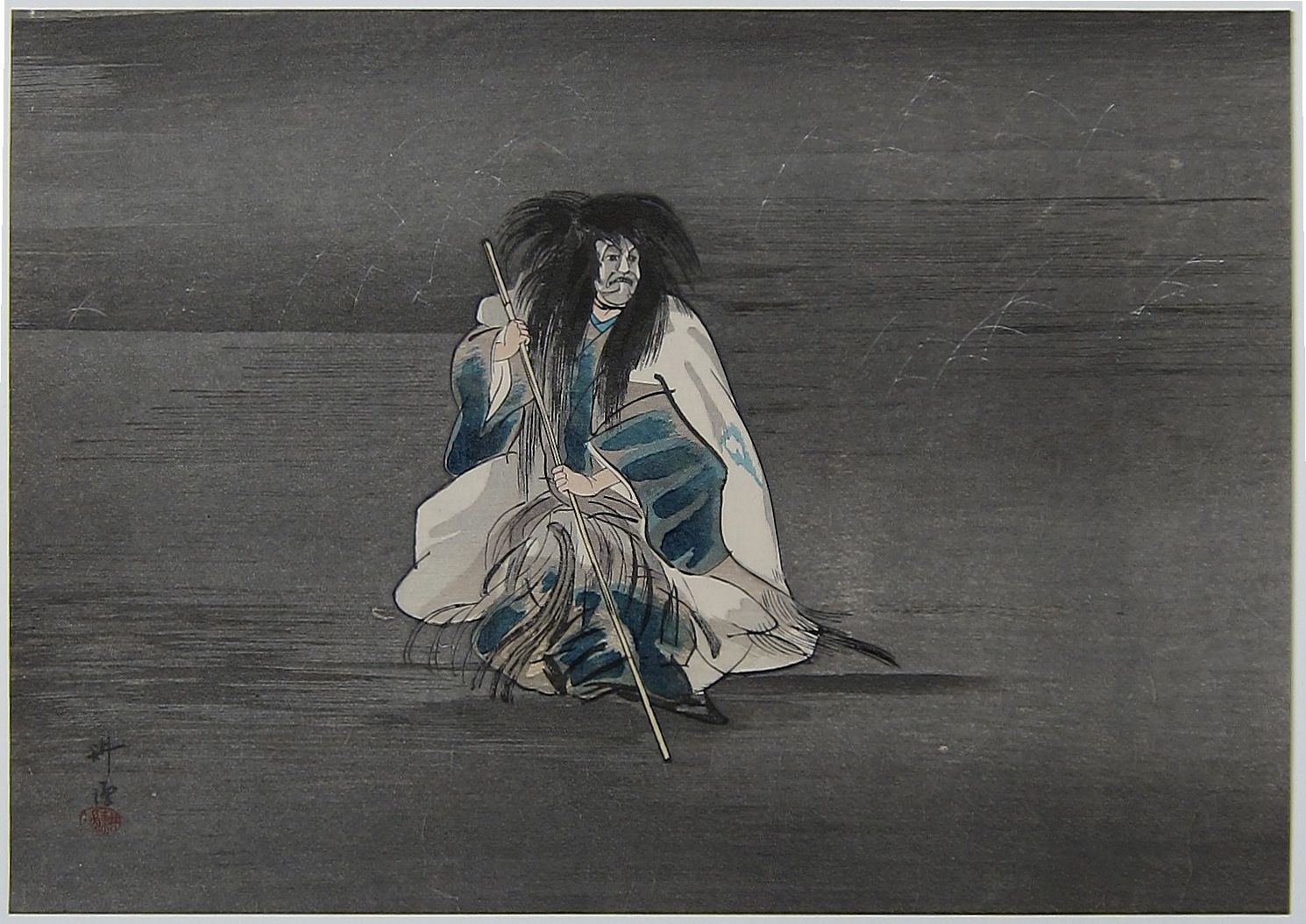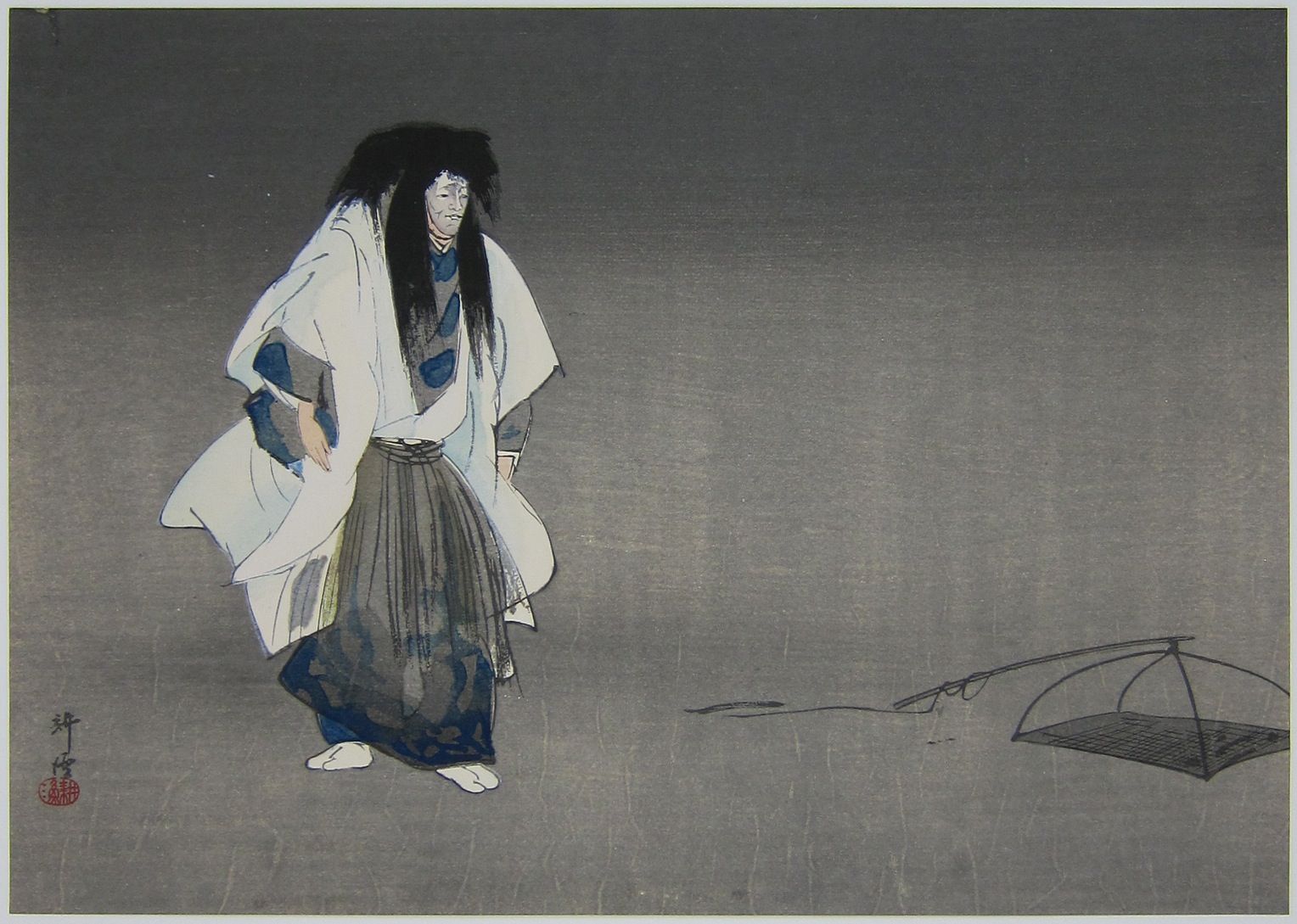YOSHITOSHI Tsukioka. (1839-1892)
Kiyohime Changes into a Serpent at Hidaki River. 1/1890.
- Category
- Japanese | 20th Century
- Series
- 36 Ghosts.
- Publisher
- Sasaki Toyokichi.
- Engraver
- Enkatsu.
ôban tate-e, 24.2 cm × 36.0 cm
Excellent impression of the first state. Mica in the sky, atenashi bokashi shading around the moon. Some trimming, and a slight movement of red around the collar, otherwise very good condition.
Kiyohime fell madly in love with a handsome priest Anchin. He could not reciprocate her worldly passion and in spite of promising to return, he forgets her. Kiyohime's joy turns into hateful anger and she decides to pursue her unrequited love. She finds herself unable to cross the Hidaki river in flooding and overcome with burning rage, turns into a serpent and swims to the other side. She emerges from the water, her back metamorphosing underneath the soaked snake-scale robe and grips her hair with grim resolution. The falling cherry blossom suggest that death is imminent. Anchin is at the Dojoji temple and sees the snake. He hides under a giant bronze temple bell but Kiyohime finds him and coils her serpent body around the bell. In the throes of her white hot fury, it melts and kills them both.
Signed Yoshitoshi, seal Taiso. Ref Plate 11 Pg 104 Yoshitoshi's Strange Tales. John Stevenson. Hotei Publishing.
Sold
Tsukioka Kōgyo 1869-1927
Shakkyō. The Stone Bridge.
- Category
- Japanese | 20th Century
- Series
- One Hundred Noh Plays
- Publisher
- Matsuki Heikichi
oban diptych, 53.0 cm × 39.0 cm
Superb impression, with extensive metallic pigments and bokashi. On thick, deluxe paper. Excellent colour and condition.
The priest Jakushō travels to China and India to visit places associated with the Buddha. He arrives at a stone bridge, whereupon a child appears and tells him that the Pure Land of bodisattva Monju lies on the other side. The boy says that crossing this bridge is treacherous for humans, but predicts that if the priest stays by the bridge, the bodhisattva will come to him. Whereupon, two lions, messengers of Manjuri Bodhisattva, appear and dance with fragrant peony flowers. In Now theatre, the shishimai or lion dance is a highlight of the play Shakkyō. Signed Kōgyo with artist's seal.
Sold
Kawase HASUI (1883-1957)
Snow at the Nezu Gongen Shrine in Tokyo (Nezu Gongen no yuki)
- Category
- Japanese | 20th Century
- Publisher
- Watanabe Shozoburo.
- Blockcutter
- Ono Gintaro
oban tate-e, 27.0 cm × 39.0 cm
A superb and subtle impression. Excellent colour and condition.
A woman and child approach the Nezu Gongen Shrine in Tokyo during a snowstorm. The master printer is attributed in this rare and particularly subtle impression (note the blue bokashi gradation on the umbrella) with his chop 'Surishi Ono Gintaro; print master Ono Gintaro underneath the Watanabe F seal, lower right. Signed Hasui with Hasui seal.
Sold
SHUNSEN Natori. (1886-1960)
Ichikawa Sumizo VI as Shirai Gonpachi. 1926.
- Category
- Japanese | 20th Century
- Series
- Shunsen nagao-e shu.
- Publisher
- Shōzaburō Watanabe.
ōban tate-e, 27.0 cm × 39.0 cm
Excellent impression, with blind printing on the face. Excellent colour and condition.
Shunsen was one of the last great exponents of yakusha-e (actor prints).Here he captures Ichikawa Sumizo VI in the role of a tragic hero, Shirai Gonpachi, 1926, signed Shunsen and sealed Shunsen and Natori.
Sold
SHUNSEN Natori. (1886-1960)
Bandō Mitsugorō VII as Yari yakko.
- Category
- Japanese | 20th Century
- Series
- New Stage Portraits.
- Publisher
- Watanabe Shozoburo
dai-oban tate-e, 28.0 cm × 41.0 cm
Excellent impression with blind printing and mica ground. Excellent colour and condition.
The actor Bandō Mitsugorō VII playing the rold of Yari yakko, a spear bearer, from the series Shinpan butai no sugata-e (New Stage Portraits). Signed Taishidō Shunsen sha (depicted by Taishidō Shunsen), top right with the artist's red 'Shunsen' seal below. The right margin has the date and role details and reads Shōwa nijūshichi nen san gatsu saku, created Shōwa 27 (1952), March) and below the actor and role, Bandō Mitsugorō, Yari yakko. Shozaburo's seal lower left.
Sold
YOSHIDA Hiroshi (1876-1950)
Hodakayama. 1926.
- Category
- Japanese | 20th Century
- Series
- Twelve Scenes in the Japan Alps.
- Publisher
- Self printed "jizuri" seal.
dai ōban yoko-e, 39.8 cm × 29.1 cm
Excellent impression, colour and condition. A particularly subtle printing of this design. Unusually large margins. An early impression (probably trial print) with large brown jizuri seal.
Yoshida was a keen mountaineer and often portrayed summits throughout his output. He climbed the Japan Alps for two months every summer and loved Hodakayama so much that he named his son Hodaka after this panoramic view.
Signed Yoshida in block with Hiroshi seal. Brown first state 'jizuri' seal top right margin. Work and series title underneath 'Nihon Arupusu jûni dai no uchi' Hodakayama from Twelve Scenes in the Japan Alps. Taisho Ju-Go Nen Saku (1926) in the left margin.
Literature; Plate 29 Page 51. 'The Complete Woodblock Prints of Yoshida Hiroshi' by Tadao Ogura. IBSN 978-4872421217.
Sold
Toyokuni III/Utagawa KUNISADA (1786-1864)
Oshidori no Jourei (Ghost of Mallards). 9/1860
- Category
- Japanese | 20th Century
- Series
- Tori Zukushi (Picture List of Birds).
- Publisher
- Otaya Takichi.
oban tate-e, 26.0 cm × 37.8 cm
Very good impression and colour. A water mark in the sky, otherwise very good condition. Large oban sheet.
The actor Nakamura Shikan IV performing the role of Eno no Shoryo (the Ghost of the Mallard) at the Ichimura Theatre, Edo during the ninth month, 1860.
He wears a special wig that evokes the ducks feathers, ruffled by the breeze. The spirits of male and female mandarin ducks were a popular subject in Kabuki theatre, derived from Chinese legend. Adaptations of the dance-drama "Oshidori" appear in Kabuki, especially in the 1850's, when Kuniyoshi and Kunisada designed triptychs on the subject. Signed ni konomi Toyokuni ga.
Sold
Kitagawa SHIKIMARO (fl.1810)
Kara-uta of the Chôjiya. 1813.
- Category
- Japanese | 20th Century
- Series
- Female Poetic Immortals in the Modern Style. (Imayô onna kasen, sanjûrokuban tsuzuki.)
- Publisher
- Nishimuraya Yohachi (Eijudo).
ôban tate-e, 25.4 cm × 37.3 cm
Very good impression. Good colour, somewhat faded. Trimming and very light foxing at the left, otherwise good condition.
A portrait of the courtesan Karauta of the Chôjiya, one of the superior houses of the Yoshiwara, the licensed pleasure quarter. Her kamuro (child apprentices) were Utagi and Tsumaki. To the left is a poem in the courtesan's own calligraphy.
Sold
HASUI Kawase. (1883-1952)
Lake Kawaguchi. c.1941
- Category
- Japanese | 20th Century
- Publisher
- Watanabe Shôzaburô. F Seal (1934-1941)
oban tate-e, 26.0 cm × 38.0 cm
Superb impression with strong visible woodgrain. Excellent colour. Very faint remnants of 'H.Kawase' in pen, lower right, otherwise very good condition.
Mount Fuji seen from Oishi park on Lake Kawaguchi, the second largest of the "Five Fuji Lakes". The view is dominated by five maize plants (zea mays), a design that recalls Hiroshige's Iris at Horikiri from One-hundred Views of Edo. A seldom seen design. Watanabe D seal 1931-1941, signed and sealed Hasui.
Sold
Toyokuni III/Utagawa KUNISADA (1786-1864)
View of Kakegawa (Kakegawa no zu)
- Category
- Japanese | 20th Century
- Series
- Fifty-three Stations of the Tôkaidô Road (Tôkaidô gojûsan tsugi no uchi)
- Publisher
- Moriya Jihei (Kinshindô)
- Engraver
- we
chuban tate-e, 18.6 cm × 26.0 cm
Excellent impression, colour and condition.
Plate 27 from a series of chuban prints depicting beauties with scenes from Hiroshige's Tokaido. The beauty proffers a maple leaf branch. Mount Akiba is printed in shades of blue and green, and a kite blows over the travellers crossing a tressle bridge. In the distance, peasants work in the rice fields. Signed Kochoro Kunisada ga.
Sold
KIYOCHIKA Kobayashi. (1847-1915)
Girl with an Umbrella. A Beauty from the An'ei Era. 1896.
- Category
- Japanese | 20th Century
- Series
- Hana Moyo. Flower Designs
- Publisher
- Kokkeido.
oban triptych, 76.0 cm × 25.0 cm
Very good impression and condition. Good colour. Full size.
A beauty from the An'ei Era (1772-1781) holds a bran bag 'nukabukuro' between her teeth as she puts up her orange parasol at the onset of rain. She is making her way to the bathhouse with her hair is tied up in the bai-mage style. The series title hana implies elegance, while moyo are the beauties themselves. Signed Kiyochika with seal.
Sold
HASUI Kawase. (1883-1952)
Kinosaki, Tajima. 1924.
- Category
- Japanese | 20th Century
- Series
- Souvenirs of Travel, Third Series.
- Publisher
- Shōzaburō Watanabe.
ōban yoko-e, 39.0 cm × 26.1 cm
Excellent early impression with fine gradation on the mountain. Toned au verso, otherwise very good condition.
A lone woman with a yellow parasol walks by the canal at night. The shapes of the mountain and the electric power lines are barely discernible in the heavy downpour. A nocturnal rain scene of sombre black and grey, the only colour accents are the yellow lights coming from the ryokan inns that line the street and the blue from the canal. One of Hasui's masterworks. Signed Hasui with Kawase Seal. Watanabe A seal (1924-30) lower right margin. Tabi miyage daisanshū Third series of Travels followed by work title, Tajima Kinosaki sand Taisho jusannen saku (work of 1924) all in the left margin.
Sold
HASUI Kawase. (1883-1952)
Lakeside Shower at Matsue. 1932.
- Category
- Japanese | 20th Century
- Publisher
- Watanabe Shôzaburô. C Seal.
oban yoko-e, 39.2 cm × 26.3 cm
Excellent impression, colour and condition.
A fisherman hurries for shelter under a large deciduous tree, as rain breaks out on the shore of Lake Shinji-ko. The low grey clouds are typical on the coast of Japanese lakes. The sheets of rain are created using the baren, a bamboo pad used in the print-making process to apply colour.
Signed Hasui, seal Kawase. C Watanabe 'sausage' seal in the right margin.
Sold
MAEDA Masao.. (1904-1974)
Seascape. c.1950
- Category
- Japanese | 20th Century
- Publisher
- Self-printed.
large dai-oban yoko-e, 41.7 cm × 28.8 cm
Excellent impression, colour and condition.
An atmospheric seascape by the celebrated sosaku-hanga artist Masao Maeda. A rare print.
Artist's seal Ma at the bottom left. Kaneko collectors seal in the lower left corner.
Sold
SEKINO Jun'ichiro (1914-1988)
Rice Field. 1962.
- Category
- Japanese | 20th Century
- Publisher
- Self published.
large colour etching and woodcut, 60.7 cm × 47.0 cm
Excellent impression, colour. A light mat line in the border; otherwise very good condition.
In April 1961, Sekino designed a series of woodcuts titled Ine (Rice Fields); each plate was a different colour. A year later, he created this detailed etching/colour woodcut on the same subject, also using the same strong yellow pallette as the woodcut. He studied etching under Kon Junzo and surpassed many of his sosaku-hanga colleagues in the technical process of print making. Signed Jun Sekino. Seal: Jun. Edition 9/35. Ref: Art Gallery New South Wales, Australia.
Sold
YOSHITOSHI Tsukioka. (1839-1892)
Inamura Promontory moon at daybreak. 8/1886
- Category
- Japanese | 20th Century
- Series
- One Hundred Aspects of the Moon.
- Publisher
- Akiyama Buemon.
- Engraver
- Yamamoto.
oban tate-e, 26.4 cm × 36.9 cm
Very good impression with strong woodgrain. Excellent colour, with oxidation in the lower sky and very good condition.
Nitta no Yoshisada offers his treasured sword to the sea gods at dawn. In 1333, the general ended his allegiance with the Hojo clan and raised an army of twenty thousand men to restore the exiled emperor, Go-Diago, to the castle in Kamakura. His military campaign is impeded when he finds himself trapped at the Inamura Promontary. The Hojo army have fortified both the cliffs and the sea with war ships. As day breaks, Yoshisada offers his sword and the tide recedes, carrying with it the ships and archers, creating a wide expanse of sand, and a passage way for Yoshisada to advance on Kamakura.
Printed 8/1886. Signed: Yoshitoshi. Seal: Taiso. ref: Stevenson, John, "Yoshitoshi's One Hundred Aspects of the Moon", Redmond, WA: San Francisco, Graphic Society, 1992, - plate 39. Reference Impression.
Sold
Torii Kotondo 1900-1976
Yuge. 1926.
- Category
- Japanese | 20th Century
- Publisher
- Sakai Kawaguchi
dai-oban, 30.0 cm × 47.0 cm
Excellent impression, first state. Excellent colour and condition.
A beauty washes her neck with a towel in a hot spring, onsen. Kotondo uses the technique baren-sujizuri to capture the effect of steam, with swirling marks across the surface of the paper. Kotondo belongs to the Torii line of print makers, and like Kiyonaga, the fourth head of the Torii line, specialises in bijinga-e or beauty prints. Dated, Showa yonen jugatsu (Showa 4 (1929), 10th month) signed Kotondo saku with Kotondo seal. The first state with limited edition hand seal au verso, number 82 of an edition of 200, the publisher's seal Sakai-Kawaguchi go ban.
Sold
Yoshimoto GESSO (1881-1936)
Dragon and Mount Fuji. c.1910
- Category
- Japanese | 20th Century
- Series
- Japanese Scenes on Tanzaku.
- Publisher
- Nishinomiya.
tanzaku, 9.0 cm × 34.0 cm
Excellent impression, colour and condition.
An iconic subject in Japanese art of the dragon emerging from a thick cloud of black smoke and ascending Mount Fuji, heavens-bound. The symbol is an auspicious one, suggesting good fortune, and a reference to the deity that is said to live in the mountain. Gesso sets his design in the narrow tanzaku format. Signed Gesso.
Sold
Komura Settai 1887-1940
Shadow of the Cherry Tree.
- Category
- Japanese | 20th Century
- Publisher
- Takamizawa
oban, 27.0 cm × 39.0 cm
Fine impression of the first state. Fine colour and condition.
A print titled 'Shadows of the Cherry Tree' by Komura Settai. His work is influenced by Suzuki Harunobu in its depiction of fragile, delicate beauties. This is probably the first edition, without the break in the shoji screen and the Takamizawa seal au verso. Another edition is on a larger sheet of paper but with flaws in the block. Signed Settai ga.
Illustrated in the Female Image, Plate 213.
Sold
HASUI Kawase. (1883-1952)
Mito, the Swamp of Konuma in Snow. Mito hinuma no yuki. 1947.
- Category
- Japanese | 20th Century
- Publisher
- Watanabe Shôzaburô. First edition. J Seal.
oban yoko-e, 36.0 cm × 24.0 cm
Very good impression and colour. First state. Tiny drying holes in the top margin, expertly filled. A light tab residue au verso, otherwise very good condition.
Kawase Hasui is a master in the genre of shin-hanga ("new print") landscape. Hi Marsh is silenced by heavy snowfall. The branches of the pine trees are laden with snow under the overcast sky. A solitary figure in a warm straw coat has moored his boat and trudges forward in the blizzard, with a fishing rod over his shoulder. A loner himself, Hasui rarely portrays more than one figure in his prints.
Signed Hasui. 6mm seal lower left.
Literature: Plate 496. The Complete Woodblocks of Kawase Hasui. Hotei Publishing. IBSN 978-9074822466
Sold
SHOUN Yamamoto (1870-1965) (1870-1965)
Crows in a Snowstorm. c.1910-20
- Category
- Japanese | 20th Century
- Publisher
- Daikokuya.
o-tanzaku, 17.5 cm × 34.6 cm
Very good impression, colour. Slight trimming, otherwise very good condition. Splashed gofun creates the effect of snow.
Two crows in a blizzard, perched high above a fir-clad ravine. The crow that has just alighted the branch appears to stake an aggressive, territorial claim to the vantage point. The startled crow caws and reveals his red tongue; the only accent in this monochrome design. Shoun is known for his prints of beautiful women and his kacho-ga (pictures of birds and flowers) are rare. Signed Shoun with the artist's seal.
£450
KUNIYOSHI Ichiyusai. (1798-1861)
The Sorceress Takiyasha. 8/1852.
- Category
- Japanese | 20th Century
- Series
- The Sixty-Nine Stations of the Kisokaido.
- Publisher
- Sumiyoshi-ya Masagorô
oban tate-e, 25.5 cm × 36.2 cm
Excellent impression with strong woodgrain; the black rock and tree glisten with mica to create the illusion of frost. Pristine colour. Small repaired wormage above print number seal and one lower right, otherwise very good condition.
In the mountain snow of Ashida, the sorceress Takiyasha performs a magic ritual, clenching a torch between her teeth, a mirror around her neck and a sword in her right hand. She is followed by her henchman Araimaru who brandishes the head of one of her victims on a stick. Her short hair belies her former vocation as a nun before she resorted to witchcraft.
There are many puns on word and image in this print. The horses around the title cartouche pun Soma, the name of her ancestral home, and geta is a pivotal word for her high clogs and the station Ashida. The bird shape cartouche for the landscape is derived from the name Uto Yasukata, a loyal retainer killed by Takiyasha and her brother. Utoysukata is also the name of a bird in Northern Japan.
Signed Ichiyûsai Kuniyoshi ga. Censor seals Kinugasa, Murata, Rat 8.
Literature; Pg.70-71 The Sixty-Nine Stations of the Kisokaido. Sarah E Thompson. IBSN 978-0-7649-48893
Sold
HASUI Kawase. (1883-1952)
Evening Snow at Ishinomaki. 3/1935.
- Category
- Japanese | 20th Century
- Series
- Collection of scenic views of Japan.
- Publisher
- Watanabe Shôzaburô. C Seal (1929-1942 'sausage seal')
oban yoko-e, 38.0 cm × 26.0 cm
Excellent impression, colour and condition. A pin-sized drying hole top right. Full margins.
Hasui is a master at recreating mood and atmosphere in his landscape designs. The falling snow prints demanded great technical skill on the part of the carver and printer as Hasui noted "In the case of printing we must interact very closely. A less experienced printer might waste seven or eight trial prints before a successful one is made. If someone is experienced we can decide on the final print after two or three trials. It occurs occasionally that despite best efforts, a successful print is still not produced. This is the hard part of composite art. It requires telepathic communication. Unless all parties are completely in tune, the process will not work. When my mind and the minds of the artisans are in complete agreement, a good work can be generated" Signed Hasui with 'kawase' seal. Sausage seal (1929-1942) right margin. Print title followed by 'showa ju-nen sangatsu saku' to the left.
Reference: Plate 309. The Complete Woodblock Prints of Kawase Hasui. Hotei Publishing. IBSN 978-9074822466.
Boston Museum of Fine Arts Impression.
Sold
KONEN Uehara. (1877-1940)
Remaining Light (Zan to). 1928.
- Category
- Japanese | 20th Century
- Publisher
- Shōzaburō Watanabe. First edition A seal.
ōban tate-e, 26.1 cm × 38.8 cm
Excellent impression, colour and condition. The first state with the Watanabe 'A' seal in the lower right margin.
The artist Uehara Konen designed two vertical ōban landscape prints in 1928 for Watanabe Shōzaburō, who assumed publication of his designs after the Great Kantō earthquake of 1923. The artist had a predeliction for muted tones. This nocturnal study in blue, black and grey is reminiscent of the the artists pre-earthquake aizuri-e (blue prints).
The red artist's seal 'Konen' is lower right. The Shōzaburō Watanabe 'A' seal (1924-1930) in the right margin reads 'copyright ownership Watanabe Shozaburo' (Hanken shoyu Watanabe Shozaburo). The work title followed by Showa 3 (1928) in the lower left margin.
Sold
KUNISADA I/TOYOKUNI III (1786-1865)
Fukagawa Iyo setsu. 1855
- Category
- Japanese | 20th Century
- Publisher
- Iseba Magobei
chuban, 29.5 cm × 23.0 cm
Excellent impression with splashed gofun to imitate snow. Pristine colour. One small wormhole, expertly restored, otherwise very good condition.
Fukagawa Iyo setsu. Iyo Province; Time in Fukagawa. An uncut fan print depicting a snow scene and a beauty clutching her hair pin. Dated third month, 1855. Another copy of this fan print is at the Ukiyo-e Museum, Matsumoto, Japan. Illustrated on Pg 221 of 'Japanese Woodblock Prints' by Andreas Marks.
Sold
Tsukioka YOSHITOSHI (1837-1889)
The moon through a crumbling window.
- Category
- Japanese | 20th Century
- Series
- One Hundred Aspects of the Moon.
- Publisher
- Akiyama Buemon
- Engraver
- Yamamoto
oban tate-e, 25.0 cm × 37.0 cm
Excellent impression with strong woodgrain. Excellent colour and very good condition.
'Haso no tsuki' from Yoshitoshi's masterpiece series 'One hundered Aspects of the Moon'. Bodhidharma (Daruma in Japanese), founder of Zen Buddhism, meditates in a cave for nine years after being refused entry to the Shaolin Monastary. Vines grow over the walls of the moonlit cave. He cut off his eyelids in anger, after falling asleep two years into the meditation, and tea plants grew where they fell. Signed Yoshitoshi, seal Yoshitoshi no in. Engraved by Yamamoto. Printed 1 June 1886.
Sold
SHIKIMARO Kitagawa. (fl.1810)
Ôi of the Ebiya. 3/1813
- Category
- Japanese | 20th Century
- Series
- Female Poetic Immortals in the Modern Style. (Imayô onna kasen, sanjûrokuban tsuzuki.)
- Publisher
- Nishimuraya Yohachi (Eijudô).
ôban tate-e, 26.0 cm × 38.0 cm
Very good impression, colour and condition.
The courtesan Oi of the Ebiya smokes a pipe while admiring her reflection in a mirror. Her magnificent outer kimono is decorated with the fan emblem of the house of Ebiya. The box to the left shows her calligraphy, and the names of her two kamuro (child apprentice), Miyako and Sakuro.
Sold
KOSON Ohara (1876-1945)
Autumn grasses, flowers and moon.
- Category
- Japanese | 20th Century
- Publisher
- Daikokuya
o-tanzaku, 18.7 cm × 34.0 cm
Excellent impression, colour and condition. A beautiful Koson design.
A prevailing theme in Japanese art of the moon, viewed through autumn grasses, known by depictions of Musashino Moor (Musashino). This theme was developed by artists through the Momoyama period. (1568-1600), and often explored by ukiyo-e artists, notably in the Musashino beauties triptych by Utamaro. With the red Koson seal.
Sold
YOSHITOSHI Tsukioka. (1839-1892)
Moon over Daimotsu Bay. 1/1886.
- Category
- Japanese | 20th Century
- Series
- One Hundred Aspects of the Moon.
- Publisher
- Akiyama Buemon.
- Blockcutter
- Enkatsu.
ōban tate-e, 25.2 cm × 37.4 cm
Very good impression, mica on the waves. Not from an album so no offsetting from Kikaku plate around Benkei. Large margins lightly soiled and minimally toned, otherwise very good condition.
Yoshitsune no Minamoto led a decisive victory at the Battle of Dannoura in 1185, whereupon warriors of the rival Taira clan drowned in the straits of Shimonoseki. Yoshitsune is subsequently outlawed by his half-brother Yoritomo and forced to flee Kyoto by sea with his retainer, Benkei. They encounter a tempestuous storm, summoned by the vengeful spirits of the Taira clan.
Benkei stands at the prow of the boat dressed as a mountain ascetic yamabushi and offers Buddhist prayers and spells to quell the ghostly apparitions that emerge from the crests of the waves. Signed Yoshitoshi, seal Taiso.
Sold
YOSHITOSHI Tsukioka. (1839-1892)
Faith in the third-day Moon. 2/1886
- Category
- Japanese | 20th Century
- Series
- One Hundred Aspects of the Moon.
- Publisher
- Akiyama Buemon.
- Engraver
- Enkatsu.
oban tate-e, 26.0 cm × 38.0 cm
Very good impression with woodgrain and embellished with black lacquer. Superb colour. Lightly backed and trimmed left margin, otherwise very good condition.
The samurai of the crescent moon, Yukimori, glares at the viewer with ferocious intensity. The moon appears both as a half crescent on his helmet, and also on his kamayari "sickle spear". The crescent moon is a lucky emblem (mikazuki) and in addition to making him stand out on the field, Yukimori believed its adornment on his helmet would bring him good fortune in battle.
Signed Yoshitoshi seal Taiso. Ref Plate 23 John Stevenson, "Yoshitoshi's One Hundred Aspects of the Moon" IBSN 978-0963221803
Sold
EISEN Keisai. (1790-1848)
Lovers. c1822-5
- Category
- Japanese | 20th Century
- Series
- Secret Words of Courtesans.
- Publisher
- Privately published.
oban yoko-e, 36.0 cm × 24.0 cm
Very good impression and colour, the purple completely unfaded. Slight soil, a few thin spots in the paper, otherwise very good condition. Large sheet.
A plate from the series 'Secret Words of Courtesans'. Abuna-e (risque pictures) were sexually suggestive but not explicit. Here a bare chested woman turns from the man to tie an iwata-sash, indicating she is pregnant. In the background, a folding screen (byōbu) is decorated with chrysanthemums.
Sold
KUNISADA I/TOYOKUNI III (1786-1865)
Sudden Shower on the Way Home from the Fuji Festival (Fuji kaeri no yûdachi). 1827.
- Category
- Japanese | 20th Century
- Series
- Contest of Present-day Beauties (Tôsei bijin awase)
- Publisher
- Moritaya Hanzô
we, 26.0 cm × 38.0 cm
Very good impression. Very good colour, slight turning to the purple. Imperceptible centre fold (only light au verso) otherwise very good condition.
A beauty dashes home after the Fuji festival, during a sudden evening rainstorm, the wind battering her paper umbrella. The straw snake in the inset is a souvenir of the Fuji Festival celebrating the annual opening of Mount Fuji to pilgrims on the first day of the sixth month. Residents of Edo visited mounds representing Fuji in locations such as Asakusa or Komagome. Published in 1827. Signed Gototei Kunisada ga, with Kiwame censor’s seal. Another impression can be located in the Boston Museum of Fine Arts.
Sold
Tsukioka Kogyo 1867-1927
Eboshi-ori
- Category
- Japanese | 20th Century
- Series
- Nogaku hyakuban
- Publisher
- Matsuki Heikichi
oban diptych, 52.0 cm × 40.0 cm
Excellent impression, colour and condition. With extensive silver and gold printing.
A scene from the play Eboshi-ori, The Hatmaker. Ushiwaka (later known as the warrior Minamoto Yoshitsune) confronts the brigand Kumasaka Chōhan in front of the ‘ambush’ pine tree. Having been forewarned that he is in danger, a hatmaker offers the young Ushikawa a special headdress to conceal his true identity. Signed Kôgyo with artist’s red seal and Daikokuya fan shaped seal.
Sold
Kawase HASUI (1883-1957)
Mito, the Swamp of Konuma in Snow. Mito hinuma no yuki.
- Category
- Japanese | 20th Century
- Publisher
- Watanabe Shôzaburô. First edition. J Seal.
oban yoko-e, 37.0 cm × 25.0 cm
Excellent impression, colour and condition. Pristine.
Kawase Hasui is a master in the genre of shin-hanga ("new print") landscape. Hi Marsh is silenced by heavy snowfall. The branches of the pine trees are laden with snow under the overcast sky. A solitary figure in a warm straw coat has moored his boat and trudges forward in the blizzard, with a fishing rod over his shoulder. A loner himself, Hasui rarely portrays more than one figure in his prints.
Signed Hasui. 6mm seal lower left.
Literature: Plate 496. The Complete Woodblocks of Kawase Hasui. Hotei Publishing. IBSN 978-9074822466
Sold
YOSHITOSHI Tsukioka. (1839-1892)
The Old Woman Retrieves Her Arm. 4/1889.
- Category
- Japanese | 20th Century
- Series
- New Forms of Thirty-six Strange Things.
- Publisher
- Sasaki Toyokichi.
- Engraver
- Chokuzan.
ōban tate-e, 23.8 cm × 35.8 cm
Very good impression with strong woodgrain. Very good colour. Slightly trimmed; very light surface soil, otherwise very good condition.
The 10th century general Watanabe no Tsuna fell asleep one night while keeping watch at the Rasho Gate. His slumber is interrupted by a wrench to his helmet and he brandishes his sword, cutting off the huge hairy arm of his assailant, the demon Ibaraki. A few days later his elderly aunt, Mashiba, visits and asks to see the monstrous limb with claws. Watanabe realises that his aunt is in fact Ibaraki in disguise, as she grabs the severed arm and flies away. Signed Yoshitoshi, Seal: Taiso.
Sold
Toyokuni III/Utagawa KUNISADA (1786-1864)
Bando Hikosaburo V as 'Rinchū likened to Shirōsaburō' 1859.
- Category
- Japanese | 20th Century
- Series
- Tōsei suikoden.
- Publisher
- Hayashiya Shōgorō
oban tate-e, 24.5 cm × 36.5 cm
Very good impression, colour and condition.
A bust portrait of the actor Bandō Hikosaburō V wearing a magnificent kimono, decorated with a hawk in flight over pine trees. The actor reaches for his sword and his outstretched arm reveals a cherry blossom tattoo. He is imitating the tattoo of Hyoshito Rinchu (Lin Chong trans: head of the leopard) in the story Suikoden, based on the classical Chinese novel Shui Hu Zhuan (Outlaws of the Marsh). The night sky and silhouetted bamboo stalks provide a muted backdrop to this dynamic design.
Signed 'ni konomi Toyokuni ga'
Sold
HIROSHIGE II (1826-1869)
Heavy Rain at Tatsuguchi in Bizen Province. 1860.
- Category
- Japanese | 20th Century
- Series
- One hundred famous views in the Provinces.
- Publisher
- Uoei.
oban tate-e, 24.6 cm × 36.6 cm
Excellent impression with strong woodgrain. Excellent colour and condition.
A lone traveller holds onto his straw hat amidst a heavy onslaught of wind and rain at Tatsuguchi in the Bizen Province. Signed Hiroshige ga.
Sold
Gosōtei Hirosada 1810-1864
Actor Nakamura Utaemon IV as Bishop Henjô
- Category
- Japanese | 20th Century
- Series
- The Fashionable Six Poetic Immortals
- Publisher
- The Fashionable Six Poetic Immortals
Chuban, 18.0 cm × 26.0 cm
Excellent impression, colour and condition, with large margins.
An okubi-e (big head) print of the actor Nakamura Utaemon IV as the Bishop Henjô from the dance-play Yoso’oi Rokkasen. This was the actor’s final performance of the hengemono (transformation dance), a multiple-roles dance showcase performed by one actor, with quick changes of costume. This showcases a single actor dancing a series of contrasting roles in quick succession. Henjô is the introductory section, portraying an elderly priest of great learning. Signed Gosōtei Hirosada.
Sold
Gosōtei Hirosada 1810-1864
Bandô Jutarô II in the role of Kiritarô.
- Category
- Japanese | 20th Century
- Series
- Chûkô Buyûden.
chuban tate-e, 12.0 cm × 12.0 cm
Excellent impression, colour and condition, with attractive oxidation to the metallic pigments.
A print from Hirosada's series of actor portraits in various roles, Chûkô Buyûden, Chronicles of courage, loyalty, and filial piety. The series consisted of about 120 portraits. Neither the actor, nor the play are named on the sheet. Tenpô Reforms banned the production of actor prints in Osaka from the seventh month of 1842, and although restrictions were relaxed by 1847, print makers remained cautious. However, to the theatre-going public the actor and role would have been immediately identifiable. This print shows Bandô Jutarô II in the role of the magician Kiritarô from the play Keisei Hanabusa Zoshi, performed at the Chikugo Theatre, Osaka in January 1849. The role had been a huge success for Bandô Jûtarô I in 1835. Osaka prints, kamigata-e, are often finely printed, with expensive materials, evident in the metallic pigments, oxidised in this example.
Sold
Okuhara Seiko 1837-1913
A shoal of Ayu in a Stream.
- Category
- Japanese | 20th Century
- Publisher
- Matsumoto
koban, 10.0 cm × 7.0 cm
Very good impression, colour and condition.
A shoal of Ayu swimming under a water current by Okuhara Seiko, and printed by Matsumoto, circa 1910. A beautiful, delicate design. Seiko was a leading artist and painter during the Meiji period. Working within a field dominated by male literati, she changed her name from Setsuko to the more gender neutral Seiko. There are a small number of known or surviving prints by her, mostly depicting birds in the shikishiban format, and a few landscapes. Publishing details au verso, Matsumoto Print, no.426. Red Seiko gourd seal.
Sold
Tsukioka KOYGO (1867-1927)
Seabream. 1900
- Category
- Japanese | 20th Century
- Publisher
- Probably Daikokuya.
shikishiban, 26.0 cm × 26.0 cm
Very good impression, colour and condition.
Sea bream swimming under the water current. circa 1900. Sealed Rekizan.
Sold
MASAMITSU Ota. (1892-1975)
Ichikawa Ennosuke as Akutaro. 1949.
- Category
- Japanese | 20th Century
- Series
- Showa butai sugata.
- Publisher
- Banchoro. Limited ed. No.108.
dai ōban tate-e, 28.5 cm × 41.5 cm
Excellent impression, colour and condition. The light presentation folding line along the left edge is normal with this series.
The actor Ichikawa Ennosuke strikes a defiant pose, clenching a halberd that creates the backdrop of a crescent moon. He plays the eponymous and often inebriated scoundrel, Akutarô. The comic dance-play was adapted from a Noh Kyôgen for the Kabuki stage by Okamura Shikô with choreography and music by Hanaygai Jusuke II and Kneya Sakichi IV, and premiered at the Ichimusara Theatre in June 1924. By 1949, the shadows and soft lighting of the early Kabuki stage were replaced with electric light and the fine printing captures the transformation with precise line work, saturated colours and subtle shading on the costume.
Signed Masamitsu with artist seal. Series title, role and actor name in the right margin. Publishing/copyright in the lower left. Embossed 108 limited edition bottom left.
Sold
KOSON Ohara (1876-1945)
Tree Sparrow on Plum Branch.
- Category
- Japanese | 20th Century
- Publisher
- Daikokuya.
shikishiban, 26.0 cm × 26.0 cm
Very good impression, colour and condition.
A tree sparrow (passer montanus) sits on the branch of a flowering plum, the fresh blossoms profuse in early February. Something has caught the attention of the bird, recognisable by its chestnut brown head and collar. It stares at the ground with a beady eye, ready to fly away with keen intent. Birds are something of a recurring motif in Koson's output; he produced over 450 designs dedicated to the avian world. Signed and sealed Koson.
Sold
HASHIMOTO Okiie (1899-1993)
Rainy day at Osaka Castle. 1946.
- Category
- Japanese | 20th Century
- Series
- Kojō jikkei
- Publisher
- Katō Junji
dai ōban tate-e, 42.3 cm × 31.2 cm
Excellent impression, colour and condition.
Rainy day at Osaka Castle (Ame-bi Ôsaka Shiro) from the series 'Ten Views of Old Castles' (Kojō jikkei, published by Katō Junji in 1946. This is print number eight in the series (No.8 in left margin and the artist's seal lower right).
Sold
Hiroshi Yoshida (1876-1950)
Timber Bay.
- Category
- Japanese | 20th Century
- Series
- The Island Sea- second series
- Publisher
- Self published
Dai Oban tate-e, 27.5 cm × 40.5 cm
Superb early impression. Excellent colour and condition. Prisitine.
Timber bay, from The Inland Sea - second series.
(Seto uchi kaishu daini)
signed Yoshida with artist's seal Hiroshi and jizuri (self printed) seal, dated on left margin Showa gonen saku (made in Showa 5 1930)
Sold
Uehara KONEN (1878-1940)
Moonrise
- Category
- Japanese | 20th Century
- Publisher
- Kobayashi Bunshichi.
otanzaku, 37.0 cm × 16.0 cm
Excellent impression, colour and condition.
A rare pre-1923 Earthquake aizuri. With red artist's seal Konen.
Sold
Ueharu Konen. (1878-1940)
Waterfall.
- Category
- Japanese | 20th Century
- Publisher
- Kobayashi Bunshichi
o-tanzaku, 12.0 cm × 36.0 cm
Very good impression, colour and condition. The blue pigment in the waterfall is often seen with this design.
A rare pre-1923 earthquake ‘aizuri-e’ (blue print) by Ueharu Konen, published by Kobayashi Bunshichi. Kobayashi’s shop was destroyed in the fires following the 1923 Great Kanto Earthquake and consequently impressions of this design are scarce. Sealed Konen, with publisher's seal of Kobayashi Bunshichi. Seal numbered 350 pre-1923.
Sold
KOSON Ohara (1876-1945)
Two tits on the branch of a tree. c.1910
- Category
- Japanese | 20th Century
- Publisher
- Daikokuya
o-tanzaku, 18.7 cm × 33.1 cm
Very good impression, colour and condition.
Koson was a prolific designer of bird and plant pictures, kacho-e. The muted palette of this design is enlivened with the bright red accent of ivy leaves, wrapped around the tree trunk. Koson uses the narrow o-tanzaku format to create an arresting visual perspective with the trees stretching upwards in the winter mist. In the foreground, two tits sit on a branch.
Signed Koson, seal Koson. Reference: Pg. 183 K29.12 Crows, cranes & camellias. Hotei Publishing. ISBN 90-74822-38
Sold
TOSHIKATA Mizuno. (1866-1908)
Jakko-in Temple. 1901.
- Category
- Japanese | 20th Century
- Publisher
- published in Bungei Kurabu.
kuchi-e woodblock, 30.0 cm × 24.0 cm
Finely printed with shômenzuri on the hair and silver pigments. Very good colour. The usual 'magazine' folds with kuchi-e. Very good condition. Kuchi-e are still one of the most undervalued areas of fine Japanese woodblock printing.
Empress Tokuko is depicted in Heian style, her long hair cascading down the back of her twelve layered kimono. She became a nun after her young son Antoku died in the battle of Dannoura. Toshikata creates a strong duality with the sumptuous court robes of Tokuko in the foreground and the background view of her ascetic life with two other nuns at the Jakko-in hermitage. This kuchi-e appeared in the literary magazine 'Bungei kurabu' as a frontispiece to the novel 'Jakkoin' by Miyake Seiken. Red 'Toshikata' seal.
Reference; Plate 3.6, Pg.44 'Woodblock Kuchi-e Prints: Reflections of Meiji Culture', Helen Merritt ISBN 0-8248-2073-8
Sold
KOSON Ohara (1876-1945)
Cawing Crow on a Snowy Branch. c.1930
- Category
- Japanese | 20th Century
- Publisher
- Nishinomiya Yosaku.
dai-oban, 26.8 cm × 42.4 cm
Excellent impression and condition.
A jungle crow, distinguishable by the thick black plumage and heavy bill, caws on a snow covered branch. The jungle crow is believed to be the messenger of the founding deities in the Shinto religion and a symbol of power in Japanese mythology. Koson creates a desolate winter vista with the grey background in the large dai-oban format.
Signed Koson. Reference: Pg.171 K5.15 Crows, Cranes and Camelias. Hotei Publishing. ISBN 90-74822-38-x
Sold
KOSON Ohara (1876-1945)
A silhouetted bird. c.1910
- Category
- Japanese | 20th Century
- Publisher
- Daikokuya.
ō-tanzaku, 19.2 cm × 36.2 cm
Excellent early impression with strong woodgrain. Excellent colour and condition.
The silhouette of a bird, seen through a sheet of rain, flies over a begonia evansiana.
Signed Koson with Koson seal. Reference: Crows, Cranes & Camelias. (without seal) Hotei Publishing. Plate 90. Page 103.
Sold
KOSON Ohara (1876-1945)
Herons Wading. c.1910.
- Category
- Japanese | 20th Century
- Publisher
- Kokkeido (Kokkeido and Koson seals)
o-tanzaku, 18.3 cm × 34.7 cm
Excellent impression and colour. Very faint dust line along the top, otherwise very good condition.
Two grey herons (Ardea cinera) wade through shallow water in the pouring rain, one lifts its head as if to call whilst the second appears to have been distracted by something in the water. Lotus plants float in the water around the birds. Koson has exploited the vertical orientation of the print to emphasise the long neck of the heron. Signed and sealed Koson.
Sold
EISEN Keisai. (1790-1848)
Eijiri, Tamakoto of the Owariya. c.1821.
- Category
- Japanese | 20th Century
- Series
- Board Game of Courtesans. Keisei dôchû sugoroku.
- Publisher
- Tsutaya Kichizo (Koeido)
oban tate-e, 24.9 cm × 37.0 cm
Excellent impression with fine bokashi over Mount Fuji, omitted in some editions. Excellent colour. Very good condition.
The courtesan Tamakoto of the Owariya wearing a magnificent kimono, lavishly decorated with a dragon emerging from a thick cloud of black smoke surrounding Mount Fuji and ascending the heavens. The wide obi sash was fashionable during the Bunkwa era and sometimes measured an absurd width of twenty-five inches. Tamakoto's obi is decorated with pink peonies. Eisen draws her in a 'crooked' manner, true to the squat like form of Japanese women of this period. This is a marked contrast to the lithe beauties of Utamaro and Eishi.
Tamakoto is paralleled with a snowscape of Eijiri; a view from the Tokaido (coastal thoroughfare linking Edo with Keishi). Signed Keisai Eisen ga.
Boston Museum of Fine Arts Impression.
Sold
SHOSON Ohara (KOSON) (1877-1945)
Egret in the Rain. 1928
- Category
- Japanese | 20th Century
- Publisher
- Watanabe Shôzaburô.
oban tate-e, 26.0 cm × 36.8 cm
Very good, early impression with green colouring on the beak and Watanabe 'sausage' seal lower right. Very good colour and clean condition.
A small egret caught in a heavy downpour. The white plumage of the bird is rendered in beautiful gauffrage (blind printing), in stark contrast to the black background and bold parallel white lines of 'Hiroshige rain'. Signed Shoson Seal Shoson.
Note: The gauffrage is unusual in this copy, in that there is a barely visible but uniform pattern that runs down the breast of the egret. Hard to say if this is a printing flaw or an attractive anomaly but I have not seen it on other impressions!
Sold
KOSON Ohara (1876-1945)
Monkey on a Branch. c.1910
- Category
- Japanese | 20th Century
- Publisher
- Daikokuya.
ō-tanzaku, 18.7 cm × 36.5 cm
Excellent impression and colour. Minor fox marks upper margin, barely perceptible, and pencil notation top margin au verso, otherwise very good condition.
A monkey sits on the branch of a tree, underneath a glowing orange persimmon, a canonic subject in Japanese art. The painter, Sosen (1747-1821) founder of the Mori school in Osaka, influenced Koson in style and subject with his depiction of monkeys. Koson's involvement in print production was closely affiliated with his work as a Nihonga painter, and this lends to the painterly quality of his work. Here he exploits the woodgrain of the block to add texture to the background.
Signed Koson, sealed Koson.
ref: Plate 30, Page 57. Newland, Perree, Schaap "Crows, Cranes and Camelias"
Sold
Tsuruta Goro 1890 - 1969
A winter scene. 1917
- Category
- Japanese | 20th Century
- Series
- Sketch Club
- Publisher
- Sketch Club
oban tate-e, 19.0 cm × 28.5 cm
Excellent impression, colour and condition. With extensive mica on the surface.
Goro worked in advertising for the Ajinomoto company in 1910 and lived in Seoul until 1920, where he worked for a Korean newspaper. This particularly atmospheric print is from a series published by the 'Sketch Club', 1917.
Signed Goro in ink.
Sold
Oda Kazuma (1881 - 1956)
Fireworks in Osaka. 1920.
- Category
- Japanese | 20th Century
- Series
- Views of Osaka
- Publisher
- Self published
Large dai oban, 33.0 cm × 48.0 cm
Excellent impression, colour and very good condition. A very light crease au verso, not visible at all from the front.
Fireworks from the series Osaka fûkei - Views of Osaka. Lithograph self-published in 1920. Signed and dated in pencil bottom right.
Sold
KIYOMINE Torii. (1786-1868)
The Courtesans Hanamurasaki and Koto Terin of the Tamaya. c.1806
- Category
- Japanese | 20th Century
- Series
- Customs of Women's Dress.
- Publisher
- Nishimura Yohachi
oban tate-e, 26.2 cm × 39.8 cm
Very good impression and superb, unfaded colour. Very light mark by the hair pins, a barely perceptible horizontal centrefold and very minor creasing, otherwise very good condition. Full size, untrimmed sheet.
The courtesan Koto Terin slides a sumptuous menire-kosode (cotton padded short sleeved kimono for autumn) onto the shoulders of Hanamurasaki ("Purple Flower"). The garment is decorated with chrysanthemums perhaps in accordance with the Chrysanthemum festival, Choyo. The broad obi is embroidered with carp and swirling water. The message here is auspicious one as according to Chinese legend, any fish able to leap the waterfall is transformed into a dragon. Carp swimming upstream were also a symbol of strength and endurance, and perhaps a covert reference to the courtesans fortitude in enduring the demands of her employment and the debt-ridden ten year contract to the Tamaya House.
This is a veritable fashion plate. During the Bunkwa period, the costumes of the high ranking "oiran" courtesans were gorgeous, reaching heights of incomparable luxury and splendour. Signed Kiyomine ga.
Sold
TOYOKUNI III/Utagawa KUNISADA (1786-1865)
Actor Ichimura Uzaemon XIII as Tedai Shigesaburo. 2/1860.
- Category
- Japanese | 20th Century
- Series
- Imayo oshi-e kagami
- Publisher
- Fujiokaya Keijirô (Shôrindô)
oban, 27.8 cm × 39.0 cm
Excellent, early deluxe impression with embossing and extensive lacquer. Pristine colour and condition.
The actor Ichimura Uzaemon XIII as Tedai Shigesaburo, from the series Mirrors for Collage Pictures in the Modern Style (Imayo oshi-e kagami). Signed Toyokuni ga.
Sold
KUNISADA I/TOYOKUNI III (1786-1865)
Seki Sanjoro III as Chojiya Chobei. 1860
- Category
- Japanese | 20th Century
- Series
- Mirrors for Collage Pictures in the Modern Style
- Publisher
- Fujiokaya Keijiro.
- Blockcutter
- Hori Take.
oban, 27.5 cm × 39.5 cm
Excellent deluxe impression with lacquer, embossing and printed on thick hosho. Pristine colour and excellent condition. Full size.
The actor Seki Sanjuro III as Chojiya Chobei, from the series Mirrors for Collage Pictures in the Modern Style (Imayô oshi-e kagami). Dated 1/1860.
Sold
HANPO Yasuda (1889-1947)
The Destruction of a Russian Flagship. 1904.
- Category
- Japanese | 20th Century
- Publisher
- Sawa Kyujiro.
oban yoko-e triptych, 36.2 cm × 72.4 cm
Very good impression. Script in silver, smoke embellished with gofun. Very good colour and condition. Margins trimmed.
A rare senso-e (war print) in unusual vertical triptych format. The Russo-Japanese War (8th February 1904-5th September 1905) started because of the rival imperial ambitions of Japan and Russia over Manchuria and Korea. On the 12th April 1904 the Russian Admiral Stepan Osipovich Makarov was killed on board the Petropavlovsk when the Russian flagship struck Japanese mines off Port Arthur. Hanho depicts two thirds of the graphic content underwater, with the two mines rising to the surface and subsequent damage to the side of vessel. A flurry of Russian naval officers jump overboard from the sinking ship. MFA impression. Havard Impression.
Sold
YOSHITOSHI Tsukioka. (1839-1892)
The Moon's Four Strings. Semimaru. 8/1891.
- Category
- Japanese | 20th Century
- Series
- One Hundred Aspects of the Moon.
- Publisher
- Akiyama Buemon.
- Engraver
- Yoshihisa
oban tate-e, 25.0 cm × 36.4 cm
Very good impression, colour and condition. Beautiful shading on Semimeru's robe, overprinting and brass.
Semimaru, the blind musician, who served the son of Emperor Uda, but in old age lives as a hermit in a dilapidated straw thatched cottage in the mountains near Kyoto. He plays his biwa upon which a crescent moon emblem echoes the luminous moonlight that floods the veranda. Signed Yoshitoshi. Seal Yoshitoshi.
Sold
YOSHITOSHI Tsukioka. (1839-1892)
Shinobugaoka Moon. 1889.
- Category
- Japanese | 20th Century
- Series
- One Hundred Aspects of the Moon.
- Publisher
- Akiyama Buemon.
- Engraver
- Enkatsu.
ōban tate-e, 25.2 cm × 37.8 cm
Excellent impression, colour and condition. Beautiful shōmenzuri on the black robe.
The young samurai Gyokuensai stands underneath a crescent moon and shields himself from a zephyr of cherry blossom. He has been viewing cherry blossoms by moonlight (yozakura) at Shinobugaoka. A kimono is hoisted between two trees to act as a shelter. The light wind stirs up the robe which is decorated with plovers taking flight over the waves. Gyokuensai's stance and anxious expression amidst the flurry of petals create a palpable sense of foreboding. Signed Yoshitoshi. Seal Taiso. Reference: Plate 76. John Stevenson, "Yoshitoshi's One Hundred Aspects of the Moon" IBSN 978-0963221803.
Sold
YOSHIDA Hiroshi (1876-1950)
Sarusawa Pond. 1933.
- Category
- Japanese | 20th Century
- Publisher
- Self-printed. "Jizuri" seal.
large ōban tate-e, 27.7 cm × 40.8 cm
Excellent impression, fresh colour and very good condition. Large margins. Tiny pin-sized 'drying hole' and very light mounting remnants au verso.
A quintessential Japanese landscape depicting a five tier pagoda reflected in Sarusawa pond. The cherry blossom tree is in full bloom and figures can be seen approaching a shrine. Yoshida was scrupulous in the printing process exacting high standards and using a wide range of techniques. In this print he blends colours with a grey key block and crops the view with the cascading foliage of a weeping willow tree.
Block signed Yoshida with Hiroshi seal. Pencil signed lower right, with jizuri 'self printed' seal top left, followed by Shôwa hachinen saku 'made in Shôwa 8 (1933)'.
Sold
YOSHIDA Hiroshi (1876-1950)
The horse turnback at Umagaeshi. 1928.
- Category
- Japanese | 20th Century
- Publisher
- Self-printed. "Jizuri" seal.
large oban tate-e, 27.9 cm × 41.3 cm
Excellent impression, colour and condition. The usual 'drying' holes in the margin.
Pilgrims rest at 'Umagaeshi', Mount Fuji. Umagaeshi means 'horse return' and is the point at which the climbers would alight their horses and continue the ascent by foot. Hiroshi was a keen mountaineer himself and portrayed numerous summits, from the Matterhorn to the Grand Canyon.
Signed Yoshida in block with Hiroshi seal. Pencil signed 'Hiroshi Yoshida' lower left. Jizuri 'self printed' seal upper right, followed by date Showa san nen saku (made in Showa 3/1928) and series and print title Fuji jukkei, Umagaeshi.
Sold
YOSHIDA Hiroshi (1876-1950)
Moonlight of Taj Mahal No.4. 1931
- Category
- Japanese | 20th Century
- Publisher
- Self Published. Jizuri seal.
ôban yoko-e, 39.2 cm × 28.2 cm
Excellent first state impression. Excellent colour and condition.
Tsukiyo no Taji Maharu, dai-shi (Moonlight Taj Mahal No.4) from Yoshida's six prints depicting the Taj Mahal. Yoshida was a master at creating evocative night time scenes (see catalogue Acropolis at Night). The printing process was as arduous as the day time variations, requiring mulitple blocks. Note the subtle use of green and yellow blocks to capture the refracted light on the marble dome at dusk.
The first state with jizuri seal, followed by work date (showa roku nen saku; made in showa 6/1931) and title 'Tsukiyo no Taji Maharu, daiyon'. Signed 'Hiroshi Yoshida' pencil and Yoshida in block with Hiroshi seal. ref; plate 167 'The Complete Woodblocks of Hiroshi Yoshida. Abe. 1987. MFA Impression
Sold
YOSHIDA Hiroshi (1876-1950)
Evening at the Nigatsudo Temple. 2/1926.
- Category
- Japanese | 20th Century
- Publisher
- Self-printed. "Jizuri" seal.
oban tate-e, 26.0 cm × 38.0 cm
Excellent impression, colour and very good condition. The usual 'drying' holes in the right margin where the print was hung to dry and light paper residue au verso.
A group of pilgrims rest after climbing the long, steep staircase to the Nigatsu-do Temple, known as the "Hall of the Second Month". The temple is located on the hillside of Mount Wakakusa and the balcony offers a magnificent view of the city of Nara. The ornate copper lanterns are lit in the evening and Yoshida revels in the half light of dusk, exploiting the shadowy purple and blue hues of twilight.
Signed Yoshida in block and pencil signed 'Hiroshi Yoshida' lower left. Jizuri 'self printed' seal top right, followed by date Taisho ju-go nen saku (made in Taisho 15/ 1926) and print title Nigatsu-do.
Sold
YOSHIDA Hiroshi (1876-1950)
Chikugo River. 1927.
- Category
- Japanese | 20th Century
- Publisher
- Self Published. Jizuri seal.
oban yoko-e, 43.0 cm × 28.0 cm
Excellent impression, colour and conditon. Two drying holes in the top margin.
Evening at Chukago River, printed in 1927. Jizuri 'self printed' seal, top left margin, followed by date Shôwa 2 nen saka, and the work title Hida Chikugogawa no yûbe. Signed Yoshida in block and pencil signed 'Hiroshi Yoshida' lower left and 'Chikago River' lower right.
Sold
YOSHIDA Hiroshi (1876-1950)
Bamboo Grove. 1939.
- Category
- Japanese | 20th Century
- Publisher
- Self printed "jizuri" seal.
oban tate-e, 24.8 cm × 37.5 cm
Excellent impression and condition. Very fresh colours (this design is often faded)
Hiroshi Yoshida was a keen mountaineer and his landscapes often portray sweeping panoramic vistas like the Grand Canyon and the Matterhorn. The mood is introspective in this pastoral scene, with a view from the sheltered wood of bamboo trees. Jizuri 'self-printed' seal, work date (Showa juyonen saku) and title (Takei Bayashi) in right margin, pencil signed 'Hiroshi Yoshida' and Yoshida in block with Hiroshi seal.
Sold
KUNIYOSHI Ichiyusai. (1798-1861)
Nakamura Utaemon IV as Hidari Kingoro. c.1847
- Category
- Japanese | 20th Century
- Publisher
- Iba-ya Kyûbei.
aiban yoko-e , 28.3 cm × 22.0 cm
Excellent impression and colour. Restored worm holes, outside the fan in the top and bottom left. A centrefold, otherwise good condition.
An uncut uchiwa-e (fan print) of the actor Nakamura Utaemon IV who plays the sculptor Hidari Jingoro in the play "Kyo-Ningyo". The dance-drama received its premier at the Kawarakiza theatre on the fourth month, 1847. Holding a mallet and chisel, he works on a temple carving of a lion that will come to life and chase the pursuers of his lord's daughter, Princess Izutsu, whom he adopted and raised.
Singed; Kuniyoshi ga with Murata Mera seal.
Sold
YOSHITOSHI Tsukioka. (1839-1892)
Kobayakawa Takakage Debating with the Tengu of Mount Hiko. 1892.
- Category
- Japanese | 20th Century
- Series
- New Forms of Thirty-six Strange Things.
- Publisher
- Sasaki Toyokichi
- Engraver
- Chokuzan.
oban tate-e, 25.9 cm × 35.9 cm
Very good impression, colour and condition. Trimmed margins.
Kobayakawa Takakage (1532-1597), a brilliant military leader, was camped one day with his army on the slopes of Mount Hiko. A cold wind arose, and a Tengu (mythical creature with a long nose) appeared, upset at the disturbance caused by the military presence. The Tengu here wears a dark brown robe, and has a pill box attached to his forehead, part of the traditional tengu attire. Yoshitoshi shows the sudden gust of wind and apparition with striking graphic design. Through swathes cut away, the encampment awning bellows and we see the terrified army falling down in terror. The fearless Kobayakawa sits on his folding stool, ready for his interview with the goblin. Signed Yoshitoshi. Seal Taiso
Sold
YOSHITOSHI Tsukioka. (1839-1892)
The Fever of Taira no Kiyomori. 8/1883
- Category
- Japanese | 20th Century
- Publisher
- Akiyama Buemon.
- Blockcutter
- Shiba Sakuragawa Yamamoto (Yamamoto Shinji)
oban triptych, 76.3 cm × 25.2 cm
Excellent, early impression with blind embossing, burnishing and extensive mica. A light fold line on far right and centre, and weak paper spot bottom sheet, slight trimming, otherwise very good condition.
The Heike Monogatari (Tale of the Heike) tells the story of the feud between the Minamoto (Genji) and Taira (Heike), the latter gaining supremacy in 1159, led by Kiyomori, who thereafter ruled as a dictator until his death in 1181.
Kiyomori was tormented by the crimes committed under his tyranny and suffered a fever, so hot, that the water boiled when he bathed. In this vision of hell, he recoils in agony attended by his praying wife and son, with Enma, the King of Hell in the background. The heads of his victims are offered to him on bronze platters. Signed Yoshitoshi, Sealed: Taiso; Block cutter; Yamamoto tô
Sold
TAKEDA Hideo (1944-
Yoritomo raises his Battle Standard. 1985.
- Category
- Japanese | 20th Century
- Series
- Genpei.
- Publisher
- Self published.
large silkscreen, 66.4 cm × 52.8 cm
Pristine condition.
Yoritomo of the Minamato clan raises the flag of revolt against the Taira clan and marches to Kyoto through the snow. From Hideo Takeda's series depicting the Genpei Wars (1180-1185) which is without doubt one of the great modern series of Japanese Prints. He exhibited at the British Museum in The Japanese Cartoon Tradition, 1993.
Pencil signed. Edition of 200.
Sold
Yuichiro Kato (1926-
Bamboo Forest in Autumn. 1973.
- Category
- Japanese | 20th Century
- Publisher
- Self published.
silkscreen, 35.0 cm × 48.5 cm
Excellent condition. Tipped to original presentation folder. Edition 87/150.
Yuichiro Kato is a Kyoto based artist and creates beautiful prints in the silkscreen medium. This is an early print in his career. He started out as a photographer and his superb technical craft captures the precision of the lens as well as great sensitivity and refined aesthetics.
Pencil signed Y. Kato, dated 1973, edition 87/150.
Sold
KOSON Ohara (1876-1945)
White Fronted Goose. c.1910
- Category
- Japanese | 20th Century
- Publisher
- Kokkeido. Kokkeido and Koson seals.
o-tanzaku yoko-e, 35.6 cm × 20.0 cm
Excellent early impression and excellent condition. Full margins.
A white fronted goose soars in front of the full moon. Koson was a prolific designer of kachoga-e (pictures of birds and flowers) and the majority of his output was devoted to this medium. This print exemplifies his fine design, muted palette and painterly effect. Signed Koson, sealed Koson. Kokkeidō seal.
Reference: Crow, Cranes and Camelias. Pg. 183 K.11.7 Hotei Publishing. IBSN 9789004181069.
Sold
HASUI Kawase. (1883-1952)
Snow at Itsukushima. 1932.
- Category
- Japanese | 20th Century
- Publisher
- Shōzaburō Watanabe.
ōban yoko-e, 39.6 cm × 27.2 cm
Excellent impression, colour and condition.
The torii and stone lantern at Itsukushima Shrine in the Hiroshima prefecture. The printers have used the technique baren-suji to recreate the impression of a snow blizzard by applying pressure to the hard bamboo edge of the circular pad used to apply colour. The swirling lines are evident in the blue sky.
Signed Hasui with Kawase seal. Date inscription in the left margin reads 'shōwa shichinen junigartsu saku', Work of December 1932. Shōzaburō Watanabe sausage seal in the right margin used 1929-1942.
Literature: Plate 287, The Complete Woodblocks of Kawase Hasui. IBSN 978-9074822466
Sold
YOSHIDA Hiroshi (1876-1950)
A Gate to the Stupa of Sanchi. 1932.
- Category
- Japanese | 20th Century
- Series
- Tonan Aija.
- Publisher
- Seal: Hiroshi "Jizuri". Self printed.
ôban tate-e, 25.0 cm × 38.0 cm
Superb, early impression, excellent colour and condition.
The Eastern Gate to the Stupa of Sanchi, central India near the Betwa river. The gate is adorned with elephants that relate to Maya's dream of an elephant on the moon before she gave birth to the Buddha. The figure of the yakshi maiden hangs below the architrave. They are the custodians of buried treasures, hidden in the earth and the roots of trees. Yoshida has portrayed two men and a women sitting barefoot on the ground, their Khussa slippers cast to one side. The brightly coloured figures, shadows and purple hue in the sky suggest the strong sunlight of late afternoon. An avid traveller, Hiroshi Yoshida visited India in 1931. Signed Yoshida in block with Hiroshi seal. Pencil signed Hiroshi Yoshida. Jizuri 'self-printed'seal upper right, followed by date Showa shichi nen saku (showa 7/1932) and work title.
Sold
YOSHIDA Hiroshi (1876-1950)
The Acropolis at Night. 1925.
- Category
- Japanese | 20th Century
- Series
- Europe Series.
- Publisher
- Self printed "jizuri" seal.
oban yoko-e, 41.0 cm × 28.5 cm
Excellent impression, and colour. Early brown jizuri seal. Minor thin spot upper right corner, otherwise very good condition.
Hiroshi Yoshida, one of the foremost designers of "shin hanga" (new print) landscape, travelled to Greece in 1925 and sketched the acropolis. He designed a series of prints, depicting the ruin in the varying light of morning, noon and night. Signed Yoshida in block with artist's red seal Hiroshi below. Date Taisho juyonen saku (work of Taisho 14 1925) followed by the title of the work Azensu no koseki in the left margin with an early brown jizuri seal in the right margin.
Sold
YOSHITOSHI Tsukioka. (1839-1892)
Omori Hikoshichi Encounters a Demon. 1889.
- Category
- Japanese | 20th Century
- Series
- New Forms of Thirty-six Strange Things.
- Publisher
- Matsui Eikichi.
- Engraver
- Hori Yu.
ōban tate-e, 25.4 cm × 36.8 cm
Very good impression, colour and condition. Attractive oxidisation of the red robe. Large margins.
According to Japanese legend, a shadow shows a supernatural creatures true nature, so a ghost can be revealed by a shadow cast on a shoji screen, or the reflection in a mirror or water.
Omori Hikoshichi, who has been victorious at the battle of Minogatawa 1336, meets a beautiful woman dressed in sumptuous robes. The gallant officer offers to carry this damsel in distress across a stream. The moon is behind them, and Omori sees the horned shadow which is cast on the water, revealing her true demonic identity. Omori reaches for his scabbard, here partly obscured by her robes, and kills her.
Sold
KOSON Ohara (1876-1945)
Kingfisher with Lotus Flower.
- Category
- Japanese | 20th Century
- Series
- n/a
- Publisher
- Nishinomiya Yosaku.
dai-ôban tate-e, 26.5 cm × 45.0 cm
Excellent impression, colour and condition. The lotus flower is embossed.
A kingfisher, dwarfed by a white lotus flower in full bloom, alights a bent twig and watches the shallow water with keen intent.
Koson seal. Copyright owned by Nishinomiya Yosaku in the left margin. This edition without the Koson signature is likely to be from the 1940's. Provenance: Robert Muller Collection.
Sold
SOZAN Ito. (1884-?)
Snowy Egret on Willow Branch. c.1920
- Category
- Japanese | 20th Century
- Publisher
- Watanabe Shōzaburō.
o-tanzaku, 17.7 cm × 38.4 cm
Very good impression, colour and condition.
A snowy egret on a willow branch during a storm. Signed and sealed Sozan.
Another copy can be found at the Boston Museum of Fine Arts.
Sold
TAKEDA Hideo (1944-
Tattooed Man. 1985.
- Category
- Japanese | 20th Century
- Series
- Mon Mon.
- Publisher
- Self-published. Edition 64/150.
Large silkscreen., 43.7 cm × 59.4 cm
Very good condition. A discolouration to the back of the paper au verso possibly from a previous mounting, invisible from the front.
Mon Mon is a series of prints in which Takeda employs tattoos as a theme and explores his fascination with pattern. A naked man perches on a portable heater, evidently warming all of his extremities. A self-described 'cartoonist', Takeda exhibited in The Japanese Cartoon Tradition at the British Museum in 1993.
Pencil signed Hideo Takeda, edition 64/150.
Sold
YOSHITOSHI Tsukioka. (1839-1892)
Moon and Smoke. Enchû no tsuki. 2/1886
- Category
- Japanese | 20th Century
- Series
- One Hundred Aspects of the Moon.
- Publisher
- Akiyama Buemon.
- Blockcutter
- Yamamoto.
oban tate-e, 24.8 cm × 36.5 cm
Very good impression with splattered lead very good colour and condition. Slightly trimmed.
A fireman stands in front of a blazing inferno holding aloft his standard, called a matoi. The heavy, quilted jacket bears characters which indicates he belongs to 'Troop Number One'. In the distance amidst the flames, a fireman from a rival company can be seen holding a different standard. One of the best designs from this series. Signed Yoshitoshi. Seal Taiso.
Sold
BIHO Takahashi/Yoshikuni (1873-?
Crows in a Snowstorm. c.1910/20
- Category
- Japanese | 20th Century
- Publisher
shikishiban, 25.1 cm × 23.9 cm
Very good impression, colour and condition. Splashed gofun to create the snow blizzard.
Takahashi Biro had a brief foray into kacho-e (pictures of nature), with only a few recorded designs. This striking depiction of crows flying through a snowstorm is reminiscent of Zeshin's design of crows flying into the sunset. Signed Biho with artist's seal.
Sold
Shibata Zeshin. (1807-1891)
Crows in Flight at Sunset. 1888.
- Category
- Japanese | 20th Century
- Publisher
shikishiban, 25.3 cm × 23.7 cm
Excellent impression, colour and condition. Fine gradation of the bokashi.
One of Zeshin's most iconic designs, printed pre-1900. Signed “hachijûichi okina Zeshin – 81-year-old man Zeshin”, with artist’s seal “Zeshin”.
Sold
SHUNMAN Kubo (1757-1820)
A Beauty with the Actor Bando Mitsugoro III. c.1812.
- Category
- Japanese | 20th Century
- Publisher
- Privately published.
surimono shikishiban, 17.7 cm × 20.2 cm
Excellent impression, embellished with extensive silver detail. Excellent colour. Good condition. Some thinning to the paper at the edges.
A rare surimono (printed thing) portraying the acclaimed actor Bando Mitsugoro III smoking a kisari pipe in front of a hibachi fire bowl. The beautiful woman holds a Keshō-mawashi sumo loin cloth upon which kaminari (thunder) is inscribed. Bando Mitsugoro III played the wrestler Kaminari Tsurunosuke in the play "Sugata no Hana Azuma no Datezome", performed at the Ichimura theatre 3/1812.
A witty kyoka verse by Kinshiro Kazutomo imagines the New Year emblems of a warbler and plum blossom pitted against one another in a sumo match.
Hatsu haru no / ôzeki to matsu / miedasuki / oshidashi no kiku / ume ni uguisu
(thanks to Alfred Haft for the translation)
Red Shunman seal. Unidentified seal verso.
Sold
EISEN Keisai. (1790-1848)
Two lovers. c.1822-5
- Category
- Japanese | 20th Century
- Series
- The Secret Language of Courtesans. Keisei higo.
- Publisher
- privately published.
oban yoko-e, 26.3 cm × 38.1 cm
Very good impression and condition. Excellent colour.
In this abuna-e (risky picture) from 'The Secret Language of Courtesans', two lovers are smoking. The woman is holding her pipe in a highly suggestive manner with the intent of teasing both her companion and the viewer. Their kimonos are tantalisingly entwined and the woman has a wad of tissues stashed in her obi, ready for the imminent throes of passion.
Literature: Plate 60 Pg.168 Uhlenbeck/Winkel, Japanese Erotic Fantasies, 2005 IBSN 9074822665.
Sold
YOSHITOSHI Tsukioka. (1839-1892)
The Rescue of Oshichi. 1885
- Category
- Japanese | 20th Century
- Series
- Eight Vertical Diptychs.
- Publisher
- Matsui Eikichi.
vertical ōban diptych, 25.2 cm × 74.2 cm
Excellent impression with mica and excellent colour. A reinforced small crease (now flattened), small repair to the matoi and tiny bleed of the red seal, otherwise very good condition.
From a superb set of eight vertical diptychs by Yoshitoshi. Oshichi descends a ladder held by a fireman. She fell in love with the handsome temple page, Saemon, whom she met at the Enjoji temple while seeking refuge during a great city inferno. In the hope they might meet again, she set fire to her home a year later. She was punished for her arson and burnt at the stake. In alternate Kabuki versions, Oshichi is portrayed in a more virtuous light, climbing the fire tower to ring the alarm bell and save her lover. The penalty for a false alarm, however, was death. Signed Oju Yoshitoshi.
Sold
YOSHITOSHI Tsukioka. (1839-1892)
Roshichin in a drunken rage smashing the guardian figure at the temple on Five-Crested Mountain. 1887.
- Category
- Japanese | 20th Century
- Publisher
- Hasagawa.
vertical ōban tate-e diptych, 26.5 cm × 74.2 cm
Very good impression with extensive kirazuri (mica), tsuyazumi (black lacquer). Pristine colour. Excellent condition with full margins.
Roshichin demolishes the gate at the temple of the Five-Crested Mountain. The military captain was a roguish character. After commiting murder, he escapes the death penalty by agreeing to become a priest at the temple. The incorrigible Roshichin returns one night in a drunken stupor. He stumbles into the temple gate and as the whole edifice tumbles to the ground, he attacks the terrifying guardian figure looming above him.
Roshichin is a popular character from Suikoden (The Water Margin), the seminal Chinese work regaling the exploits of a group of brigands in the Northern Provinces, retold in a popular Japanese novel in 1823. He is depicted here in the usual virile way: hirsute and his torso covered in a cherry blossom tattoo.
The publisher Hasagawa purchased the blocks from Heikichi in 1887 and his name and address are in the lower left margin. The red seal in the top margin reads 'reproduction not permitted'. Signed Yoshitoshi with Taiso seal. To the left the engraver seal Negishi Chokuzan tô.
Sold
KUNISADA II Utagawa (1823-1880)
Actor Segawa Kikunojô V as the Cat Witch. 5/1852.
- Category
- Japanese | 20th Century
- Series
- The Book of Eight Dog Heroes. Hakkenden inu no sôshi no uchi
- Publisher
- Tsutaya Kichizo.
oban tate-e, 24.4 cm × 35.2 cm
Very good impression, colour and condition. Slightly trimmed.
The actor Segawa Kikunojô V in the role of Nun Myôchin, the cat witch. The monster appears in the novel "Hakkenden" by Bakin in which eight long-lost brothers, all borne of Princess Fusehime and a dog" yatsufusa", search for one another. A kabuki version was premiered at the Ichimuraza Theatre, the first month of 1852.
This scene is the dramatic highlight of the play. The monstrous cat murders the father of the dog hero 'inamura Kakutarô' and then assumes his likeness. He enters the stage to greet Kakutarô's wife, but the hairy body and huge claws of his true identity can be seen behind the gauze curtain. Death is imminent, suggested by the falling cherry blossoms, and the monster is moved to murder. Signed Ichiyosai Kunisada ga.
Sold
KIYOCHIKA Kobayashi. (1847-1915)
Seiei naru waga gun Taiwan Bokoto o senryo suru. 1895.
- Category
- Japanese | 20th Century
- Publisher
- Matsuki Heikichi. (Daikokuya)
ôban triptych, 75.9 cm × 38.7 cm
Excellent impression with strong visible woodgrain. Very good condition.
In this senso-e (war print), Kiyochika portrays The Japanese Army capturing the Pescadore Islands, Taiwan on March 23rd 1895; a swift military campaign at the close of the Sino-Japanese War. The attack took place at nighttime and the silhouettes of soldiers and the gun shots and puffs of smoke are discernable along the black mountainside. The glare from the emblazoned town of Magongcheng in the background bathes the surface of the water in a grey and orange glow, in which we see the reflection of the battle and the graphic zig-zags of the fired artillery.
Signed Kiyochika with Kiyo seal.
Literature: Plate 58 Japan at the Dawn of the Modern Age. MFA Publications. ISBN 87846-619-3
Sold
KUNIYOSHI Ichiyusai. (1798-1861)
Last Stand of the Kusunoki Heroes at Shijo-Nawate. 1851.
- Category
- Japanese | 20th Century
- Publisher
- Fujioka-ya Keijirô.
oban triptych, 76.1 cm × 38.6 cm
Excellent impression and very good condition, full size sheets.
Amidst an onslaught of arrows, the Kusonoki clan fight stoically against desperate odds. Heavily wounded, their blue faces are pallid with the imminence of death. Wada Shinbochi (Genshu) leads the way, brandishing enemy heads as trophies, followed by Masatomo with a ravaged battle standard. Their leader, Kusunoki Masatsura, has fallen to the ground and is propped against the fallen horse. Two slain samurai can be seen in the middle distance. Signed Ichiyusai Kuniyoshi ga.
Ref; Plate 32 pg 92-93 Kuniyoshi Timothy Clark IBSN 9781905711406
Sold
YOSHITOSHI Tsukioka. (1839-1892)
The moon through a crumbling window (Haso no tsuki). 6/1886.
- Category
- Japanese | 20th Century
- Series
- 100 Aspects of the Moon.
- Publisher
- Akiyama Buemon
- Engraver
- Yamamoto
oban tate-e, 24.7 cm × 36.7 cm
Very good impression, colour and excellent condition. Attractive oxidation to the robe normal with expensive pigments.
Bodhidharma (Daruma in Japanese), founder of Zen Buddhism, meditates in a cave for nine years after being refused entry to the Shaolin Monastary. He cut off his eyelids in anger, after falling asleep two years into the meditation. Tea plants grew where they fell and the vines cling and creep around the crumbling walls. This is why people believed tea kept you awake.
Signed Yoshitoshi seal Yoshitoshi no in. Printed 1 June 1886. Engraver Yamamoto. Ref; John Stevenson. Plate 30 Yoshitoshi's 100 Aspects of the Moon. IBSN 978-0963221803
Sold
YOSHITOSHI Tsukioka. (1839-1892)
Akazome Emon viewing the moon from her palace chambers. 1887.
- Category
- Japanese | 20th Century
- Series
- 100 Aspects of the Moon.
- Publisher
- Akiyama Buemon.
oban tate-e, 25.0 cm × 36.5 cm
Very good impression, colour and condition. Robe and poem cartouche embossed. Unbacked and ample margins.
The Heian poetess Akazome Emon at the end of a long sleepless night, anxiously awaiting the arrival of her lover. Her poem reads: “I wish I had gone to bed immediately - but now the night has passed and I watch the moon descend.”
Signed Yoshitoshi, seal Taiso. Ref: Stevenson, John, "Yoshitoshi's One Hundred Aspects of the Moon" Plate 44.
Sold
HASHIMOTO Okiie (1899-1993)
Wakayama Castle. 1949.
- Category
- Japanese | 20th Century
- Publisher
- Self published.
woodblock, 57.8 cm × 41.4 cm
Excellent impression with strong woodgrain from plywood blocks. Excellent colour and very good condition.
Wakayama castle is depicted with bold geometric patterns from a courtyard perspective by one of the finest sosaku-hanga (creative-print) artists, Hashimoto Okiie. He studied western-style oil painting at the Tokyo School of Fine Arts, but experimented with print making, eventually achieving his greatest successes in this area. Signed Okiie Hashimoto in pencil, dated 1949. Signed in block Okiie Hashimoto saku (work of Hashimoto Okiie) with red 'Hashi' seal lower right hand corner.
Sold
Kasamatsu Shirô. (1898-1991)
Sunset on Furutone river (Furutonekawa sekiyō)
- Category
- Japanese | 20th Century
- Series
- Eight Views in the Suburbs of Tokyo.
- Publisher
- Watanabe Shōzaburō.
ôban yoko-e, 38.2 cm × 26.4 cm
Very good impression, colour and condition.
The sunset over Tone river signed Shiro with artist's seal lower left. The work title Ko Tonegawa yuhi, followed by the series title Tōkyō kinkō hakkei no uchi, and the date Showa 14 years, first month (1939). Published by Watanabe Shozoburo with the sausage seal (1929-1942), which reads 'copyright ownership Watanabe Shozaburo'.
Sold
SHŌTEI Takahashi. (Hiroaki). (1871-1945)
Mount Fuji from near Ômuro. 12/1929.
- Category
- Japanese | 20th Century
- Series
- Shiki no Fuji.
- Publisher
- Fusui Gabo.
ōban yoko-e, 39.8 cm × 24.1 cm
Very good impression with extensive gauffrage. Very good colour and condition. Extremely light remnants of mounting au verso.
A magnificent view of Fuji in the snow in a rare ōban size print by Shôtei. One of the artist's finest works.
Signed Hiroaki with Shôtei seal. Title Ômuro fukin in the right margin.
Sold
KOSON Ohara (1876-1945)
Man Washing a Horse. c 1900-1910.
- Category
- Japanese | 20th Century
- Publisher
- Kokkeidō
yoko tanzaku, 38.1 cm × 12.7 cm
Excellent impression, colour and condition.
A man washes his horse, silhouetted by the moonlight. A willow branch extends over the shallow water.
Koson designed several silhouette prints in the narrow tanzuku format. Signed Koson, seal Koson and the pre-1910 Kokkeidō seal.
Sold
KYOSAI Kawanabe. (1831-1889)
Crow on a Branch. c.1901.
- Category
- Japanese | 20th Century
- Publisher
octagonal fan print, 22.2 cm × 28.4 cm
Very good impression, colour and condition. A centrefold which is common with fan prints.
This octagonal kacho-ga (bird and flower) design would have been pasted on to an uchiwa fan for decoration. Kyosai's style is reminiscent of the painter Maruyama Okyo (1733-1795) and the technique mokkotsu, when ink washes rather than contour lines are used to describe form.
Kyosai was an extraordinary draughtsman. At an exhibition in 1877, he sent a simple painting of a crow with an extortionate price tag. Kyosai explained that "it was not the price of a common crow, but a small fraction of the price of the fifty years of study that had enabled him to dash off his picture in this manner." With superb skill, the printers and engravers have recreated an impression of comparable spontaneous aplomb. Signed Kyosai with the artist's seal.
Sold
SOZAN Ito. (1884-?)
Heron Chasing Fish in the Rain. c.1919-1926
- Category
- Japanese | 20th Century
- Publisher
- Shozoburo Watanabe.
chuban tate-e , 17.0 cm × 24.3 cm
Very good impression, and condition. Slight toning. Gauffrage on the feathers, and silver metallic pigment for the rain.
Ito Sozan was a designer of fine kacho-e (pictures of birds and plants) but is still, to this day, in the shadow of his contemporary Ohara Koson. The publisher, Shozoburo Watanabe, dropped Sozan in favour of Koson for reasons that remain a mystery.
Sozan's designs are derived from Meiji style kacho, and in this example, a heron chases fish in the rain. Signed Sozan, with Sozan seal.
Sold
YOSHITAKI Utagawa. 1841-1899
Keisai Jiraiya Monogatari 2/1874
- Category
- Japanese | 20th Century
- Series
- n/a
- Publisher
- n/a
chuban diptych, 38.5 cm × 25.8 cm
Excellent impression of the deluxe state with mica, black lacquer and silver. Excellent colour. Retains light album backing, sheet joined, a very light fold line. Otherwise very good condition.
The actor Jitsukawa Enjaku I in the play 'Keisai Jiraiya Monogatari' performed at the Chikugo-za, Osaka 2/1874. A Kabuki adaptaion of 'The Tale of the Gallant Jiraiya', Jiraiya, skilled in toad magic, is confronted by the serpent magic of Orochimaru (son of the Giant Snake).
Sold
Ichiyusai KUNIYOSHI (1797-1861)
Yûgiri. Evening Mist. c.1845/6
- Category
- Japanese | 20th Century
- Series
- Ukiyo-e Parallels for the Cloudy Chapters of the Tale of Genji.
- Publisher
- Ise-ya Ichibei.
oban tate-e, 24.0 cm × 36.0 cm
Very good impression, colour and condition.
In this series, a chapter from Genji monogatari is paired with a scene from history, or the kabuki stage. The actor Ichikawa Danjûrô VIII takes on the role of Kinugawa Tanizô, a retired sumo wrestler and now loyal retainer to Lord Yorikane. He despatches two assailants, henchmen to the evil Nikki Danjô, who attempt to murder Yorikane at Hanamizu bridge. Inside the scroll, the landscape of a moon and mountain shrouded in mist alludes to the name of Genji's son, Yûgiri.
Sold
KOYGO Tsukioka. (1867-1927)
Shozon. 1927.
- Category
- Japanese | 20th Century
- Series
- Noga taikan. A Great Mirror of Noh Pictures.
- Publisher
- Seibi Shoten.
oban yoko-e, 38.0 cm × 26.0 cm
Very good impression with silver and very good condition. Complete with original print cover.
The priest Tosa Shozon has been sent from Kamakura with orders from Shogun Yoritomo to kill his brother, Yoshitsune. When he arrives at Yoshitsune's palace, Shozon insists he is on a religious pilgrimage, but Yoshitsune is not convinced, and demands the priest sign a loyalty oath, presented to him here by his retainer, Benkei. Shozan enjoys an evening of festivities, but his murderous intent is thwarted at the point of attack.
Signed Kogyo with artist's seal.
Sold
KŌGYO Tsukioka. (1867-1927)
Sagi (The Heron) 1926
- Category
- Japanese | 20th Century
- Series
- One Hundred Noh Plays. Noh Ga Taikan
- Publisher
- Seibi Shoin
ôban yoko-e, 37.4 cm × 25.4 cm
Excellent impression, colour and condition. Original cover sheet and print information.
The ghost of the white heron performs the Noh dance Sagimidare. On a winter's morning by a lake in the Imperial garden (Shinsen-en), the emperor sees a white heron (shite) and demands the bird be captured. At first, the terrified heron flies away, but realises that the order has come from the emperor and returns to perform a celebratory dance.
Signed Kōgyo with artist's seal.
Literature: The Beauty of Silence. Hotei Publishing. IBSN 9789004193857
Sold
KŌGYO Tsukioka. (1867-1927)
Fujito. 4/1927.
- Category
- Japanese | 20th Century
- Series
- Noh Ga Taikan.
- Publisher
- Seibi Shoin.
oban yoko-e, 25.4 cm × 35.6 cm
Excellent impression and condition. Complete with original print cover.
The Genji commander, Sasaki no Saburô Moritsuna, duped a fisherman into showing him the way across a perilous river so that he could surprise his enemy in battle. He murders the fisherman to ensure complete secrecy. After victory at the battle of Fujito, Moritsuna's crime comes back to haunt him. When he goes to claim his fiefdom, the mother of the fisherman accuses him of murder and begs for her son's return. The ghost of the fisherman appears as Moritsuna offers prayers. Here we see the ghostly apparition lamenting his murder before attaining salvation.
Signed Kogyo with seal. Printed 15th April 1927.
Sold
KŌGYO Tsukioka. (1867-1927)
Akogi. April 1927.
- Category
- Japanese | 20th Century
- Series
- No ga taikan. A Great Mirror of Noh Pictures.
- Publisher
- Seibi Shoin.
ōban yoko-e, 35.8 cm × 25.1 cm
Excellent impression, colour and condition. Baren marks are used to great effect to convey the field. Original cover sheet and print information.
The ghost of a fisherman stands in a field, a straw fishing net to his left. The print depicts the "Akogi" dance from the Noh play by Zeami Motokiyo (1363-1444).
Fishing is considered a mortal sin in shinto Buddhism. An elderly fisherman poaches in order to survive and to add insult to injury, he dares to fish at Akogi Bay in the sacred domain of the Ise shrine. As a result he is put to death by drowning. His ghost appears to a priest at the Ise shrine to seek salvation and laments on his restless wandering in hell. The purgery of sin and subsequent salvation is a common theme in Noh theatre.
Signed Kōgyo with artist's seal.
Literature: The Beauty of Silence. Hotei Publishing. IBSN 9789004193857
Sold

